


Ayush Barnwal is the Founder at ThunderClap, a B2B web design agency, where he helps startups and enterprises build high-performance, visually striking, and conversion focused websites. With a strong background in web design and development, he specializes in creating responsive, conversion-driven digital experiences. Ayush leads a team of creatives at ThunderClap, combining technical expertise with design excellence to transform B2B brands online.
Blogs by Ayush Barnwal
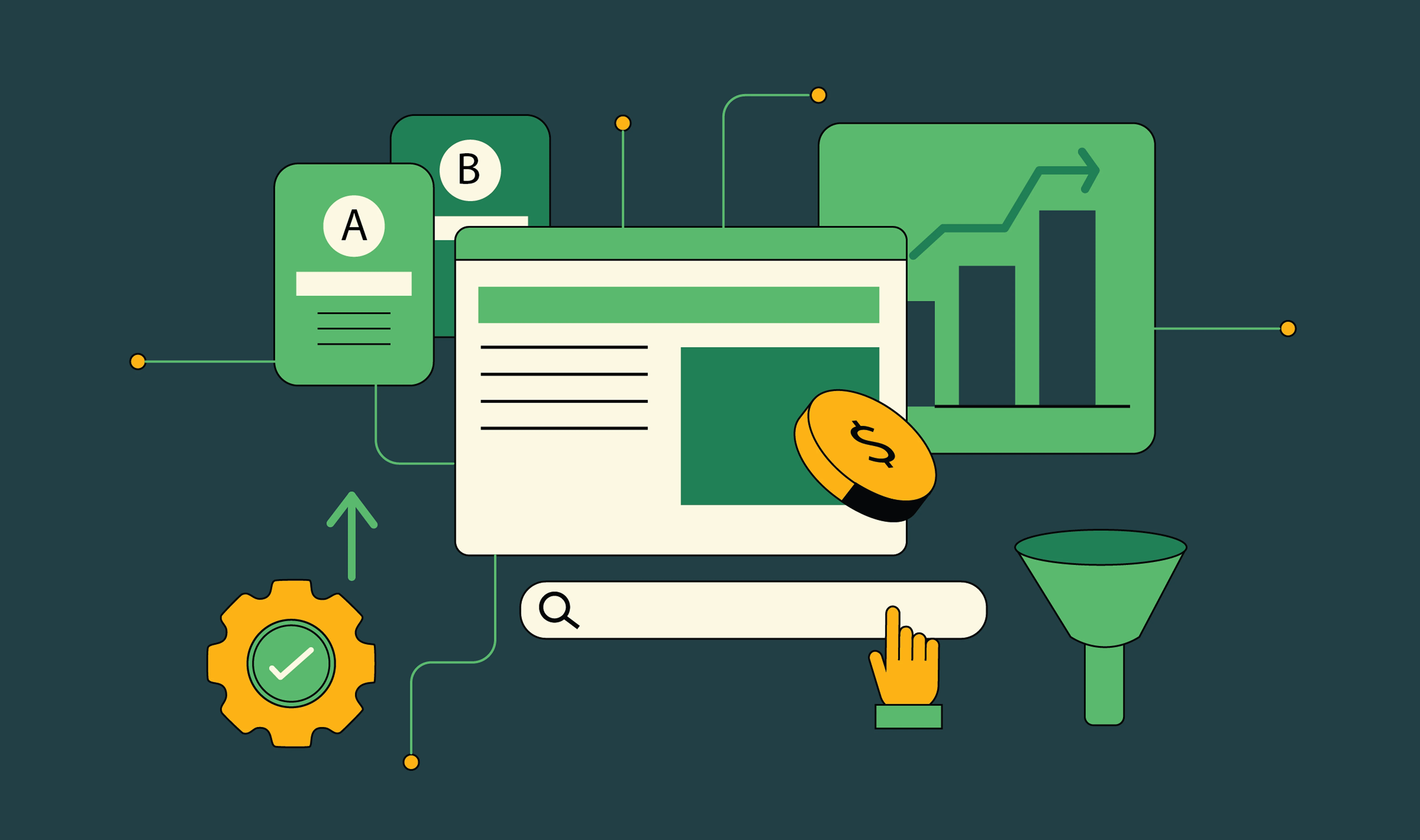
How to Optimize a Landing Page for Maximum ROI: A Step-by-Step Breakdown
If you’re sitting at a 2% conversion rate, you might feel good. After all, you just doubled from 1%. But here’s the reality check: 2% is still below average.
According to recent benchmarks:
- 25% of advertisers struggle with conversion rates under 1%.
- The median conversion rate sits at 2.35%.
- The top 25% push past 5.31%.
- And the top 10% hit 11.45% or higher.
That means if you’re cruising at 5%, you’re ahead of most SaaS competitors. But you still have massive room to grow. The top performers are aiming for 10%, 20%, or even higher.
And the lever that gets you there? Landing page optimization.
At ThunderClap, we’ve worked on 129+ B2B websites like Amazon, Razorpay, and Storylane to optimize their websites and boost conversions. In this guide, we’ll show you how to systematically optimize your landing pages with proven frameworks, case studies from companies like Notion, ClickUp, and Storylane, and a look at how AI is reshaping CRO.
If you’re ready to move out of the average bucket and into the top tier of performers, keep reading.
TL;DR
Landing page optimization can lower your CAC, boost conversions, and directly impact ROI. Here’s how we do it at ThunderClap:
- Pick one goal per landing page (free trial, demo booking, etc.).
- Write a headline focused on outcomes, not features.
- Put social proof above the fold (logos, reviews, badges).
- Simplify to one CTA (don’t overwhelm your visitors).
- Personalize with AI or user data (distinguish first-time vs. returning visitors).
- Test headlines and CTAs with a structured roadmap.
- Link optimizations to ROI metrics like CAC, LTV, and payback period.
- Build a testing roadmap. Start with messaging, CTAs, and high-leverage elements.
- Use the right tools: Unbounce, Instapage, VWO, and Optimizely to design, test, and personalize landing pages.
- Explore AI for CRO: Tools like Mutiny, Clearbit, and Drift enable dynamic personalization, predictive testing, and conversational landing pages for faster, smarter optimizations.
- And we’re learning from SaaS leaders like Notion, ClickUp, and Storylane.
Why Landing Page Optimization Matters for ROI
How much are you spending every month to drive traffic to your site? Google Ads. LinkedIn campaigns. SEO content. Now, how many of those hard-won clicks are dropping off because your landing page isn’t doing its job?
Landing page optimization is the rare growth lever that drives efficiency, cash flow, and growth velocity at the same time.
We saw this firsthand when we worked with Storylane on their website revamp.
- Total conversions up 22%
- Conversions per user up 19%
Here’s the before-and-after look.
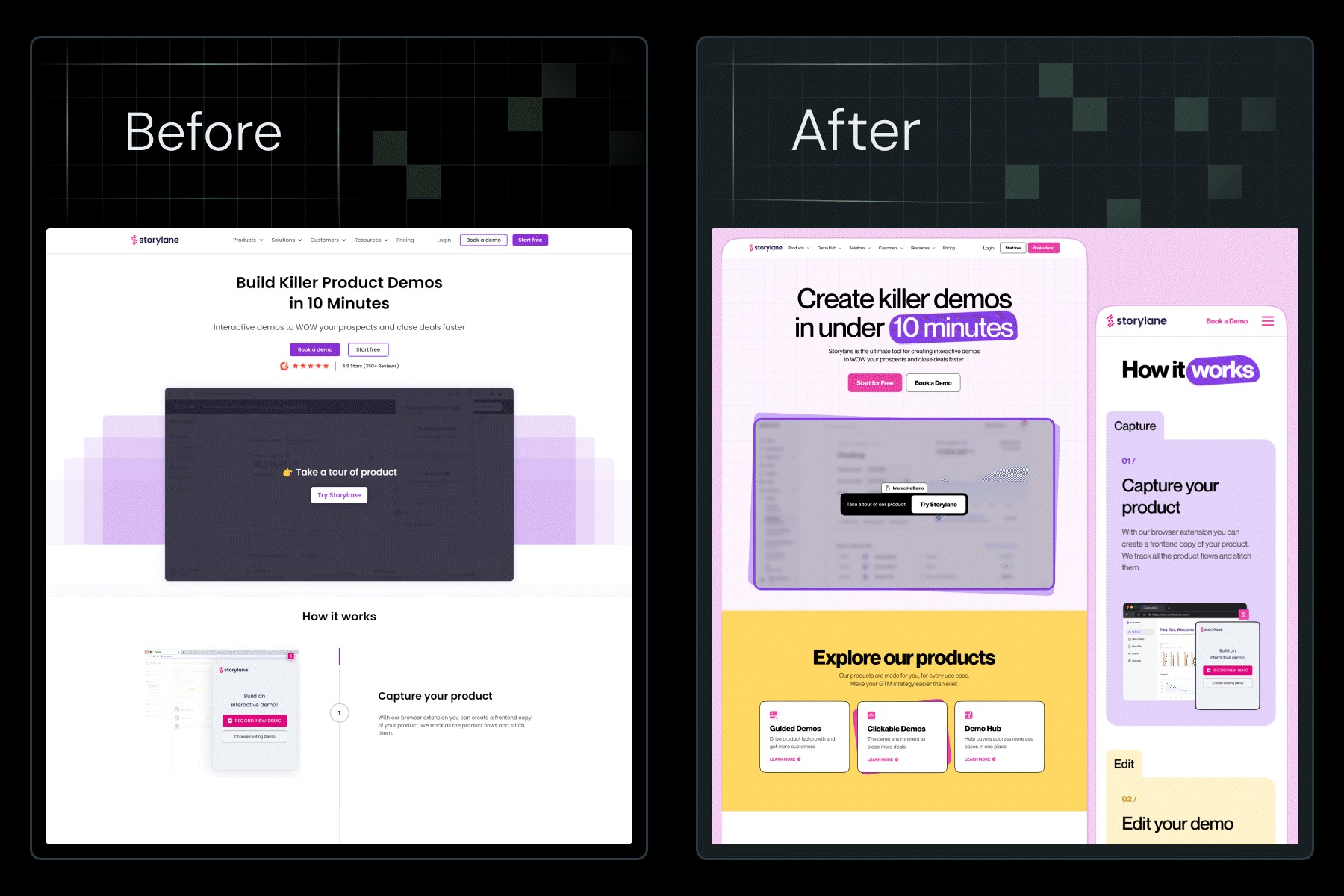
Here’s how landing page optimization ties directly to SaaS growth metrics:
1. You can cut your CAC without spending more
CAC (Customer Acquisition Cost) = Marketing Spend ÷ New Customers.
If you spend $100,000 on paid ads and convert at 3%, you acquire 300 customers → CAC = $333. Improve conversion to 6%, and suddenly you acquire 600 customers → CAC = $166.
You didn’t increase spend (you just halved CAC).
2. You speed up payback and free up cash
SaaS companies live or die by how fast they recoup CAC. SaaS companies live or die based on how fast they recoup their CAC. A faster payback means more cash to reinvest in growth. With a reduced CAC, the payback period shortens, allowing you to reinvest that cash in growth without raising funding.
3. You build more pipeline from the same traffic conversions
Every % increase in conversion compounds across the funnel. An extra 2% lift on a landing page driving 50,000 monthly visits = 1,000 more trial sign-ups → even if only 20% convert to paid, that’s 200 new customers/month.
Over a year, that’s 2,400 extra customers without buying more traffic.
Cool, the math checks out. But the real question is: what can you actually do about it?
Landing page optimization for SaaS can feel like whack-a-mole if you chase small tweaks. You can stay really busy running micro-tests (tweaking button colors, swapping stock photos, or shuffling page sections), but busy doesn’t always mean better.
The real growth comes from big, high-leverage optimizations. Let’s dive into the step-by-step playbook that actually moves your numbers for our 78+ clients across various domains, including B2B SaaS, VC funds, FinTech, and AI.
Step 1: Define the single job the page must do
Before you tweak a headline or test a button color, you need clarity: What is the primary purpose of this page?
Here’s a quick gut-check: if I landed on your page right now, would I immediately know the one action you want me to take?
Too many SaaS landing pages try to do everything on one page: get trial sign-ups, capture newsletter emails, book demos, AND push a webinar. The result is confusion and diluted conversions.
One of the things we do at ThunderClap is help clients like roommaster and Z47 set one specific goal for each landing page. Here’s how we think about it:
Framework #1: SaaS Landing Page Goal Matrix
| Funnel Stage | Primary Goal | Example CTA | Why It Works |
|---|---|---|---|
| TOFU (Awareness) | Lead capture | Download the 2025 SaaS Growth Report | Low friction, nurture audience |
| MOFU (Consider) | Free trial sign-up | Start for Free | Quick product experience |
| MOFU/BOFU | Demo booking | Book a Demo | Tailored for enterprise |
| BOFU (Decision) | Paid sign-up/upgrade | Upgrade Now | Direct conversion |
Case in point is Notion, a SaaS brand often studied in B2B web design best practices.
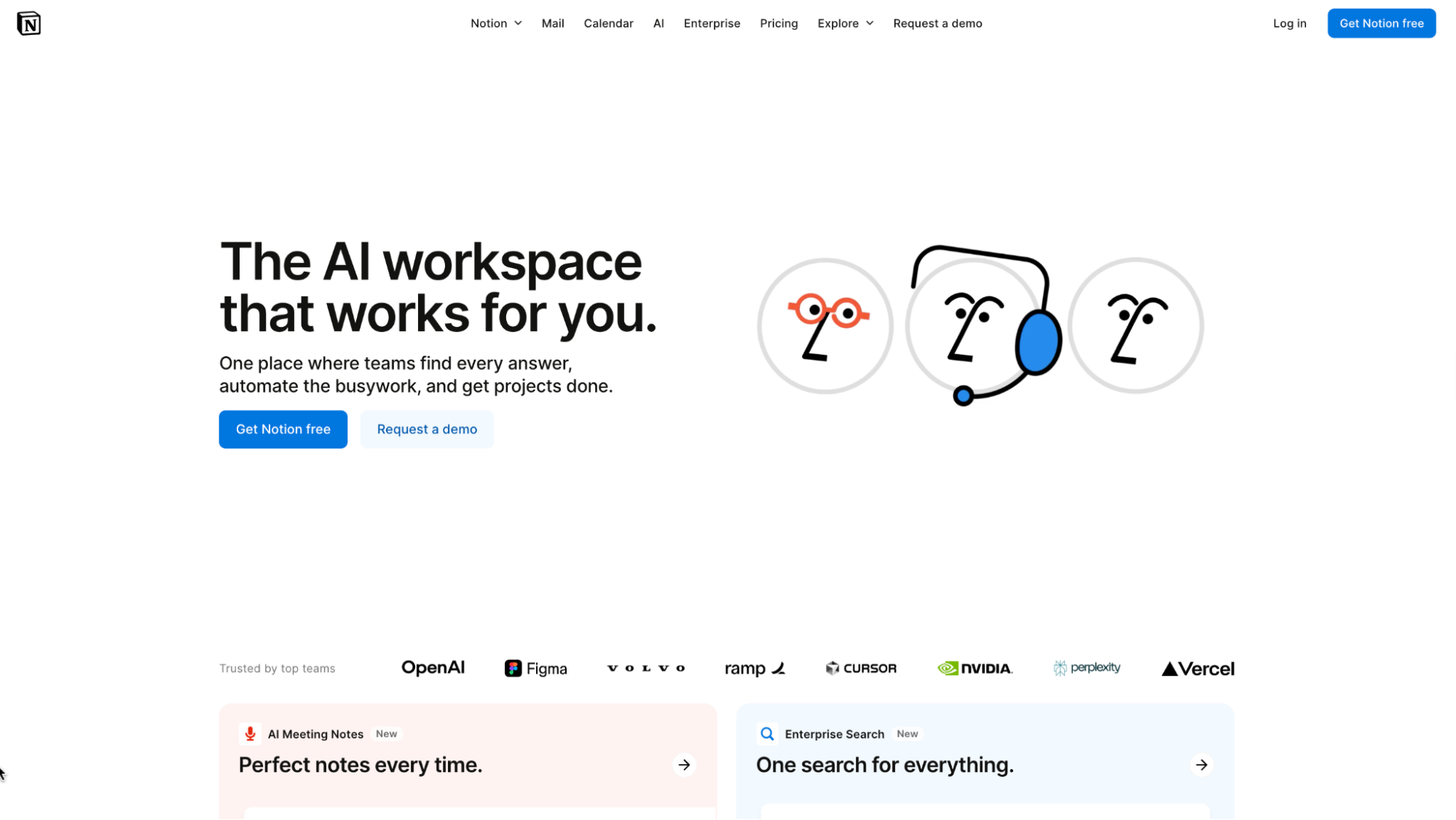
Notion’s earlier site offered multiple navigation paths and CTAs that could pull visitors in different directions. Their current homepage emphasizes one bold primary CTA: Get Notion free. In a PLG (product-led growth) model, one clear CTA reduces friction and drives people directly into the product experience.
- Do a website audit and define ONE goal per landing page.
- Write it at the top of your CRO doc: “This page exists to get [X outcome].”
- Remove or de-prioritize any CTA that doesn’t serve that goal.
Step 2: Create a Headline That Speaks to Outcomes, Not Features
When you land on a SaaS page that says “The #1 project management tool”, do you feel compelled to sign up? Probably not.
Your headline is the make-or-break moment. Visitors decide in 3–5 seconds if they’ll stick around. Don’t waste it describing what your product is. Use it to show what your product does for them.
Here’s how to rewrite your feature-first headline (descriptive) to an outcome-first headline (persuasive).
Framework #2: Headline Value Formula
| Feature-First (Weak) | Outcome-First (Strong) | Why It Works |
|---|---|---|
| Team collaboration software | Cut project delivery time by 30% with X | Ties to ROI (time saved) |
| “All-in-one CRM” | Close deals 25% faster with X CRM | Quantified business impact |
| Business Messenger | Convert more visitors into customers with X | Revenue-focused |
How to write high-ROI headlines:
- Step 1: Identify your product’s biggest outcome (e.g., reduce churn, accelerate pipeline).
- Step 2: Add a timeframe or proof point (or both).
- Step 3: Add audience context.
As Ayush Barnwal, Founder at ThunderClap, lays out in our 8-step copywriting framework for high-converting landing pages, a great copy is a checklist, not inspiration.
Rewrite your headline using this formula:[Outcome] + [Proof/Timeframe] + [Audience]. Example: Reduce churn by 25% in 90 days with AI-driven insights for SaaS.
Once your headline and copy hook them, you need to prove you’re legit. That’s where social proof comes in.
{{specficBlog}}
Step 3: Social proof to meet trust where people look
Your visitors don’t believe you. They believe your customers.
If your landing page doesn’t show logos, testimonials, or reviews above the fold, you’re forcing people to take a leap of faith. And most won’t.
Our social proof pyramid shows how we prioritize what to show:
Framework #3: Social Proof Pyramid
| Level | Example | SaaS Example | Why It Works |
|---|---|---|---|
| Basic | Customer logos | ClickUp → Sephora, Datadog, AT&T logos | Instantly credible |
| Strong | Testimonials with outcomes | Basecamp → 30 pages of customer testimonials | Specific ROI proof |
| Stronger | Third-party badges | Factors.ai → G2 Leader badges & reviews | Independent validation |
| Strongest | Case studies with numbers | Salesforce → Over 150,000 companies, both big and small | Hard data convinces |
ClickUp Brain's landing page nails this landing page optimization strategy.
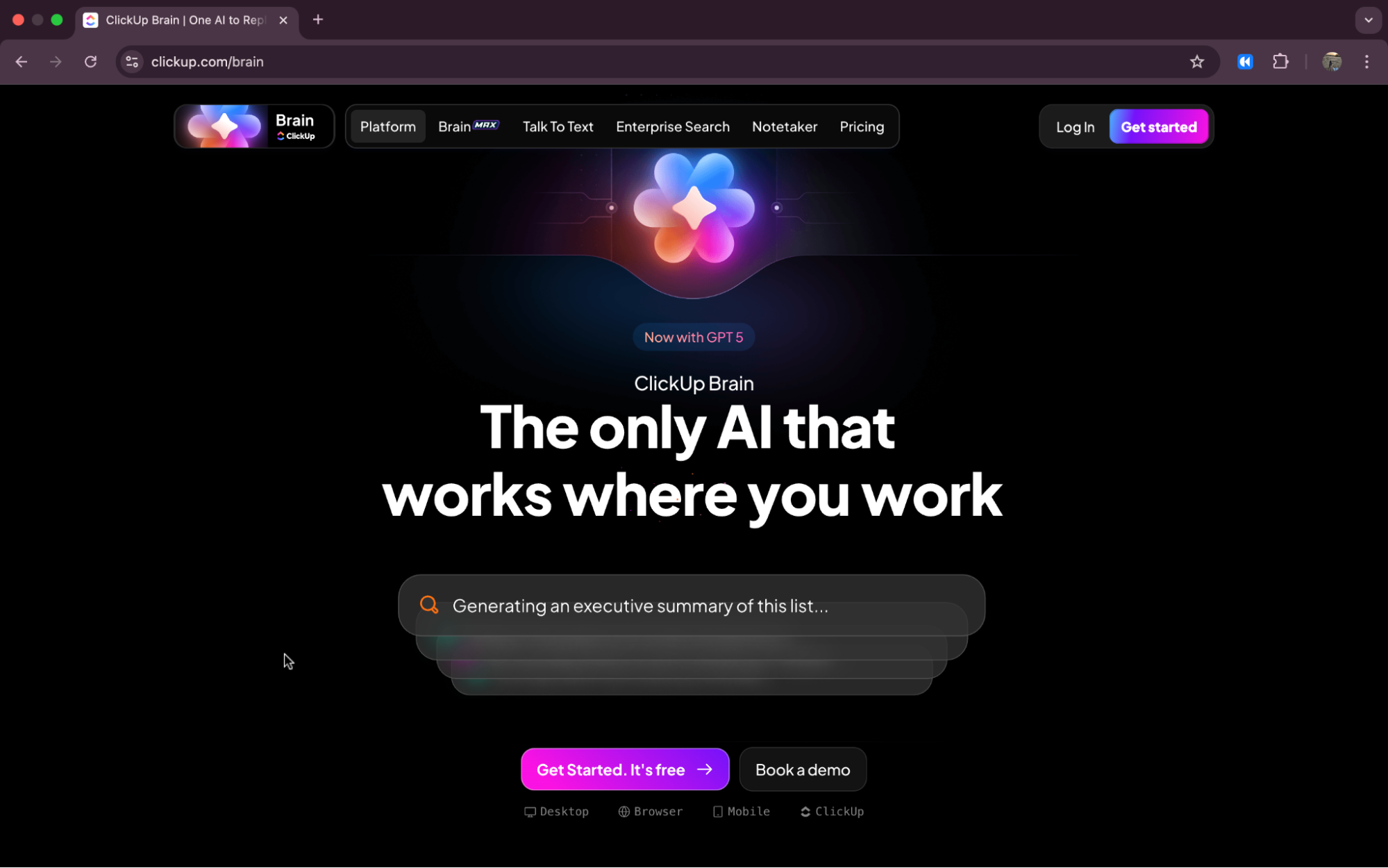
Here’s what they’re doing right to optimize landing pages for conversions:
- Bold differentiator (The only AI that works with your work).
- Clear guarantee (Save 1 day per week, guaranteed).
- Stacked logos (IBM, Booking.com, Logitech) + 150,000+ companies.
- Quantified ROI stats: 88% cost savings, 1.1 days saved/week, 3x faster tasks.
- Relatable proof (named Deadline Guardian and Content Reviewer).
- Enterprise trust badges (GDPR, HIPAA, ISO, SOC 2).
- Dual CTAs (Get Started Free + Book a Demo) for both self-serve and enterprise buyers.
- Audit your LP. Ask: Does a visitor see evidence above the fold within 5 seconds?
- Place logos/testimonials above the fold.
- Use quantified ROI (Cut costs by 18%), not vague praise (We love it).
Step 4: One CTA, then be obsessive about placement
One of the most common mistakes we see clients make? Too many CTAs. Visitors get paralyzed when asked to choose. But landing pages with a single CTA convert at 13.5%, while those with 2–4 CTAs convert at only 11.9% We learned this pattern from multiple website revamps, too.
Here’s the CTA hierarchy we use for our clients at ThunderClap:
Framework #4: CTA Hierarchy
| CTA Type | Placement | Example Text | SaaS Example | Best Practice |
|---|---|---|---|---|
| Primary | Hero, sticky nav | Start Free Trial | Notion | Clear & bold |
| Secondary | Footer, sidebar | Request a Demo | HubSpot | Subtle option |
| Tertiary | Blog/resource links | Learn More | Intercom | Minimal |
- Every landing page should feel like it’s guiding visitors down a single, obvious path.
- Make the primary CTA impossible to miss. Use benefit-driven text (“Start saving time today”) instead of “Submit.”
- Test CTA placement (hero vs. mid-page).
If you run demos, use ThunderClap’s High-Converting Demo Page Playbook. We studied 30 B2B SaaS brands to find landing page optimization strategies that leading brands are using on demo pages (value ladder, what reps need, checklist for book demo pages).
Inside the 39-page ebook, you'll find landing page optimization best practices, an editable wireframe you can use to create a high-converting demo page for your SaaS brand, and 3 ready-to-use prompts to craft a perfect headline for your demo landing page
Step 5: Personalize with simple firmographics, then scale with AI
Say you’re evaluating a SaaS tool. You visit the landing page twice. The first time, you’re just browsing. Second time, you’re ready to book a demo. But the page looks exactly the same.
Frustrating, right?
No wonder personalized landing pages convert 202% better than generic ones.
Framework #5: SaaS Landing Page Personalization Tiers
| Tier | Personalization Type | Example | Why It Works |
|---|---|---|---|
| Basic | Industry-specific copy | Project management for Agencies vs. Project management for Startups | Quick, lightweight edits that make content instantly relevant. |
| Mid-Level | Firmographic (size, geo, role) | Plans built for SMBs vs. Solutions trusted by Enterprise teams | Aligns offers with company size, geography, or role priorities. |
| Advanced | Behavioral + AI-driven | First-time visitor → Start Free Trial Returning visitor → Book a Demo |
Matches intent in real time, guiding users toward the next logical step. |
- Start with easy wins like industry-based copy.
- Then scale to real-time personalization with AI.
Use dynamic proof (e.g., industry-specific testimonials).
Step 6: Build a testing roadmap
Testing is where hypotheses become growth.
Most SaaS teams fall into one of two traps:
- They don’t test at all (they launch a page and leave it untouched for months).
- Or they test the wrong things (button color, microcopy) instead of high-impact elements like messaging and CTAs.
The way out is building a testing roadmap. And when Saas teams commit, they have recorded up to 75% higher conversions through CRO.
At ThunderClap, we keep a ranked backlog and run one major hypothesis per sprint for our clients. We document winners and why they won. This is how knowledge compounds across projects (we’ve used the same lessons across dozens of clients).
You too can implement our testing pyramid. Start at the top of the pyramid (messaging and CTAs). Once you nail those, move down to design details and layout.
| Tier | Focus Area | Example Test | Priority |
|---|---|---|---|
| 1 | Messaging | Headline variations | High |
| 2 | Conversion drivers | CTA copy/placement | High |
| 3 | Supporting assets | Images, trust signals | Medium |
| 4 | Structure | Pricing layout, nav menus | Low |
One of our recent revamp projects for Z47, one of India’s leading VC funds, shows exactly how applying this blueprint to messaging, structure, and supporting assets can transform both the experience and the results.
Here’s a step-by-step of what we did for Z47:
- Ran a comprehensive website + analytics audit to identify drop-offs, weak engagement, and missed trust signals.
- Conducted a competitor scan to benchmark positioning and site structure.
- Recrafted messaging around “founders first” to build trust.
- Designed wireframes with a single purpose per page to eliminate clutter.
- Built stylescapes and mood boards to align visuals with Z47’s brand book.
- Revamped the site design to be more colorful, elegant, and trust-led (team, portfolio companies, IPs).
- Launched Zero to Infinity content IP hub that positioned Z47 as a thought leader and scaled their content engine.
Here’s how the Z47 homepage evolved before the revamp vs. after applying the blueprint
In just six weeks post-revamp, Z47 saw:
- +59% website traffic
- +54% active users
- +50% engagement
- +121% direct traffic
- +465% social traffic
Don’t waste cycles on vanity tests. Focus on messaging, CTAs, and big levers first.
- Keep a test backlog: Write down every idea, then rank by potential impact vs. effort.
- Test one high-priority element per sprint: Headlines, CTAs, or offers first.
- Run tests long enough to reach statistical significance: Don’t stop early just because you see a spike.
- Document everything: What you tested, what won, and why. That way, your team learns over time instead of repeating mistakes.
Also Read: 20 Proven SaaS Conversion Optimization Hacks to Boost Your Sales
Step 7: Link everything back to $$ (CAC, LTV, payback)
Your CEO doesn’t care that your headline test boosted conversions by 4%. They care that it lowered CAC or added $1M in pipeline. If you can’t tie landing page optimization back to money, you’ll never get budget or buy-in.
Here’s a quick helper on reframing CRO metrics into business language:

Talking the talk is important, but you also need to show where the money shows up in the numbers. Here’s the four-metric framework every marketing lead lives by.
Framework #7: ROI Impact Model
| Metric | Formula | Why it matters |
|---|---|---|
| Conversion rate | (Sign-ups ÷ Visitors) × 100 | The direct measure of landing page success |
| CAC (Customer Acquisition Cost) | Marketing Spend ÷ Customers | Shows efficiency (higher conversions mean lower CAC) |
| LTV (Lifetime Value) | ARPU × Avg. Customer Lifespan | Proves the long-term value of customers acquired |
| Payback Period | CAC ÷ Gross Margin per Customer | Tells you how quickly you recover acquisition costs |
If you want bigger budgets and more CRO resources, talk about pipeline, CAC, and payback.
- Always translate % lifts into $ impact. Don’t say “+5% conversion.” Say: “That test added $1.2M in ARR this quarter.”
- Use CAC as your anchor. Report in the language of finance.
- Track LTV on CRO wins (that’s a story leadership loves).
- Close the loop. Don’t just report sign-ups, follow them through the funnel to pipeline and revenue.
Also Read: 5 Tips & Best Practices for Maintaining your WebFlow Website
6 common mistakes in landing page optimization (and how to fix them fast)
Before you optimize, it’s worth calling out the pitfalls most SaaS teams fall into. Kiran audited over 100 SaaS home pages, and the same landing page optimization mistakes keep reappearing.
Chances are, you’ve made one (or more) of these mistakes. Let’s break them down.
1. Treating all traffic the same
Not all visitors arrive with the same intent. Someone clicking from a LinkedIn ad isn’t in the same headspace as someone arriving from a branded Google search. Serving them the same generic landing page is a wasted opportunity.
Fix: Build intent-specific landing pages. One for cold ad traffic, another for high-intent organic, and another for retargeting.
2. Designing for aesthetics, not action
It’s tempting to obsess over “pretty” designs with complex animations or heavy imagery. But what looks slick to you may distract or slow down the user.
Fix: Optimize for speed and clarity first. A landing page should load in under 3 seconds and guide the eye directly to your CTA.
3. Ignoring mobile experience
Too many SaaS landing pages are designed desktop-first and shrink badly on mobile. Long forms, tiny CTAs, or broken layouts drive bounce rates through the roof.
Fix: Design mobile-first. Test every landing page on actual devices. Make CTAs thumb-friendly and forms minimal.
4. Skipping message-match with ads
Ever click an ad promising one thing, only to land on a page that talks about something else? That disconnect kills trust instantly.
Fix:Align landing page headlines, copy, and CTAs exactly with the ad or campaign that drove the click. Message-match is CRO 101 (but it’s still widely ignored).
5. Relying too heavily on templates
Using pre-built landing page templates is fine for speed, but if you never customize beyond swapping in your logo and headline, your page will blend in with every other landing page out there.
Fix:Use templates for structure, but invest in custom messaging, visuals, and proof elements that reflect your brand’s unique positioning.
6. Failing to refresh proof and content
Outdated proof hurts credibility. Logos from 2019, old review badges, outdated product screenshots, these small signals scream stale to visitors.
Fix:Refresh logos, testimonials, and screenshots at least once per quarter. Treat your landing page like a living product, not a one-off project.
5 landing page optimization tools for SaaS teams
If you’ve ever searched for “best landing page optimization tools,” you know there are dozens of platforms promising to boost conversions, run experiments, and personalize your pages.
But you don’t need every tool under the sun. What you need is a lean, reliable toolkit that helps you design, test, and scale landing page optimization.
Think of this list as your starting stack:
- Unbounce → Great for building and A/B testing landing pages without dev help. Drag-and-drop + dynamic text replacement for personalization.
- Instapage → Advanced features like heatmaps, multivariate testing, and ad-to-page personalization.
- VWO → Best for structured CRO programs. Offers testing, heatmaps, session recording, and ROI reporting.
- Optimizely → Enterprise-level experimentation platform. Ideal for SaaS teams with high traffic.
- Google Optimize (sunset in 2023, but replaced by GA4 experiments) → Still worth mentioning as part of GA4’s experimentation suite.
Pro Tip: Pick one tool for building (Unbounce/Instapage) and one for testing (VWO/Optimizely). This gives you both speed and structure.
The future: what AI will change in CRO
AI is quietly reshaping how SaaS teams build and optimize landing pages for conversions. What used to take weeks of manual work (brainstorming copy, setting up tests, waiting for significance) is starting to happen in hours.
Recent studies show that AI integration can lift conversion rates by as much as 30%. HubSpot, for example, saw a 10–15% conversion increase after implementing AI-driven personalization across landing pages.
So if you’re not thinking about how AI fits into your CRO process, you’ll soon be outpaced by competitors who are.
Here’s what’s already changing (and where we’re heading in the next 2–3 years):
1. AI-driven personalization at scale
Tools like Mutiny and Clearbit already let you swap copy based on firmographic data (industry, company size, even tech stack). The next wave goes further: AI will automatically adjust headlines, CTAs, visuals, and even pricing emphasis in real time based on who’s visiting and what stage they’re in.
2. AI-powered copy + design testing
If you’ve ever spent a week writing five headline variations, only to watch them flop, this one will hit home. AI can now generate dozens of on-brand headlines, CTAs, and layout variations in minutes.
Instead of creative bottlenecks, you’ll be able to test 50 angles at once (with AI not only writing the copy but also predicting which ones have the highest chance of winning before they even go live). That means faster cycles, less guesswork, and a pipeline of fresh experiments ready every sprint.
3. Predictive CRO
Today, you might run an A/B test for weeks waiting for statistical significance. By then, you’ve burned your budget and lost time. Using behavioral data (scroll depth, time on page, click patterns), AI can predict winners in days, not weeks. That means you can kill underperforming variations quickly and double down on winners faster.
4. Voice & conversational landing pages
Static forms are one of the biggest drop-off points in SaaS funnels. Nobody likes filling out 12 fields just to see a demo. AI-powered chat (like Drift) is already replacing forms with conversational flows that feel natural.
The future is landing pages where visitors talk (by text or voice) and the page adapts in real time.
What does this mean for you?
The rise of AI doesn’t mean you stop optimizing (it means your role evolves). Marketing teams that embrace AI will out-test, out-learn, and out-convert their competitors. The question is whether you’ll be leading that curve… or trying to catch up.
Want to put this into practice without boiling the ocean? Here’s a quick starter stack of AI-powered CRO tools you can try today:
Your AI CRO Starter Stack
| Use Case | Tool | Why It’s Useful |
|---|---|---|
| Personalization at scale | Mutiny, Clearbit | Dynamically swap headlines, CTAs, and visuals based on firmographic or visitor data. |
| AI copy + design testing | Copy.ai, Jasper | Generate dozens of on-brand variations for headlines, CTAs, and layouts in minutes. |
| Predictive CRO | VWO with AI insights, Optimizely AI | Use behavioral data to predict winners faster and reduce wasted test cycles. |
| Conversational landing pages | Drift, Qualified | Replace static forms with AI-driven chat that adapts content and CTAs in real time. |
Pro tip: You don’t need to adopt everything at once. Start with one personalization tool (like Mutiny) and one AI copy/testing tool (like Jasper). That’s enough to give you quick wins without overwhelming your stack.
Your landing page optimization journey: do it yourself or let ThunderClap take you further
You now have a battle-tested step-by-step guide on how to optimize your landing pages. If you’ve got the time and resources, you can absolutely start on your own.
DIY Landing Page Optimization Checklist
- Define one clear goal for the page (trial, demo, lead).
- Write an outcome-first headline that ties to ROI.
- Put logos/testimonials above the fold.
- Stick to one strong CTA (don’t overwhelm).
- Personalize copy for industry, size, or returning visitors.
- Test messaging + CTAs first (not colors).
- Refresh proof quarterly (logos, reviews, screenshots).
- Track results in CAC, LTV, and payback.
Even these small changes can deliver quick wins.
But most teams we work with hit a ceiling. DIY gets you part of the way there. Then the tests stall, the design gaps show, and the results plateau. Scaling CRO into a reliable growth engine takes structured playbooks, design + dev muscle, and experience knowing what works across industries.
At ThunderClap, we’ve optimized 129+ B2B websites, partnering with mid-market SaaS brands and enterprises like Amazon, Razorpay, and Storylane. Their challenges are always familiar: unclear positioning, low conversions, and a site that doesn’t match the maturity of the company.
{{ctaBlock}}
What we bring to the table is a proven expertise in having it done across industries, helping clients double demo signups, cut CAC, and reposition themselves as category leaders.
If you’re ready to make your landing page your #1 salesperson, we’d love to show you how. Let’s audit your current funnel, pinpoint where the leaks are, and build a roadmap that gets measurable results in weeks, not months. Book a 30-minute demo!
FAQs
1. What are the best landing page optimization strategies for SaaS?
The best landing page optimization strategies include setting one clear conversion goal, writing outcome-focused headlines, showcasing social proof above the fold, simplifying CTAs, and running structured A/B tests. SaaS leaders like Notion and HubSpot use these approaches to improve conversions.
2. How do I optimize landing pages for conversions?
To optimize landing pages for conversions, focus on clarity and trust. Reduce CTA overload, personalize experiences for different segments (SMB vs. enterprise), and test messaging elements like headlines. Adding trust signals like customer reviews and G2 badges can significantly lift conversions.
3. What are SaaS landing page optimization best practices?
Best practices for landing page optimization for SaaS include:
- Clear single CTA
- Outcome-driven headline
- Social proof above the fold
- Personalized content by audience/region
- Continuous A/B testing with a roadmap
These practices ensure SaaS landing pages maximize ROI.
4. How do I measure ROI from landing page optimization?
Link landing page performance to financial metrics: CAC (Customer Acquisition Cost), LTV (Lifetime Value), and payback period. For example, if your conversion rate doubles from 3% to 6%, your CAC is cut in half (directly boosting ROI).
5. What tools help with landing page optimization for SaaS?
Popular landing page optimization tools for SaaS include Unbounce, Instapage, VWO, Optimizely, and HubSpot CMS. These platforms help run experiments, track conversions, and personalize landing pages for maximum ROI.
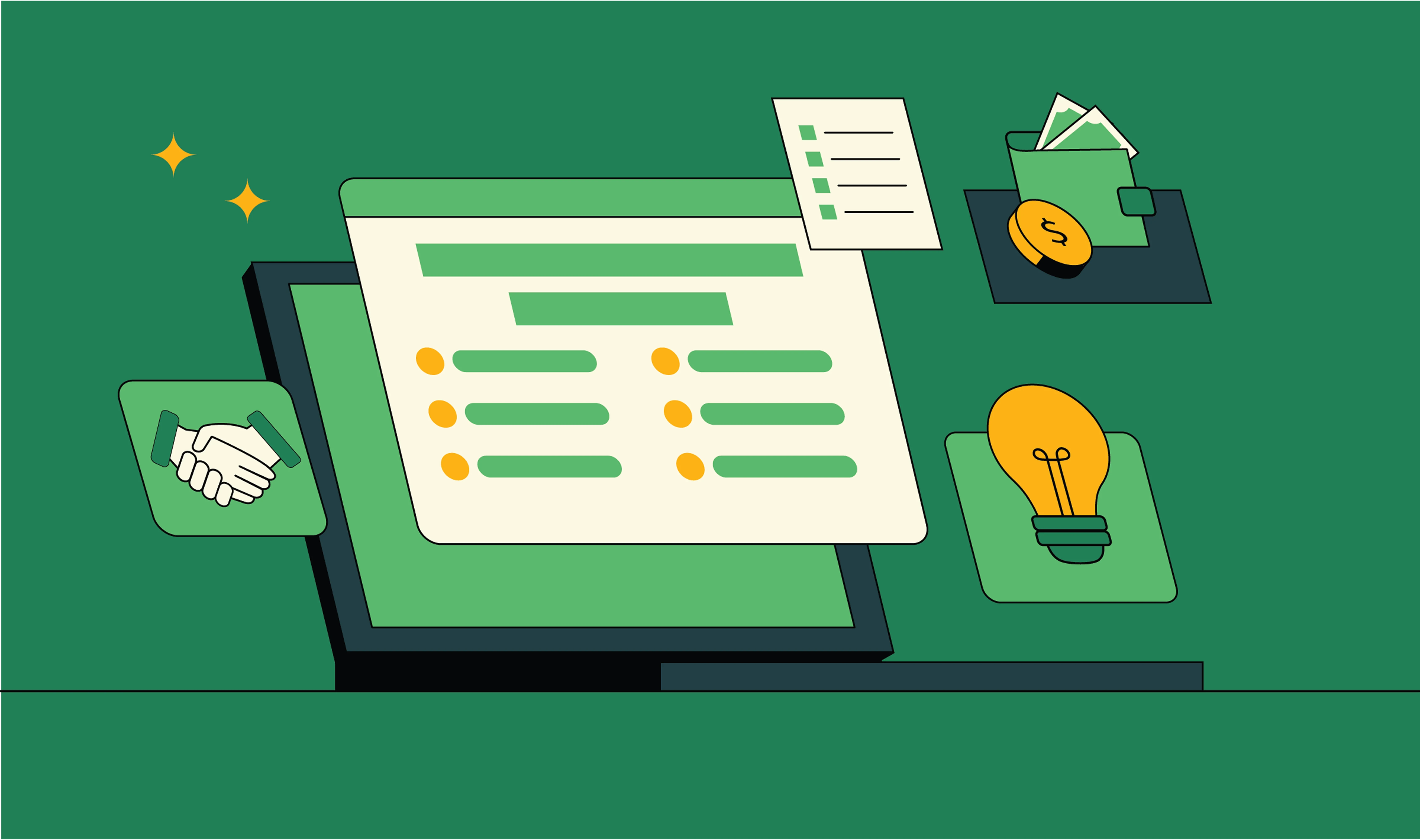
Top 10 B2B Branding Agencies in India in 2025
Your competitors use the same stock photos, speak the same corporate jargon, and chase the same tired positioning.
Meanwhile, breakthrough B2B brands cut through the noise like lightning through fog - commanding attention, decisions, and markets while everyone else fights for scraps.
At ThunderClap, we watch this transformation daily. We partner with B2B companies globally, and the difference between winning and losing comes down to one thing: brand positioning that makes prospects choose you before they evaluate anyone else.
India's B2B market explodes with opportunity 1.3 million startups compete for enterprise attention while established companies scramble to stay relevant. Smart brands leverage this chaos - they position, communicate, and execute.
This guide features the top B2B branding agencies in India that understand business-to-business marketing. These aren't just creative studios; they're partners who build brands that sell, scale, and sustain growth.
Why B2B Branding Matters More Than Ever in 2025
B2B buyers have changed. 83% of B2B buyers now research solutions online before talking to sales, and the rest start with generic searches rather than branded terms. Your brand needs to capture attention, build trust, and differentiate your solution before you ever get a chance to present.
As we detail in our B2B Branding Strategies guide, effective B2B branding requires understanding buyer journeys, multiple touchpoints, and purchase decisions backed by trust.
Top 10 B2B Branding Agencies in India
We analyzed over 30 branding agencies across India based on B2B expertise, client results, approach, and proven track record. Here are the 10 agencies that earned spots on our list:
1. ThunderClap

Best for: B2B SaaS, Tech, and Enterprise companies needing conversion-focused branding
Notable Clients: Amazon, Razorpay, Z47, Storylane, Roommaster, Shopline, Deductive.
ThunderClap leads our list because we specialize exclusively in B2B branding that brings measurable results. As recipients of Webby Awards and CSS Design Awards, they bring brand thinking with conversion-focused execution.
Core strengths:
- Brand Strategy & Positioning: Starting with deep market research and competitive analysis to identify positioning opportunities. We have a strategic framework that includes brand architecture, messaging hierarchy, and value proposition development, all of which speak directly to B2B buyers. Product clarity is paramount for us. We make your B2B products unforgettable (what a Marketer wants at the end of the day).
- Conversion Design: The design team creates visual systems that guide prospects through your sales funnel. Every design decision connects to conversion goals, from color psychology to layout optimization.
- Webflow Development: Brand building that performs across all touchpoints. Their Webflow expertise ensures your brand translates perfectly into high-performance websites that convert visitors into leads.
- CRO + Growth Support: Brand development doesn't end at launch. They also provide ongoing optimization, A/B testing, and performance tracking to ensure your brand investment generates sustained returns.
Proven Case Studies:
Storylane: Helped this sales demo platform establish category leadership through branding and website redesign.
Amazon: Pulled off a new website for their sitebuilder GTM to support the SME’s of India who sell on Amazon.
Additional expertise includes:
- SaaS Design Agency: Specialized branding for software companies with 57+ successful redesigns
- Fintech Design: Financial technology branding that builds trust and adoption
- Enterprise Solutions: Large-scale brand transformations for established B2B companies
Services: Brand Strategy, Visual Identity, Website Design, Copywriting, Brand Guidelines, Ongoing Optimization
Investment: Custom pricing based on scope and business goals.
“As an early-stage company, we needed a clear brand identity and messaging before launching. ThunderClap delivered exactly that! Concise, impactful copy and branding that feels right.” - Karan Mehta, Founder, Rezolv
2. Zensciences
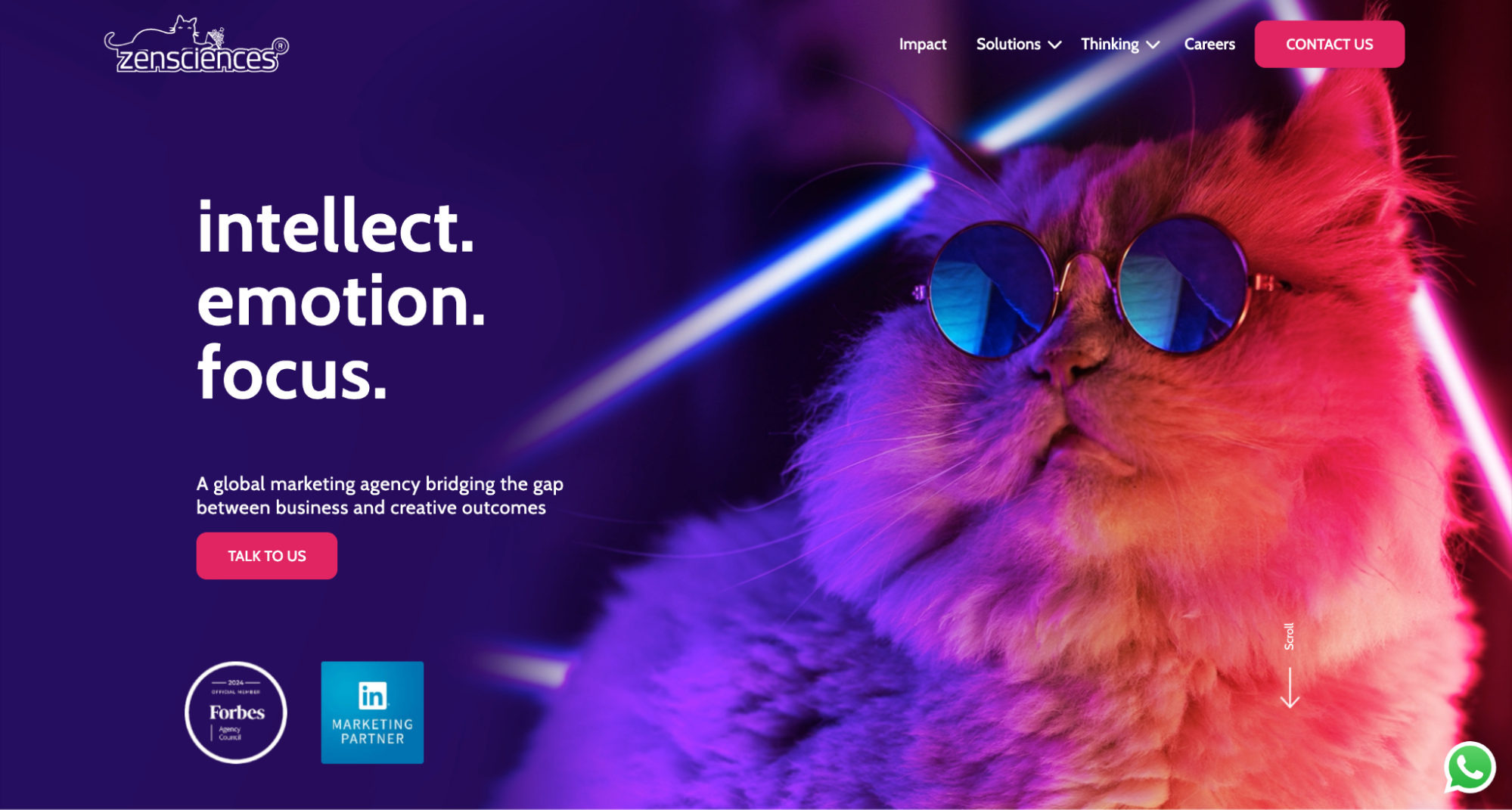
Best for: Enterprise B2B companies
Notable Clients: Walmart, L&T
Zensciences stands out as an award-winning B2B branding agency that combines branding with digital marketing strategy. They specialize in B2B turnarounds for large enterprises and fast-growing scale-ups.
Their approach integrates brand positioning with UX/UI design. Zensciences particularly excels at rebranding established B2B companies that need to modernize without losing existing equity.
Core strengths:
- Enterprise-grade brand transformations
- Integration of branding with digital strategy
- Global experience across multiple markets
- UX/UI design
Services: Brand Strategy, Digital Transformation, UX/UI Design, Marketing Strategy
Investment: $100,000 to $150,000
3. Langoor Digital
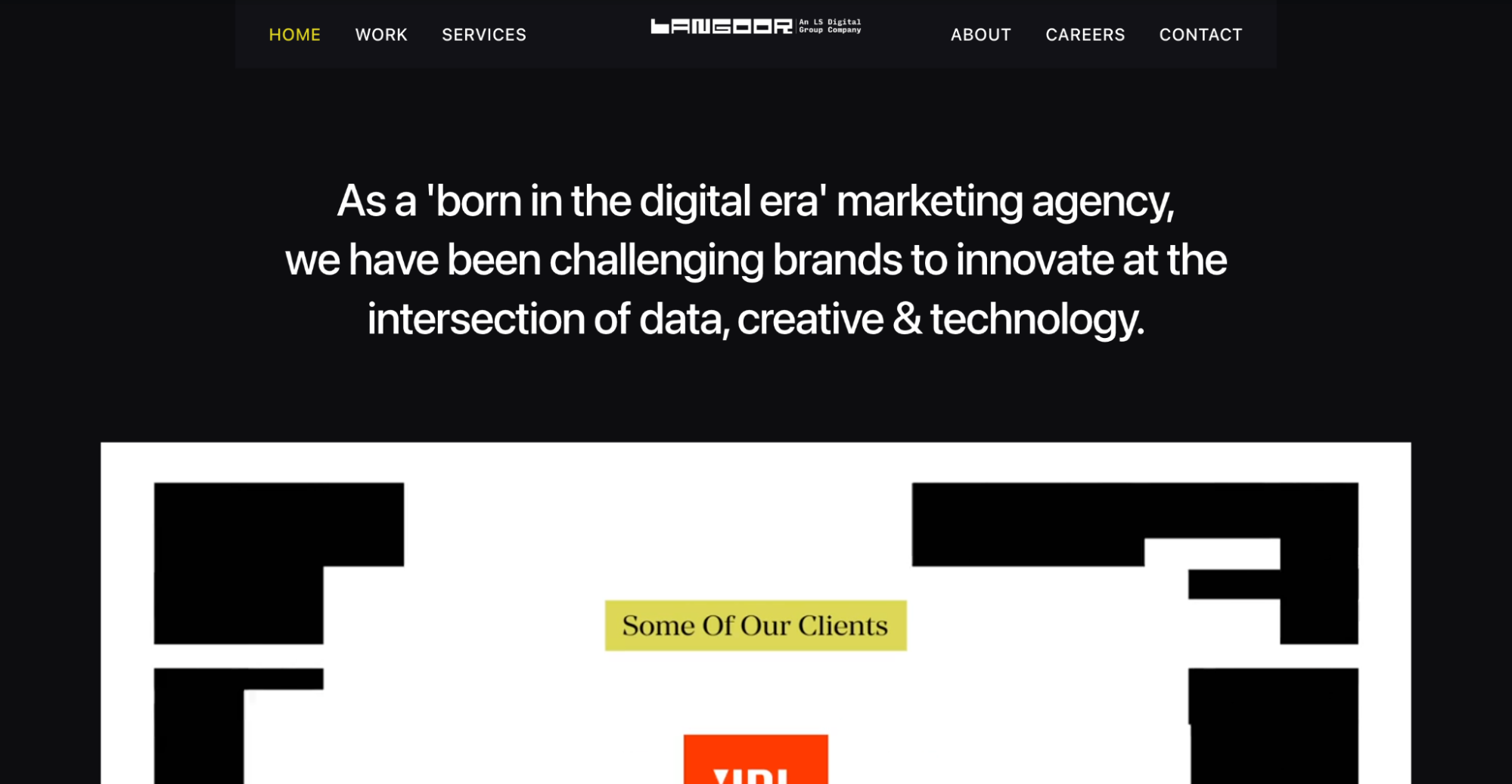
Best for: Enterprise B2B companies
Notable Clients: Unilever, Lenovo Infrastructure, Epson, Wipro, Krispy Kreme
Langoor Digital specializes in helping established enterprises modernize their brand presence while maintaining market authority and customer trust.
Their unique strength lies in managing multi-brand portfolios for global enterprises. Langoor particularly stands out for digital brand upgrades that require advanced marketing automation and AI-driven personalization.
Core Strengths:
- Global enterprise experience with Fortune 500 companies
- Technology integration expertise (AI, AR, marketing automation)
- Multi-brand portfolio management capabilities
- International market expansion support across APAC, the Middle East
Services: Digital Brand Strategy, Marketing Automation, Enterprise Web Development, Performance Marketing
Investment: $50,000 to $150,000 for comprehensive enterprise transformations
4. Monaqo
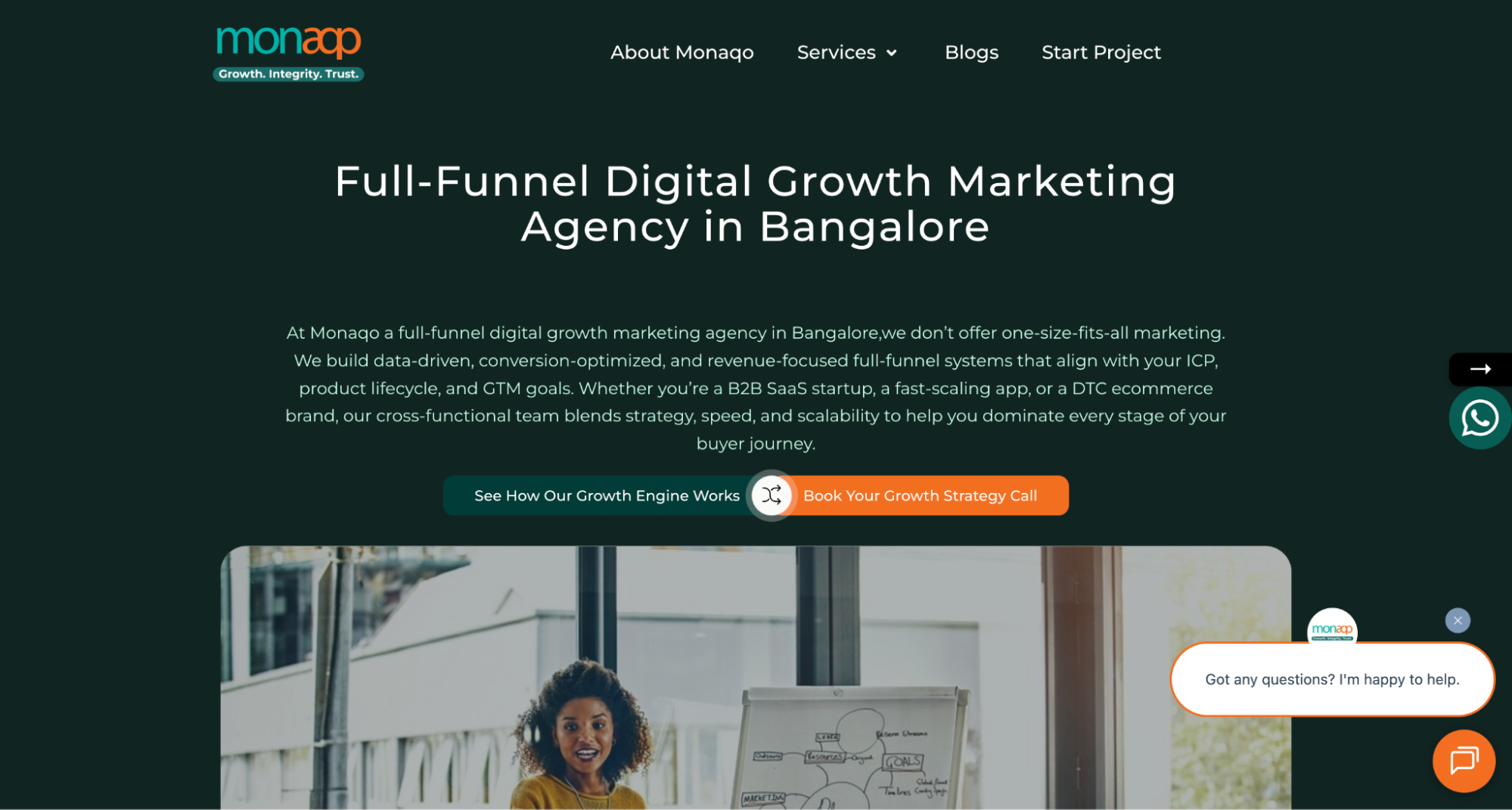
Best for: B2B SaaS and tech companies
Notable Clients: Various B2B technology companies
Monaqo positions itself as an elite B2B branding agency in India that engineers market-dominant brands. They work in positioning with visual design to create brands that sell, scale, and stick in buyers' minds.
Their MoatCraft Positioning System identifies market white space and competitor messaging gaps to create differentiation.
Core Strengths:
- MoatCraft Positioning System for strategic differentiation
- Focus on brand identities that attract buyers
- Integration of brand positioning with sales enablement
Services: Brand Strategy, Visual Identity, Brand Guidelines, Sales Collateral, Brand Videos
Investment: $8,000 to $25,000
5. TripleDart
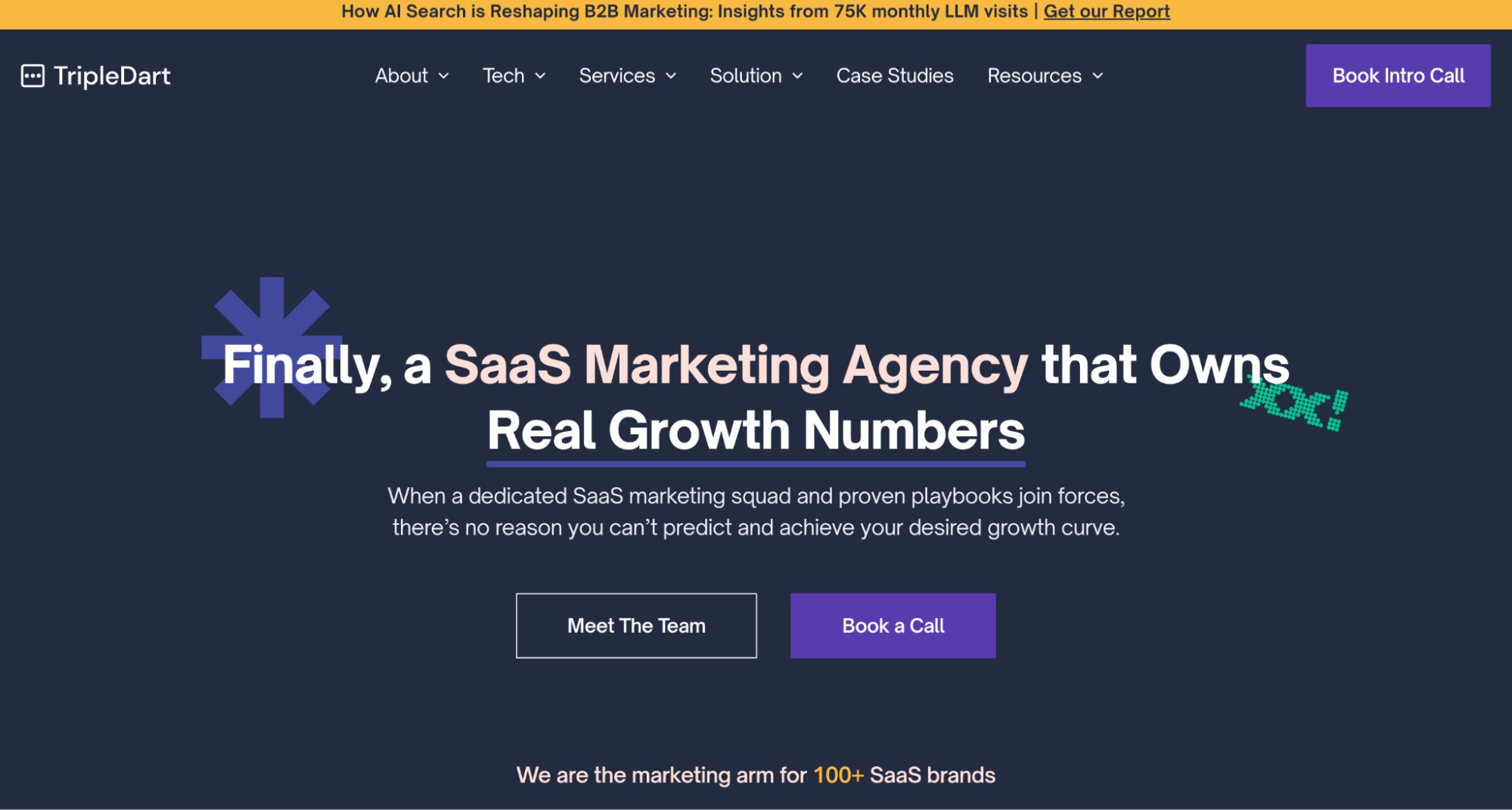
Best for: B2B SaaS companies
Notable Clients: Blume, Accel, Surge
TripleDart stands out as a specialized B2B branding agency in India that focuses exclusively on SaaS and high-growth technology companies. They understand the unique challenges of SaaS branding.
Their approach has a brand strategy with growth marketing, so that your brand not only looks professional but actively grows its pipeline.
Core Strengths:
- Deep expertise in 100+ B2B SaaS brand transformations
- Integration of branding with performance marketing and growth strategy
- Understanding of SaaS-specific buyer journeys and decision-making processes
- Proven track record with funded startups and scale-up companies
Services: Brand Strategy, Website Design & Development, Growth Marketing, SEO, Performance Marketing
Investment: $12,000 to $24,000
{{specficBlog}}
6. Fresh Mind Ideas

Best for: High-growth startups and SMBs
Notable Clients: QWQER, Unity, Temple Trees, TutorComp, Valight Electric
Fresh Mind Ideas’ branding solutions are specifically designed for growing companies that need professional brand presence without enterprise-level investment. They’ve completed 200+ projects across startups, scale-ups, and government organizations.
Their client-centric approach and transparent project management make them effective for startups navigating their first major branding initiatives while maintaining budget.
Core Strengths:
- 8+ years specializing in startup and SMB branding
- Award-winning creative solutions with proven ROI
- Multi-industry expertise (fintech, real estate, education, healthcare)
- Scalable brand systems designed for rapid growth
Services: Brand Strategy, Logo Design, Packaging, UX/UI Design, Video Production
Investment: $3,000 to $15,000
7. Upclues

Best for: Early-stage to growth-stage B2B Digital-first companies
Notable Clients: Various B2B technology and service companies
Upclues stands out for their strategy-first approach to B2B branding combined with digital marketing expertise. They understand that modern B2B brands need to work seamlessly across digital channels and sales processes.
Their proven process includes discovery, strategy development, visual identity, and digital implementation, ensuring brands work effectively across every customer touchpoint.
Core Strengths:
- Comprehensive brand process from discovery to launch
- Focus on brands
- SEO and digital marketing integration
Services: Brand Strategy, Visual Identity, Website Development, SEO, Digital Marketing
Investment: $5,000 to $18,000
8. Yellow Slice
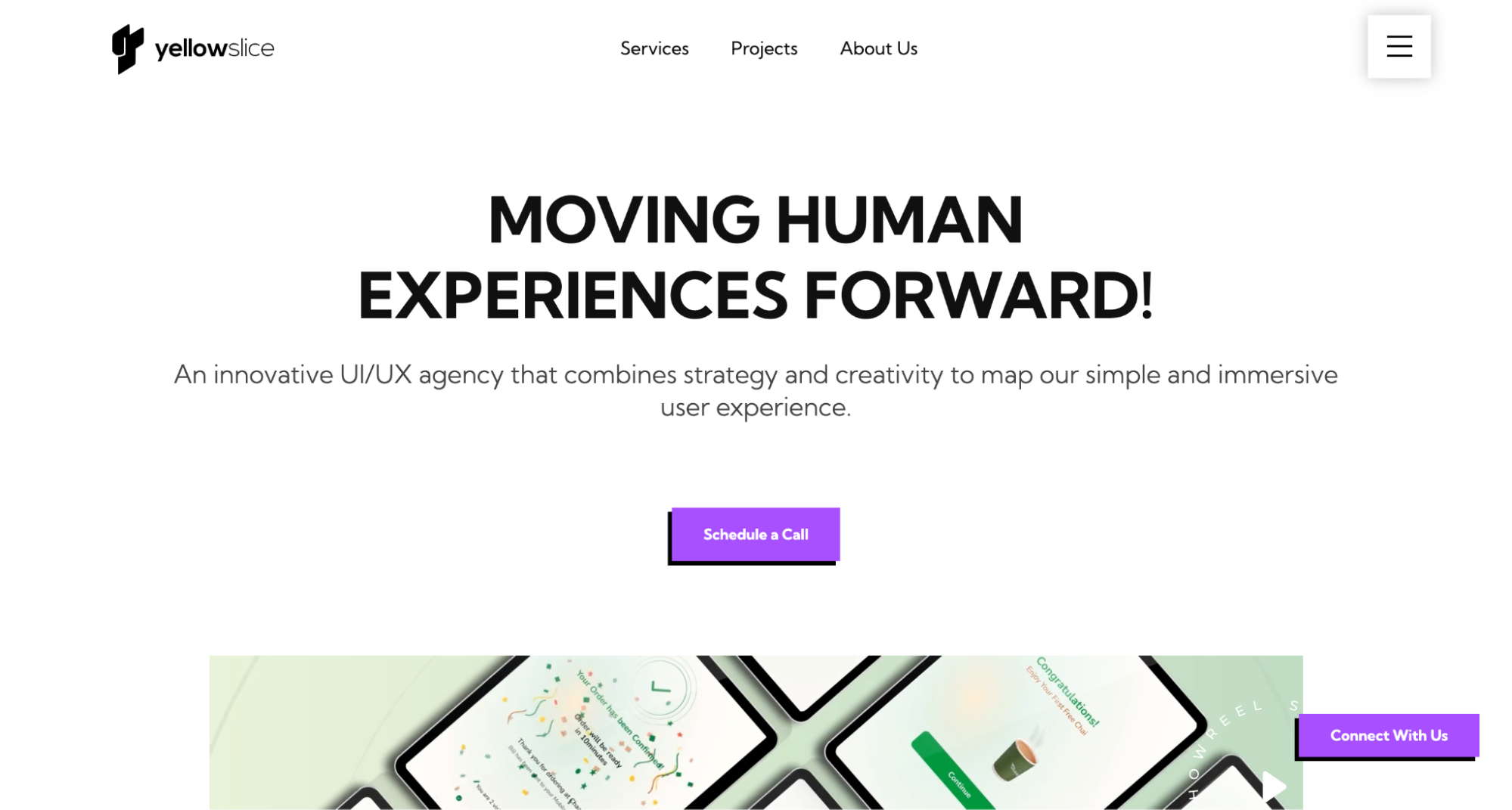
Best for: Established B2B companies
Notable Clients: FedEx Express, PayTM
Yellow Slice brings 15+ years of experience and 1500+ successful projects to B2B brand challenges. Their STEP approach (Soak, Think, Execute, Proof) is systematic brand development that brings measurable results.
They excel at helping established B2B companies modernize their brands while maintaining existing equity and market recognition.
Core Strengths:
- 15+ years of proven experience
- 1500+ successful brand projects
- Systematic STEP methodology
- Strong track record with established brands
Services: Brand Strategy, UI/UX Design, Website Development, Digital Marketing
Investment: $15,000 to $40,000
9. Wilson Wings

Best for: B2B companies
Notable Clients: Various B2B brands across industries
Wilson Wings has quickly established itself as a branding agency known for creative approaches to B2B brand challenges.
Their approach focuses on creating brands that not only look distinctive but also perform effectively across complex B2B sales processes.
Core Strengths:
- Innovative approach to B2B branding challenges
- Focus on brand development
- Integration of creativity with strategic thinking
Services: Brand Strategy, Visual Identity, Brand Guidelines, Marketing Collateral
Investment: $6,000 to $20,000 Competitive pricing
10. GrowthCX
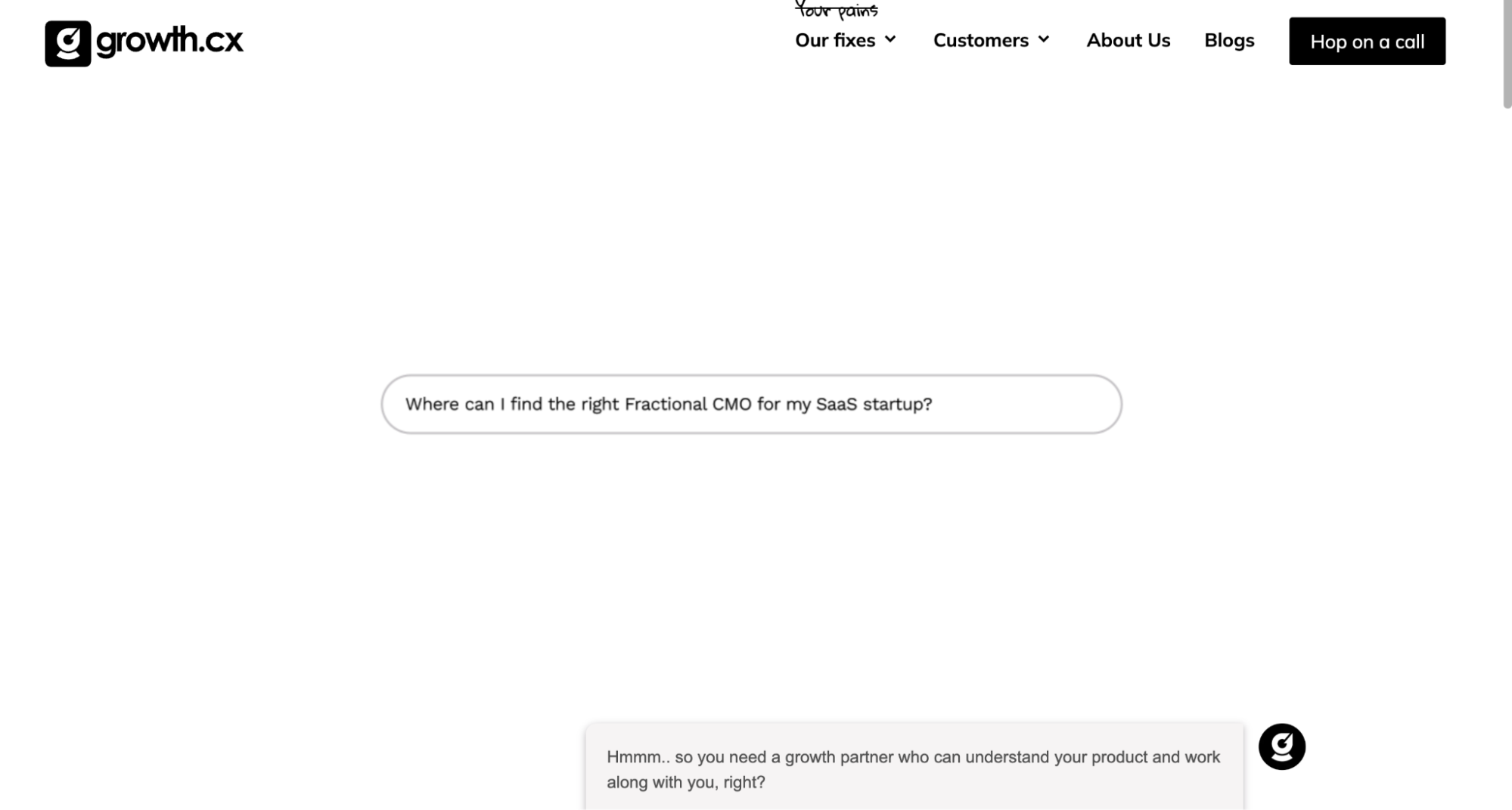
Best for: Specialty: B2B SaaS and product-led growth companies
Notable Clients: BrowserStack, Capillary Technologies, Whatfix, Manthan, Zypp Electric, QuickBooks India
GrowthCX uses data and user insights to shape SaaS brand strategies and experiences. They integrate brand positioning with product UX and performance marketing to accelerate user acquisition and retention.
Core Strengths:
- Deep analytics on user behavior and market trends
- Intuitive UX flows
- Brand-led growth campaigns
- Scalable and modular design systems
Services: Brand Strategy & Positioning, UX/UI & Product Design, Performance Marketing, Content & SEO, Analytics & Optimization
Investment: $10,000 to $25,000
How to Choose the Right B2B Branding Agency
Selecting the right B2B branding agency requires more than comparing portfolios. Here's how to make the correct choice:
Evaluate B2B Experience
Look for agencies with proven B2B track records. Ask specific questions:
- How many B2B clients have you served in my industry?
- Can you show examples of brands that drove measurable business results?
- Do you understand our complex sales process and buyer journey?
Assess Thinking
Great B2B brand positioning agencies lead with strategy, not creative. Evaluate their approach:
- Do they start with research and competitive analysis?
- Can they articulate your brand positioning clearly?
- How do they connect brand work to business outcomes?
Review Their Process
Professional agencies follow systematic processes that ensure consistent results:
- Discovery and research phase
- Strategic development and positioning
- Creative development and iteration
- Implementation and optimization
Understand Investment Levels
B2B branding agencies in India typically charge:
- Basic brand packages: $2,400 to $6,000 for logo and identity
- Comprehensive branding: $6,000 to $18,000 for strategy and complete systems
- Enterprise transformations: $18,000+ for complex rebranding projects
Ready to Turn Your Brand Into a Growth Asset?
You’ve seen how top B2B agencies in India craft powerful brands that attract the right customers and bring revenue. Now it’s your turn.
At ThunderClap, we jump in and own every step: we research your market, nail your positioning, design a brand identity that sticks, build a high-performance website in Webflow, and keep improving through CRO and growth support. You get one partner handling strategy, design, development, and ongoing optimization.
Pick us and watch your brand:
- Grab attention from the first click
- Build trust with every interaction
- Fill your pipeline with qualified leads
- Grow revenue predictably quarter after quarter
No fluff. No jargon. Just a clear path from brand to sales.
Ready to see how a strategic B2B brand drives growth? Let’s talk.
{{ctaBlock}}
Discover how ThunderClap can help you build a B2B brand for measurable growth. No generic creative process - just strategic brand development that connects with your buyers and gets results.
Frequently Asked Questions
1. Which is the best B2B branding agency?
The best B2B branding agency depends on your specific needs, industry, and growth stage. For example, ThunderClap leads for conversion-focused B2B branding.
Consider these factors when choosing:
- Does the agency understand your market and buyers?
- Do they lead with research and positioning?
- Can they show brands that drove business growth?
- Do they connect branding with digital presence?
2. How much does it cost to hire a branding agency?
B2B branding agency costs in India typically range from $2,400 to $30,000+, depending on the scope of work. Strong B2B brands typically generate 2-3x ROI through improved lead quality, faster sales cycles, and premium pricing opportunities.

The Complete Guide to B2B Web Design in 2025
Your website is your most powerful sales rep. Is yours converting?
Most B2B websites look visually appealing, but opportunities often slip away with every click. In 2025, smart B2B companies build websites that bring in more leads, faster sales cycles, and ROI. This guide shows you exactly how to do it.
At ThunderClap, we’ve rebuilt 129+ B2B websites for SaaS, fintech, and enterprise tech companies. We don’t just make sites look good. We make them convert. Every design decision must answer one question: Will this help engage the user?
Here’s your complete playbook for B2B Web Design in 2025, no fluff, just proven strategies that work.
Chapter 1: Why Most B2B Websites Fail
B2B Buyers Changed. Your Website Didn’t.
B2B buyers complete 67% of their research before they talk to sales. They expect experiences, even when buying enterprise software. They bounce in 5 seconds if your value isn’t crystal clear.
Most B2B websites still treat visitors like they have infinite time to decode corporate speech. They don’t.
The 3 shifts killing traditional B2B web design:
Research Independence: Buyers educate themselves online. Your website must answer every question they have, or they’ll find a competitor who does.
Mobile-First Behavior: Over 60% of B2B research happens on phones. If your site breaks on mobile, you lose the sale.
Speed: One-second delays kill 7% of conversions. B2B buyers won’t wait for slow sites.
The Conversion-First Tactic
At ThunderClap, we approach every B2B Web Design project with one obsession: conversion. Pretty pictures don’t pay the bills. Pipeline does.
Clarity beats creativity. Your homepage hero should explain what you do in 5 seconds, not win design awards.
Speed beats spectacle. We choose fast-loading solutions over animations that make visitors wait.
Data beats opinions. We test everything. Every headline, every button, every form field gets optimized based on user behavior.
“We used to design around visuals first. Now we start every project with conversion metrics,” explains Ayush Barnwal, Team Lead at ThunderClap. “If a design doesn't have a pilot leads, it doesn’t make the cut.”
This isn’t just web design. It’s revenue optimization.
Chapter 2: The 8 B2B Web Design Best Practices That Actually Work
1. Build Your Message Architecture First
Most companies start with pretty mockups. Smart companies start with messaging that converts.
Your homepage must answer three questions in 5 seconds:
- What do you do?
- Who do you help?
- What happens next?
Bad example: We leverage cutting-edge AI to optimize enterprise workflows.
Good example: Cut your manual data entry by 80% in 30 days.
The second headline tells you exactly what you get and when you get it. The first one says nothing useful.
💡Pro tip: Use the 5-second test. Show your homepage to someone for 5 seconds. If they can’t explain your business, rewrite your headline.
Related read: Find a few good b2B website design examples here
2. Design for Multiple Decision Makers
B2B purchases involve 6-10 people. Your website must speak to all of them.
- Technical buyers want specs, integrations, and performance data.
- Business buyers want ROI, case studies, and competitive advantages.
- Procurement teams want pricing, contracts, and vendor information.
Create distinct paths for each audience. Use role-based navigation, targeted content, and persona-specific CTAs.
Example: Atlassian’s homepage lets visitors choose their role (Product Manager, Developer, etc.) and shows relevant content for each.
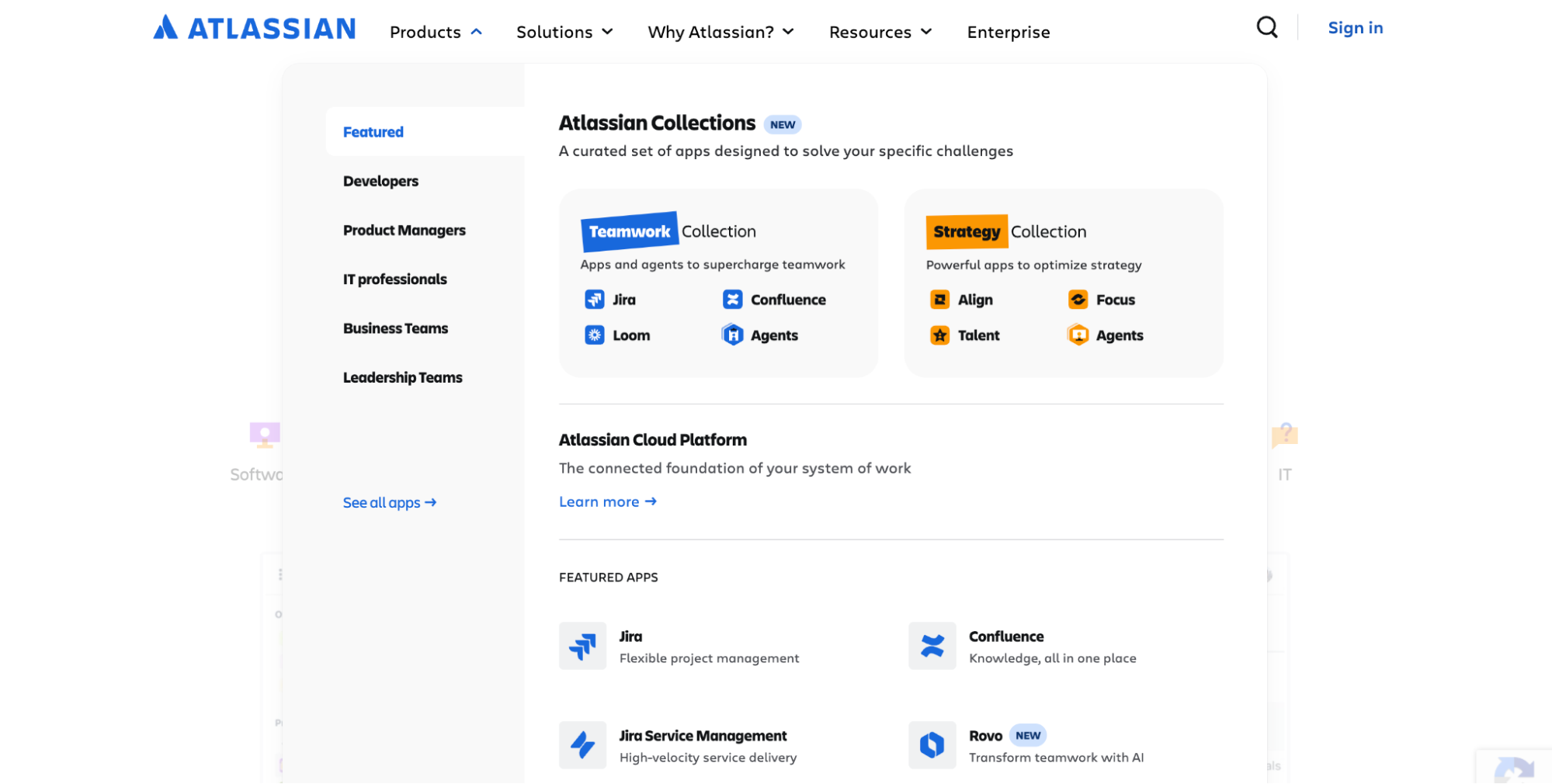
3. Speed Up Everything
Fast sites convert better. Period. Target these benchmarks:
- Page load time under 2 seconds
- Core Web Vitals are in the green
- Mobile speed matches desktop

How we do it at ThunderClap:
- Choose Webflow’s global CDN over slow WordPress hosting
- Optimize images with next-gen formats (WebP, AVIF)
- Load critical content first, everything else second
- Test speed on mobile networks, not just wifi
4. Make Mobile the Priority
Over half of B2B research happens on mobile. Design for thumbs, not mice. Mobile-first B2B Web Design means:
- Navigation works with one thumb
- Forms have large, tappable fields
- CTAs stay visible while scrolling
- Content loads fast on 4G networks
Example: Monday.com’s mobile site keeps the main CTA sticky at the bottom. Users can book a demo without scrolling back to the top.
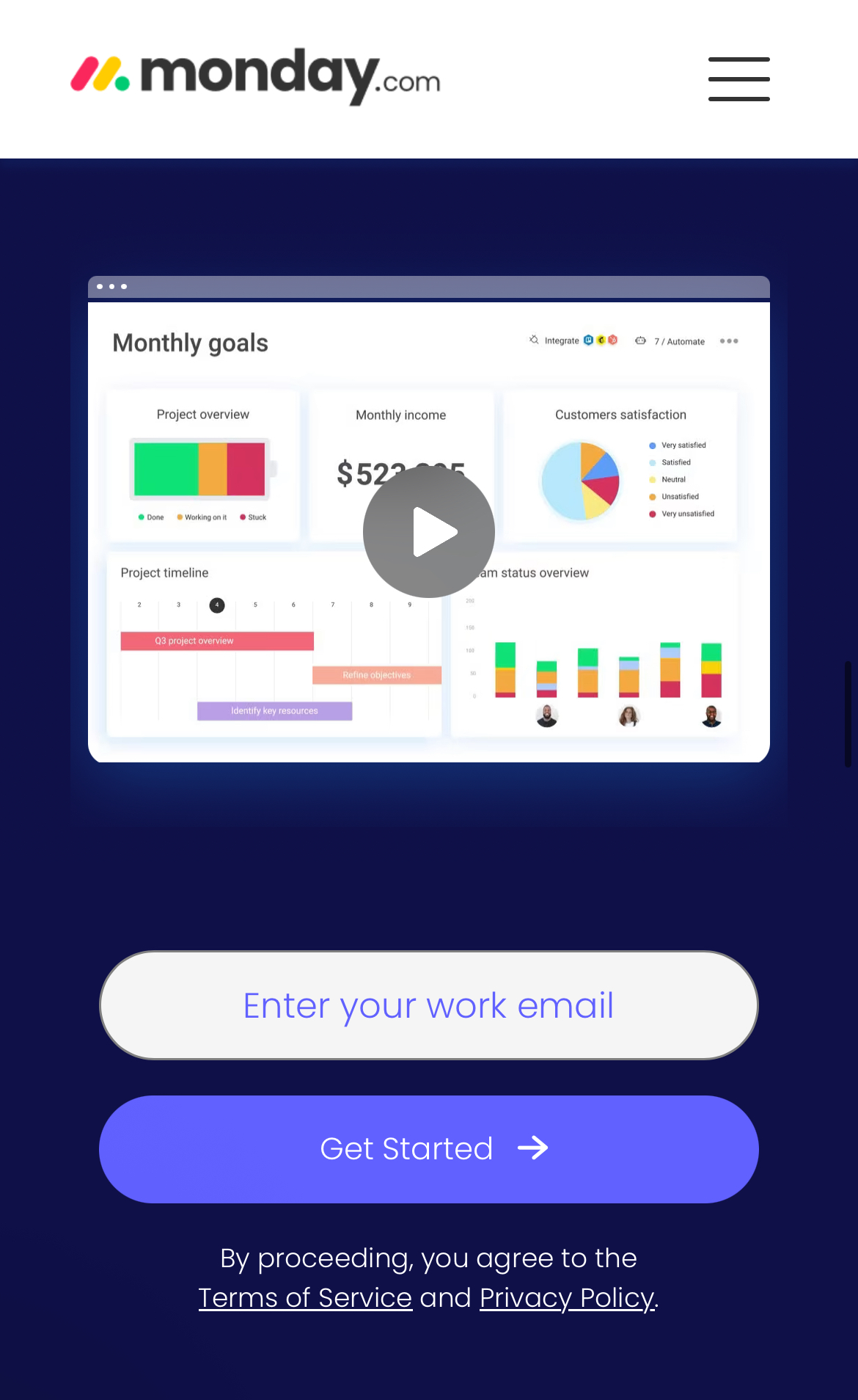
5. Show Proof, Not Promises
B2B buyers are skeptical. They’ve been burned by vendors who overpromise and underdeliver.
Three types of proof that convert:
Logo walls: Show recognizable customer brands above the fold.
Metric-driven testimonials: Increased MQLs by 40% in 3 months beats ‘Great product!’
Detailed case studies: Show the problem, solution, and specific results with real numbers.
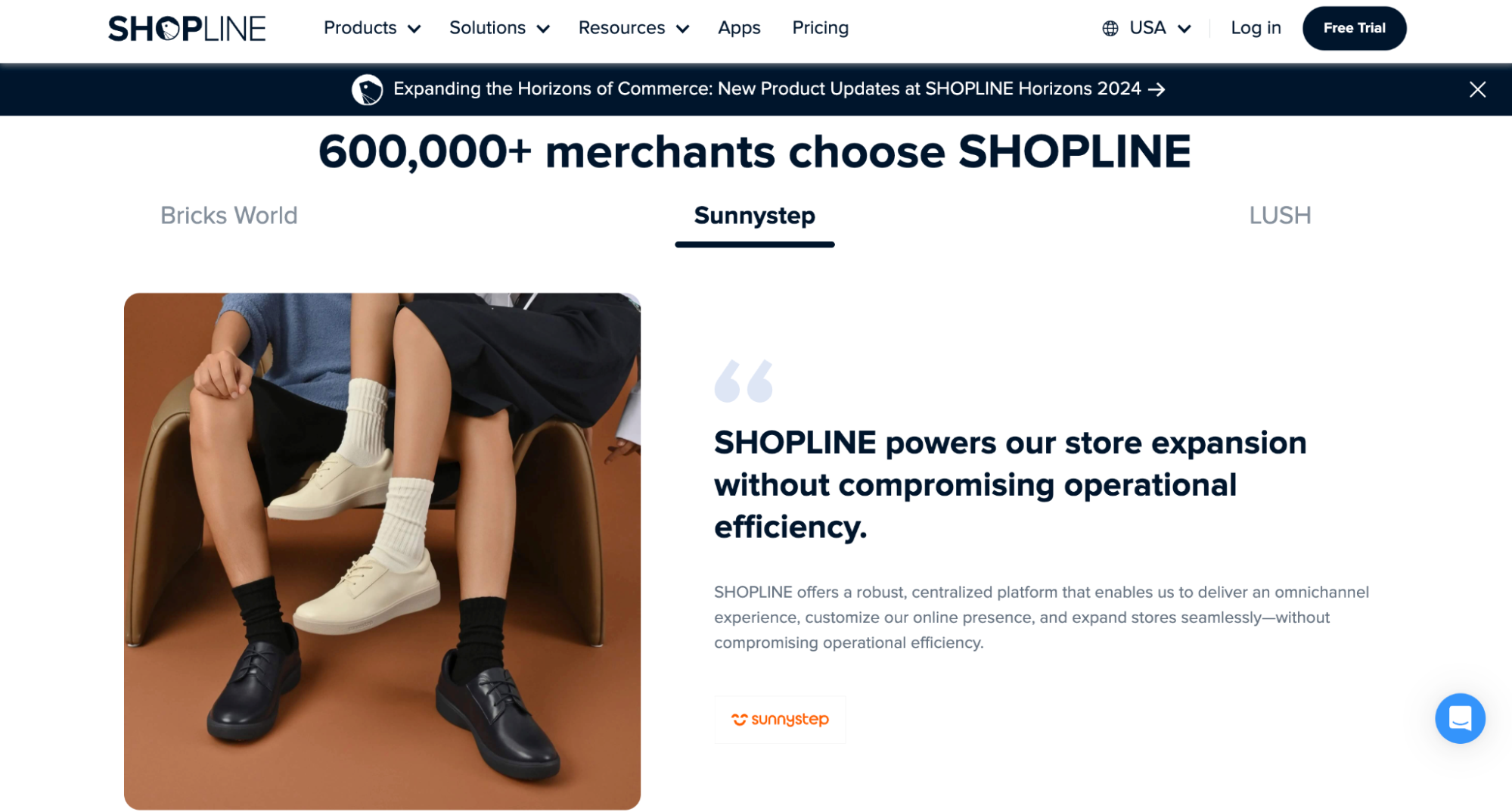
💡Pro tip: Use industry-specific proof. Show fintech logos to fintech prospects, not generic Fortune 500 brands.
6. Simplify Your Navigation
If visitors can’t find what they need, they’ll leave.
Navigation best practices:
- Keep top-level menu items under 7
- Use clear labels, not clever ones
- Add search for content-heavy sites
- Make contact info easy to find
Example: Segment organizes navigation by audience (Solutions) also than just the internal structure (Products). Visitors find relevant information faster.
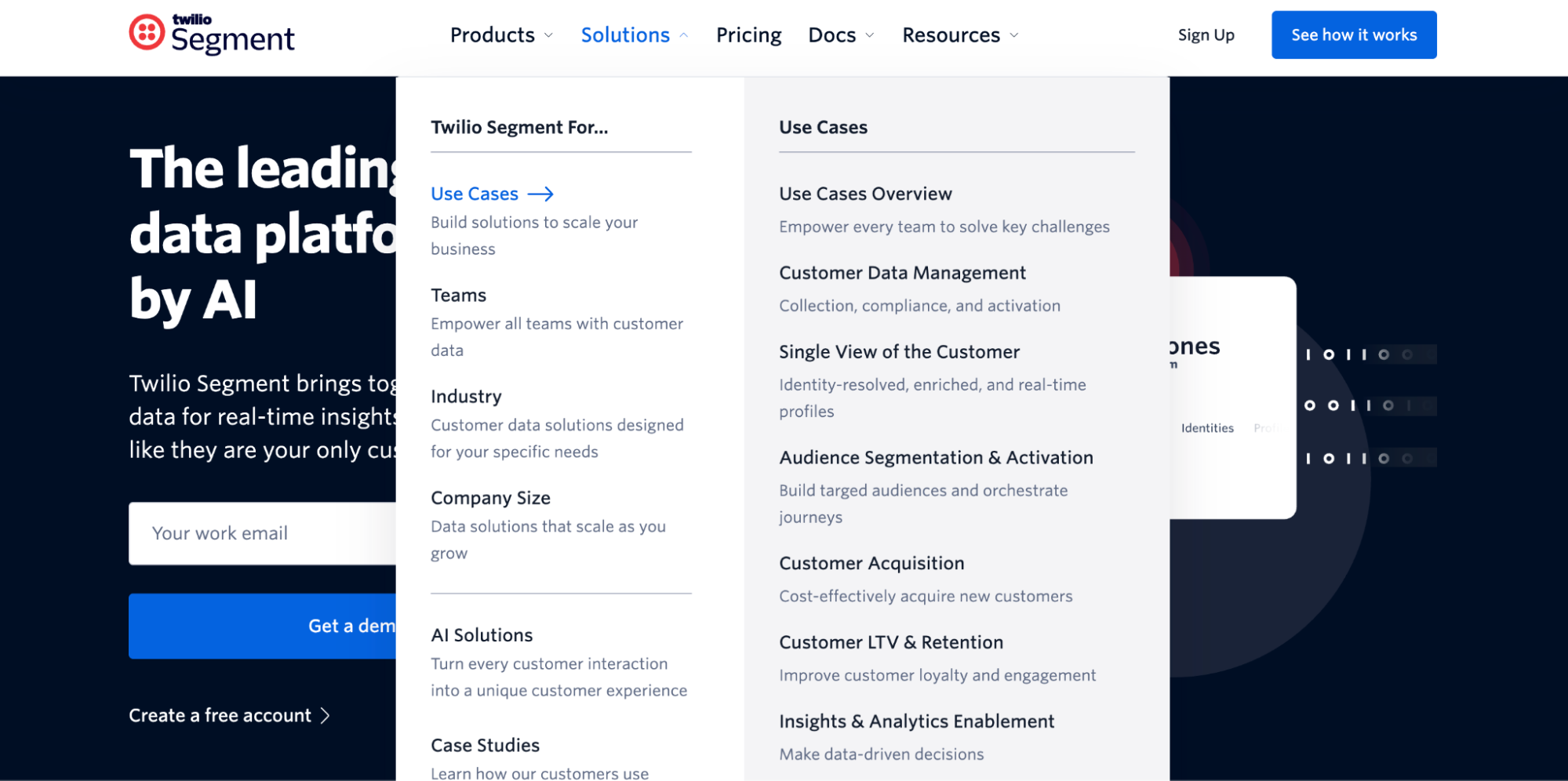
7. Optimize Every Form
Forms are where conversions happen or die. Form optimization rules:
- Ask for less information upfront
- Use single-column layouts
- Add helpful error messages
- Test mobile form completion
Example: Apollo.io’s signup form asks for just an email address. They collect more details after users see value in the product.
Anisha, Art Director, notes: “Reducing form fields from five to two often boosts conversions for SaaS clients.”
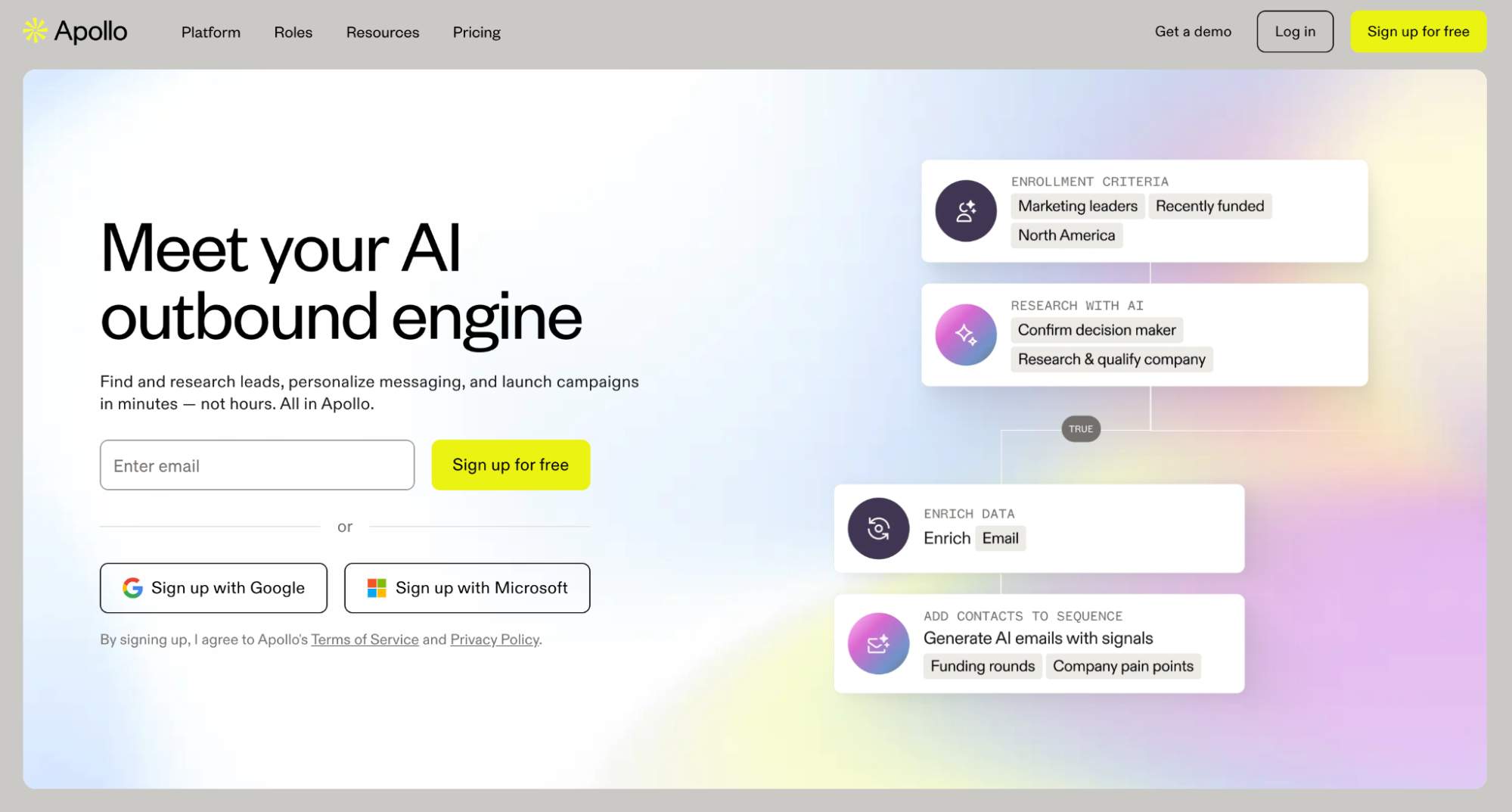
8. Design for Conversion Paths
Every page should guide visitors toward the next logical step. Conversion path strategy:
- Homepage → Product pages → Demo request
- Blog post → Resource download → Email nurture → Sales call
- Pricing page → Free trial → Onboarding → Paid plan
Map out these paths before you design anything. Every page needs a clear next step.
Related read: See how top brands balance performance, scalability, and user experience at scale
“Before we touch a single design file, we define your product’s marketing angle through a rigorous discovery process that aligns your unique value proposition with your buyers’ most urgent needs,” says Ragini Ramanathan, Creative Director.
Chapter 3: Why Webflow Dominates B2B Web Design in 2025
WordPress, Drupal, and custom development create bottlenecks between your marketing team and your website. Want to update a headline? Submit a dev ticket. Need a new landing page? Wait two weeks.
B2B companies need to build pages as fast as campaigns need them.
{{specficService}}
At ThunderClap, we chose Webflow because it lets us move fast without breaking things. Our clients can update content, launch campaigns, and optimize conversions in real-time.
Scale Without Rebuilds
Growing B2B companies need websites that grow with them. Webflow’s modular architecture makes this seamless.
Component libraries: Build once, reuse everywhere. Create consistent landing pages, product sections, and testimonial blocks.
Multi-site management: Run multiple brands, regions, or product sites from one dashboard.
Design systems: Maintain brand consistency across all digital properties with experimentation.
Chapter 4: Performance That Enables Conversions
Security and Compliance Build Trust
B2B buyers evaluate your security before they evaluate your product. Enterprise-grade security isn’t optional.
Security essentials:
- SSL certificates (HTTPS everywhere)
- GDPR compliance for global markets
- SOC 2 compliance for enterprise sales
- Regular security audits and updates
Chapter 5: Content Strategy to Educate and Convert
SEO-Driven Content
Your website should own every search term your buyers use to research solutions.
Content strategy framework:
- Map buyer journey stages to content types
- Create pillar pages for major topics
- Link related content to build topical authority
- Optimize for buyer-intent keywords, not just traffic
Educational Content That Qualifies
The best B2B content educates prospects while moving them toward purchase decisions.
Content types that convert:
- ROI calculators that quantify your value

- Comparison guides that highlight your advantages
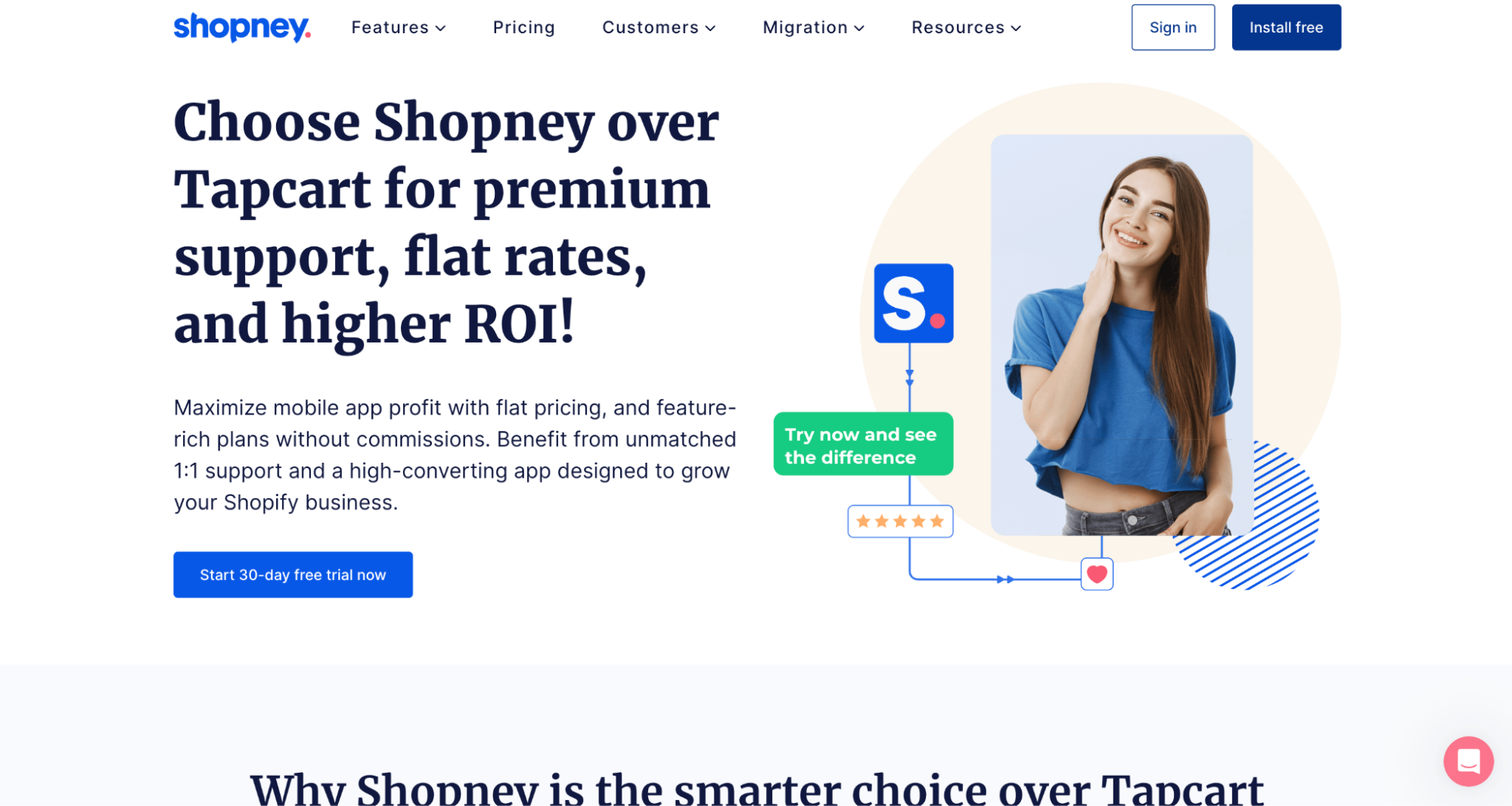
- Implementation guides that show ease of use
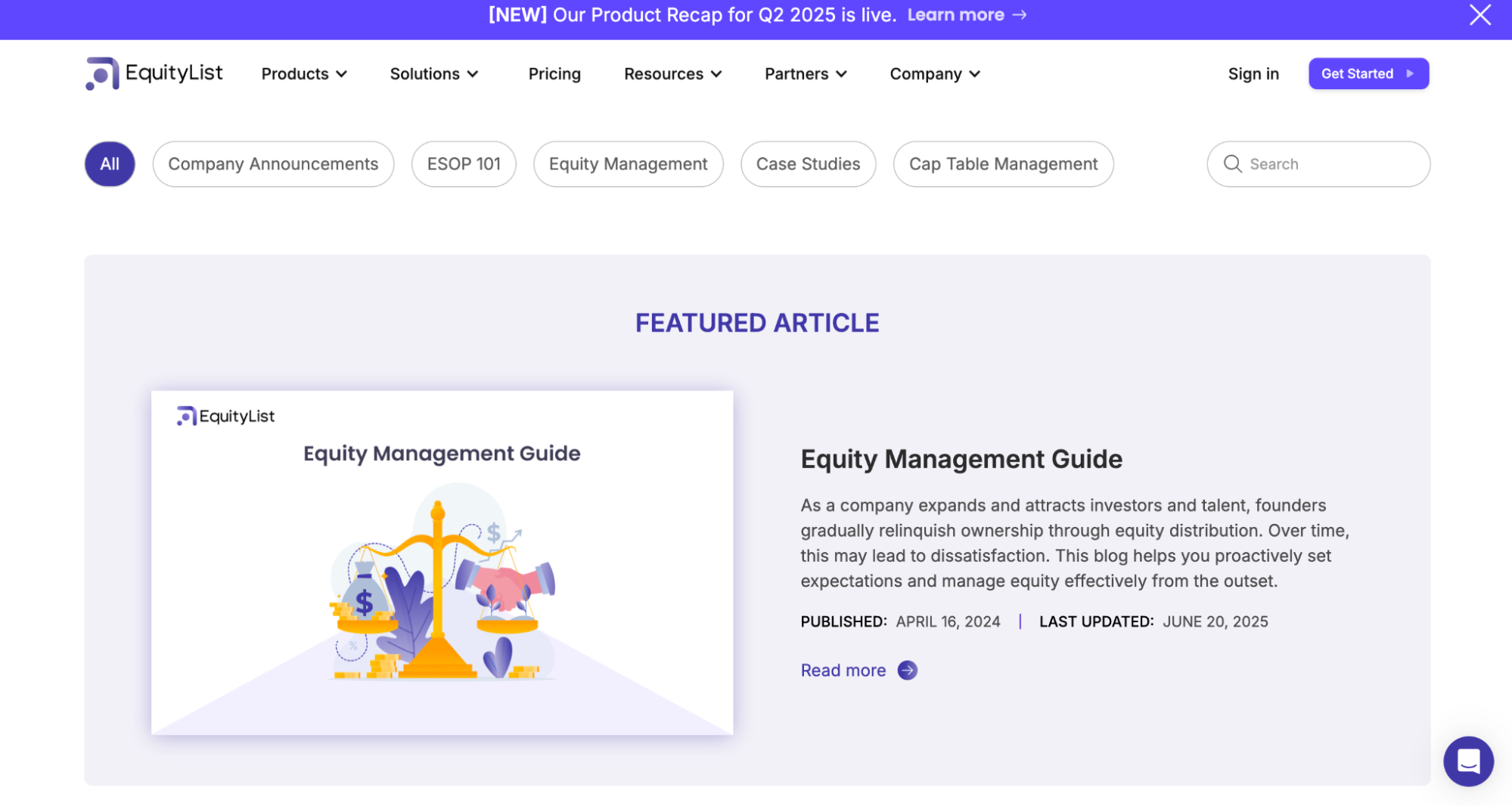
- Case studies with specific, measurable results
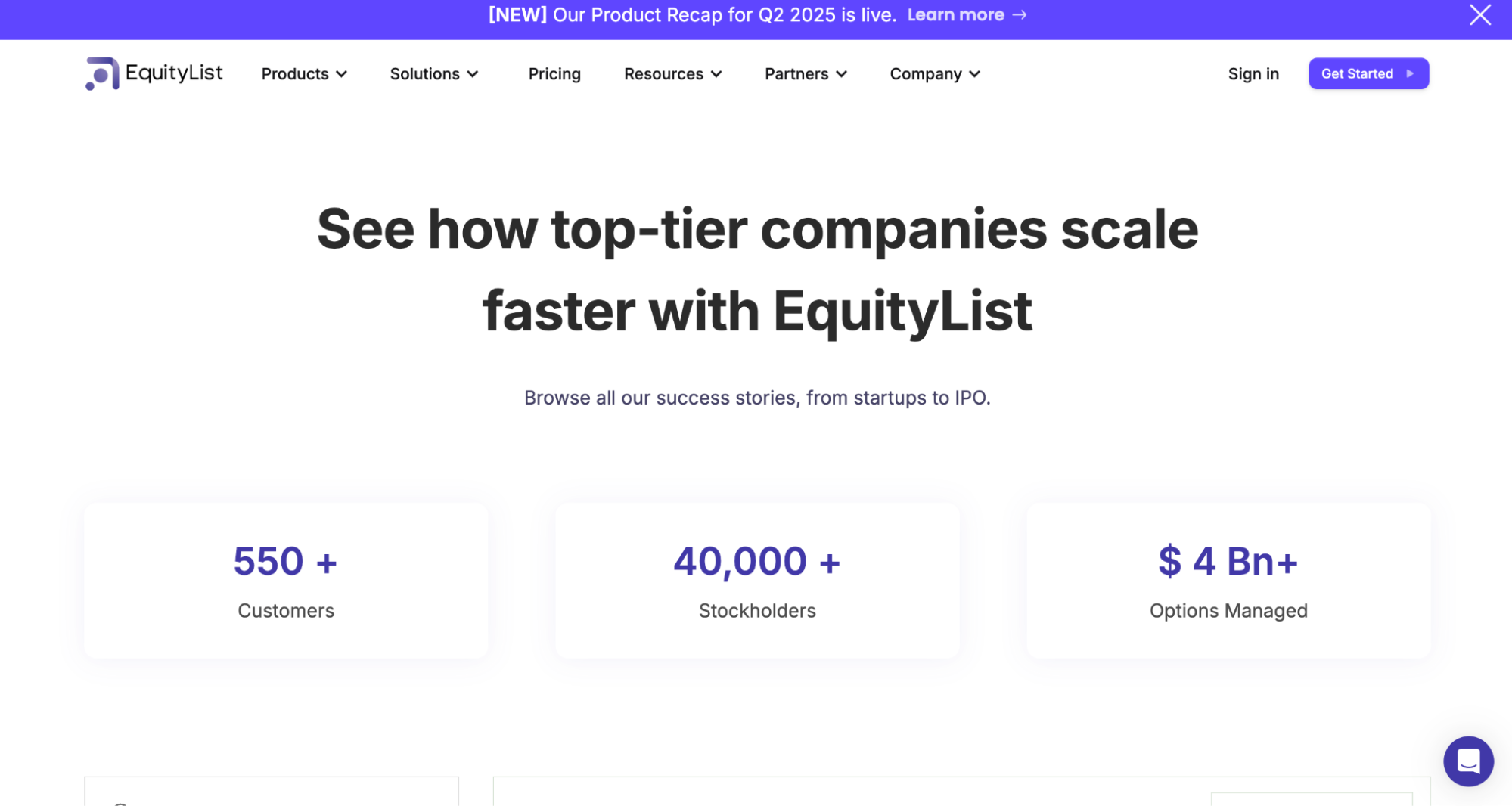
Industry-Specific Optimization
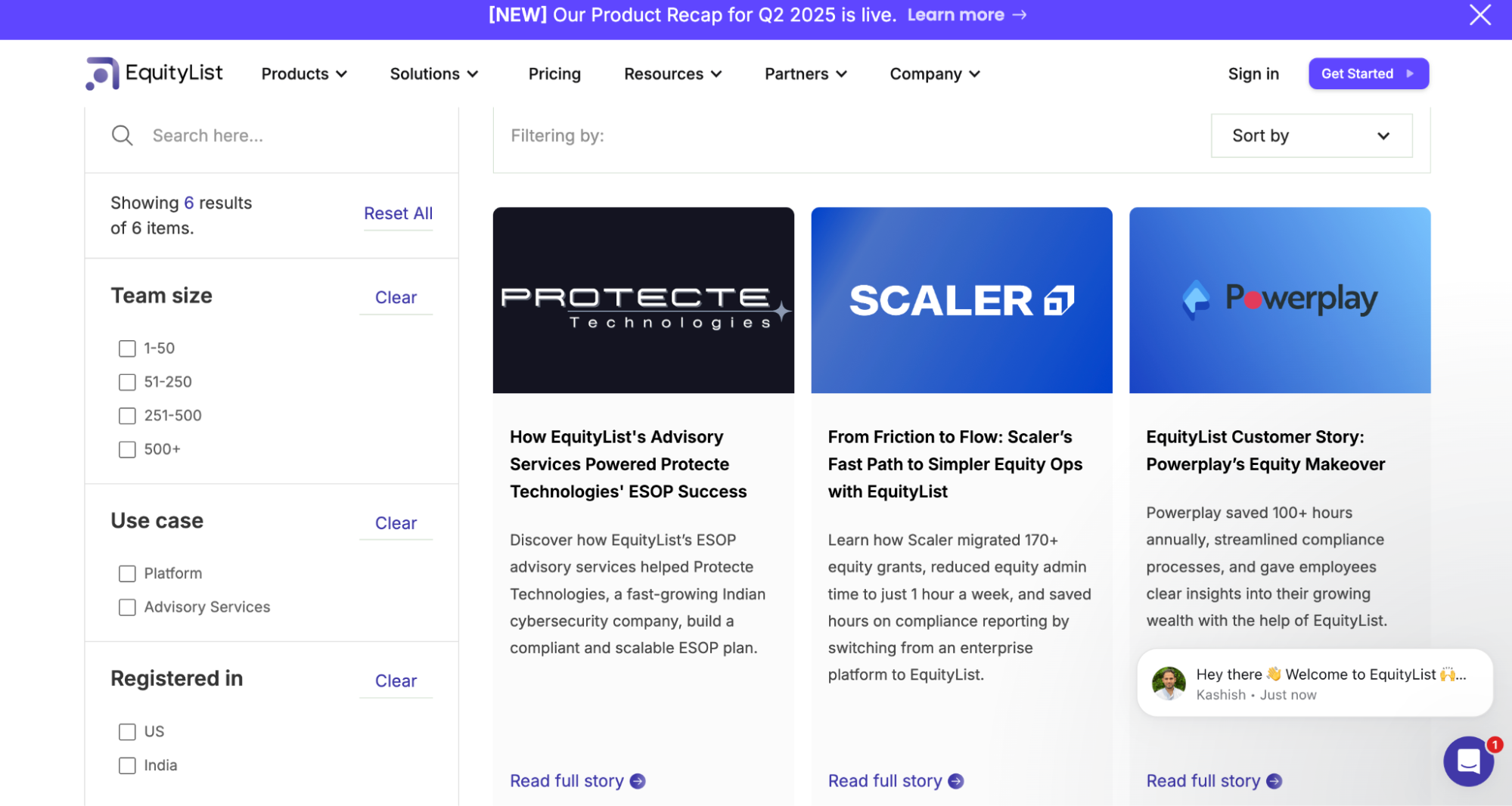
Generic content gets ignored. Specific content gets shared, bookmarked, and referenced in buying decisions.
- Create content for specific verticals (fintech, healthcare, manufacturing)
- Address pain points and regulations
- Show customer success stories
- Speak the language of each industry
Chapter 6: Systematic Conversion Optimization
Testing Frameworks
Conversion optimization is not guesswork. It is systematic experimentation based on data.
Testing priorities:
- Headlines and value propositions
- CTA copy and button colors
- Form lengths and field types
- Page layouts and content order
B2B-Specific Metrics
Track metrics that connect to revenue, not just vanity numbers.
- Marketing Qualified Lead (MQL) conversion rate
- Demo request conversion rate
- Content engagement depth
- Return visitor progression through funnel
- Track multi-touch buyer journeys
- Connect website behavior to closed deals
- Measure long-term customer value by traffic source
- Identify the highest-converting content and pages
Behavioral Analytics for Optimization
Numbers tell you what happened. Behavior tells you why.
- Heatmaps show where visitors look and click
- Session recordings reveal friction points
- Form analytics identify abandonment causes
- Scroll tracking measures content engagement
{{specficBlog}}
Chapter 7: Building Systems That Scale
Create once, use everywhere. Design systems let you build consistent experiences while moving fast.
Design system components:
- Hero sections with proven layouts
- Testimonial blocks with consistent formatting
- CTA buttons optimized for conversion
- Form templates tested across devices
Multi-Brand Management
Growing B2B companies often manage multiple brands, products, or regions. Your website architecture should handle this. Scalable website strategy:
- Shared component libraries across properties
- Centralized content management
- Consistent performance optimization
- Coordinated SEO strategy
Integration Ecosystem
Your website should work seamlessly with your entire marketing and sales stack.
- CRM (HubSpot, Salesforce) for lead management
- Marketing automation for campaigns
- Analytics (Google Analytics, Mixpanel) for optimization
- Chat tools (Intercom, Drift) for real-time engagement
Chapter 8: Advanced Features That Differentiate
Interactive Tools
Static brochure sites get ignored. Interactive tools get bookmarked and shared. Interactive content ideas:
- ROI calculators that show your value
- Assessment that qualifies prospects
- Product configurators for solutions
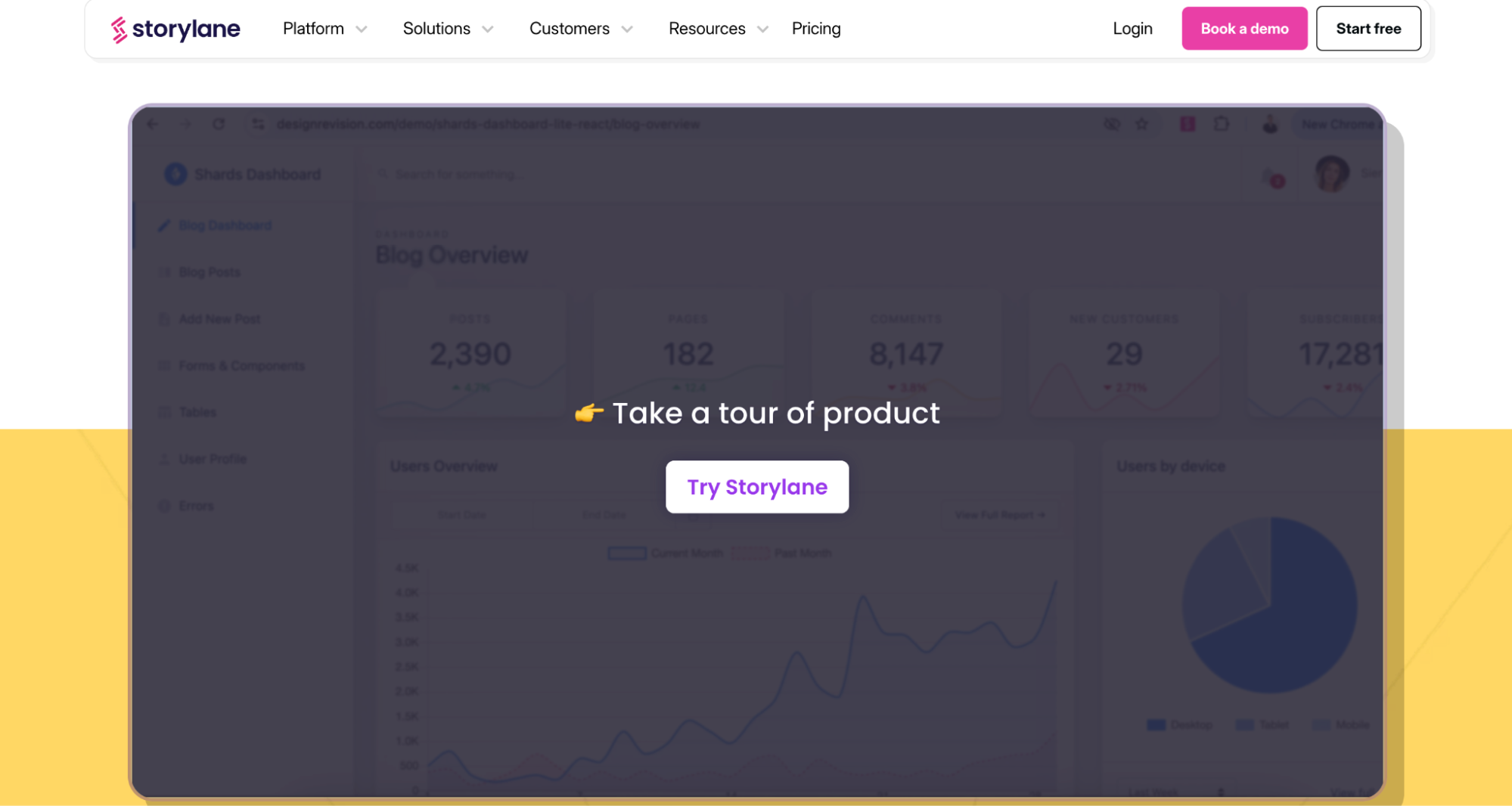
- Comparison that highlights advantages
Video and Rich Media Strategy
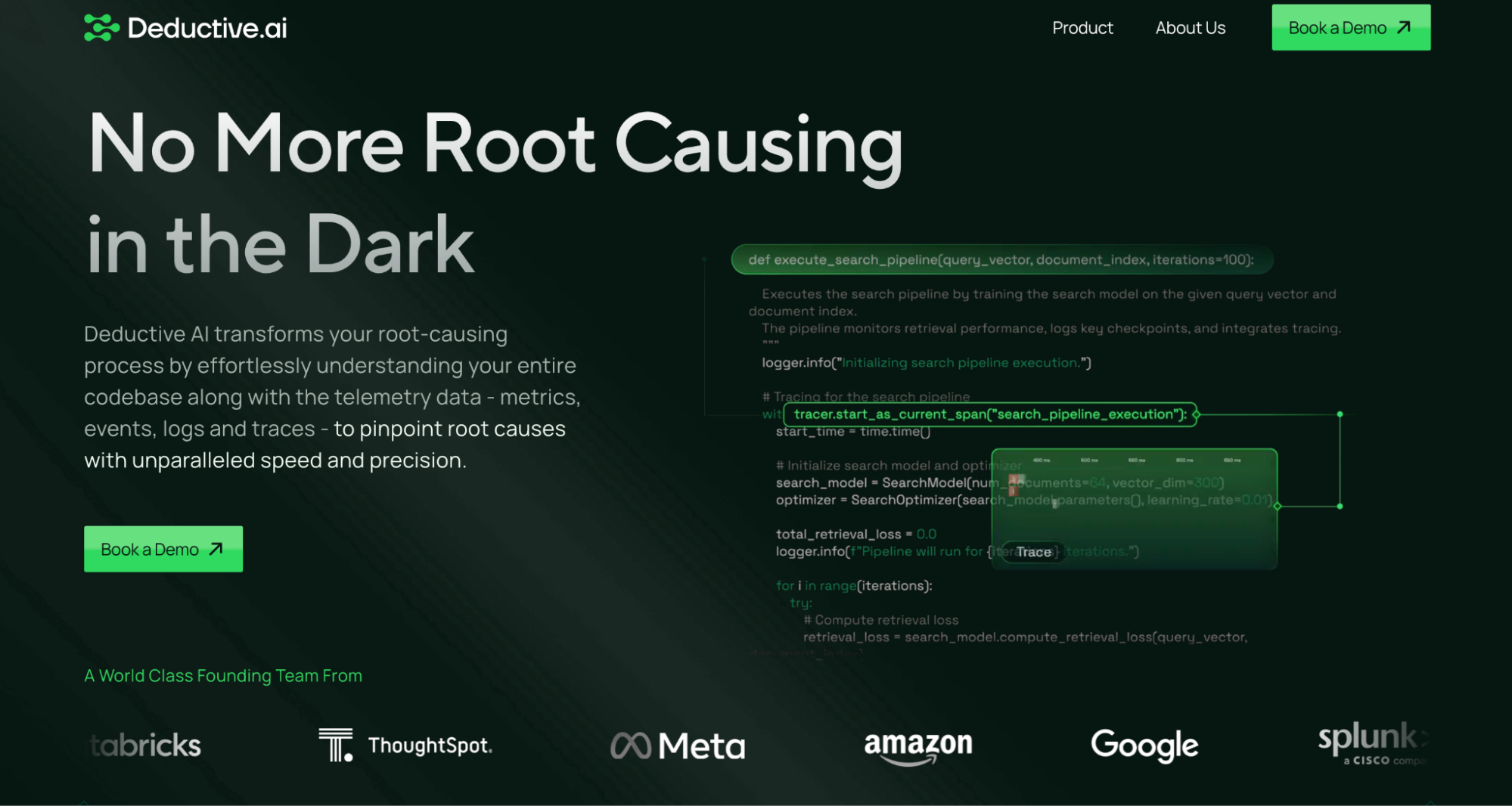
Video explains B2B solutions better than text. Use it strategically. Video content that converts:
- Product demos
- Customer testimonials
Sales and Marketing Alignment
Your website should enable your sales team, not create more work for them.
- Lead scoring based on website behavior
- Alerts for high-intent activities
- Content consumption history for sales calls
- Direct meeting booking with available reps
Finale: Implementation
Project Planning That Prevents Failures
66% of B2B web projects fail due to poor planning. Don’t be a statistic.
Project success framework:
- Stakeholder alignment workshops before design starts
- User journey mapping with sales team input
- Content strategy before visual design
- Performance benchmarks and success metrics
Team Skills for Modern B2B Web Design
Building high-converting B2B websites requires diverse skills.
- Analytics and data interpretation
- Conversion optimization and testing
- Content strategy and creation
- Technical SEO and performance optimization
KPIs That Connect to Revenue
Track metrics that matter to your business, not just your marketing dashboard.
- Lead volume and quality scores
- Demo and consultation requests
- Content engagement depth and progression
- Customer acquisition cost by traffic source
- Page speed and Core Web Vitals
- Mobile user experience scores
- Search visibility for buyer-intent keywords
- Customer satisfaction and feedback scores
Your 2025 B2B Web Design Action Plan
The companies that dominate B2B markets in 2025 will have websites that work as hard as their sales teams. They’ll choose performance over pretty pictures, conversion over creativity, and systematic optimization over set-it-and-forget-it approaches.
Your priorities:
Design for your buyers who research on mobile, demand fast experiences, and expect valuable content.
Build conversion systems that guide visitors from initial interest through qualified leads to closed customers.
Optimize continuously through systematic testing, measurement, and improvement rather than periodic redesigns.
Integrate everything so your website works seamlessly with your sales and marketing processes.
The investment in modern B2B Web Design Best Practices pays dividends through better lead quality, shorter sales cycles, and higher conversion rates across all marketing channels.
Companies that implement these strategies see improvements in pipeline quality, sales velocity, and revenue growth.
Ready to Build a Website That Drives Revenue?
Reading about B2B Web Design best practices is one thing. Implementing them effectively is another.
At ThunderClap, we specialize in recharging underperforming B2B websites into revenue-generating systems. We work exclusively with ambitious B2B companies, SaaS platforms, fintech innovators, and enterprise tech providers, who understand their website should be their most effective sales asset.
{{ctaBlock}}
Our proven approach:
Discovery: We research your buyers, competitors, and business goals before we touch any design tools.
Conversion-Focused Design: We prioritize user experience and conversion optimization over winning design awards.
Modern Tech: We build on Webflow so you can iterate fast without technical bottlenecks.
Ongoing Optimization: We provide continuous testing and improvement services that compound results over time.
Whether you’re planning a complete rebuild or optimizing your current site, we can help you implement these strategies for lead generation and revenue growth.
Ready to see what systematic B2B Web Design optimization looks like for your company? Book a free strategy session with ThunderClap and discover how our approach can turn your website from a marketing expense into your strongest growth engine.
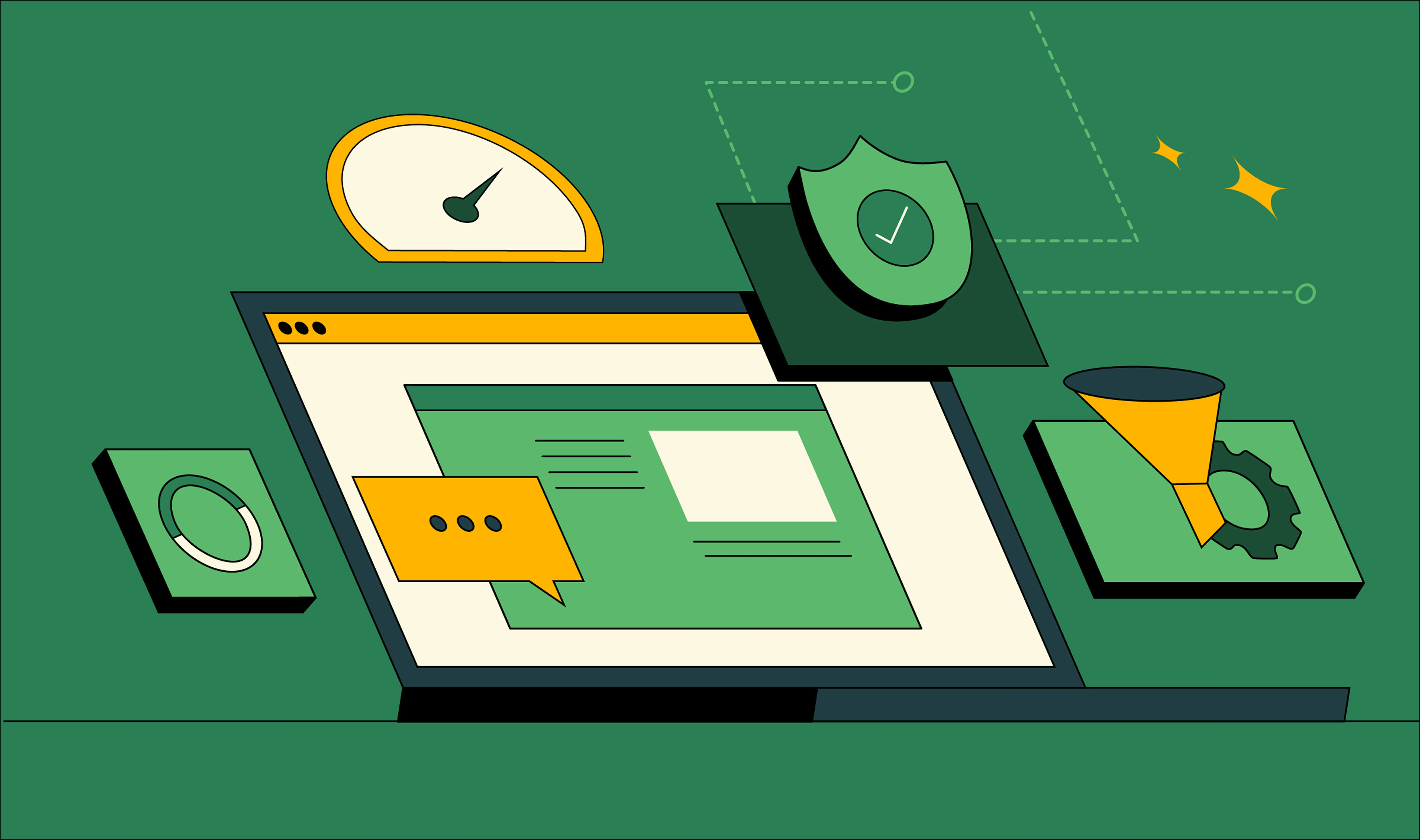
AI Landing Pages That Convert: 7 Design Principles Every AI Platform Should Follow
TL;DR
AI marketing teams are burning through multi-million dollar ad budgets on visually appealing but conversion-deficient AI Landing Pages. Rebuild funnels into revenue-generating machines with 7 tested design principles, from intelligent message hierarchy to micro-CRO tactics, and discover how ThunderClap’s Strategy + Webflow + Growth methodology turns every AI Landing Pages visitor into a qualified pipeline.
The $10 Million AI Landing Page Conversion Crisis
The artificial intelligence space exploded into a $190 billion market, yet most AI companies are losing marketing dollars through fundamentally broken conversion funnels. Every week, dozens of new AI platforms launch with pixel-perfect designs competing for the same keywords, investors, and enterprise customers. The harsh reality? Most AI Landing Pages fail spectacularly at their primary objective: converting sophisticated technical buyers into a qualified pipeline.
Why does this epidemic persist? Because too many AI companies treat web design as decoration rather than conversion optimization science. They build breathtaking AI SaaS Landing Page experiences that win ‘Awwwards’ but lose 7-figure revenue opportunities due to failed differentiation. Consequently, you abandon gorgeous, award-winning landing pages because they fail to answer the fundamental question: Why should I choose this AI solution over the 50 others that look and sound the same?
Our comprehensive analysis of B2B sites reveals a hard truth: while first impressions relate to design aesthetics, traditional “pretty page” approaches fail for AI products. The average SaaS conversion rate hovers around 2.1%, but AI platforms face unique challenges that drive conversions even lower.
Challenges such as: technical complexity, buyer skepticism, longer enterprise sales cycles, and commoditized positioning claims.
In this blog post, each principle integrates AI Landing Page Optimization with ThunderClap’s proven methodology.
1. Principle 1 – Intelligent Message Architecture Above the Fold
AI buyers are sophisticated information processors operating under severe time constraints. They allocate 8-12 seconds to evaluate whether your platform deserves deeper investigation. During this window, they need immediate answers to three fundamental questions:
- What specific business outcome does your AI deliver?
- How does your approach differ from 100+ competitive alternatives?
- What’s the next step for evaluation?
Miss this positioning window and 94% of AI Landing Pages visitors bounce without conversion, regardless of your outstanding product.
Traditional landing page advice says broad, feature-focused headlines like ‘Advanced Machine Learning Platform’ or ‘AI-Powered Business Intelligence.’ These approaches fail for AI products because:
- Commodity language: Every AI platform uses identical terminology (advanced, intelligent, powerful)
- Feature fixation: Capabilities matter less than outcomes to decision-makers
- Audience ignorance: Different personas care about different benefits within the same AI platform
ThunderClap’s Message Architecture Framework
Based on analyzing conversion patterns across AI platform rebuilds, ThunderClap has developed a 3-part architecture:
One-Line Promise
Lead with quantified business outcomes, not features. ‘Reduce model drift by 85% in production environments’ engages users better than ‘Advanced ML monitoring and alerting platform.’
Single Primary CTA
Resist the temptation to offer multiple paths. Focus ONLY on your highest-value conversion objective.
Context-Rich Proof
‘Deployed across 3,000+ healthcare AI pipelines processing 47M patient records’ provides evidence that generic testimonials cannot match.
{{specficBlog}}
2. Principle 2 – Persona-Based Journey
ThunderClap’s analysis of AI platform websites reveals common persona-based conversion failures:
Technical Evaluators (data scientists, ML engineers) bounce when messaging doesn’t address integration journey or performance benchmarks.
Executive Decision-Makers (CTO, VP of Engineering) abandon pages without clear ROI calculations, competitive advantages, or impact.
Compliance Officers (CISO, Legal, Risk Management) exit immediately when security, governance, and regulations aren’t featured.
Procurement Teams struggle with pages lacking pricing transparency, contract terms, or vendor evaluation criteria.
Each persona requires messaging, social proof, and conversion paths. But, creating separate landing pages for every audience segment becomes unsustainable at scale.
ThunderClap’s Intelligent Segmentation System
1. Behavioral Intelligence Triggers
- Referral source analysis: GitHub referrals indicate technical evaluators; LinkedIn suggests executive traffic
- Content consumption patterns: Documentation views vs. case study downloads
- Session behavior: Time spent on pricing vs. specifications
- Form field interactions: Job titles, company sizes, use case descriptions
2. Content Adaptation
With our in-house product marketing team, we create AI SaaS Landing Page experiences that adjust messaging based on ideal persona identification:
- Headlines for persona-specific value propositions
- Social proof rotates to show customer success stories
- CTA matches decision-maker priorities
- Content sections based on persona-specific needs
3. Principle 3 – Interactive Product Intelligence Demonstrations
Unlike project management software with familiar interfaces or CRM systems with intuitive data layouts, AI platforms perform complex mathematical operations that produce insights invisible to end users. Static screenshots and generic product mockups fail AI Landing Pages because they cannot communicate:
- Algorithm: How does your ML model actually process data?
- Output: What do results look like with real-world datasets?
- Performance: How fast, accurate, and reliable are your predictions?
- Integration: How does your AI fit into existing technical infrastructure?
ThunderClap’s Interactive Demonstration Framework
1. Progressive Loading Architecture
Interactive demos initialize only when visitors scroll into view, preventing initial page load delays that increase bounce rates.
2. CDN-Optimized Assets
All interactive components use Webflow's global CDN infrastructure sub-2-second load times across geographic regions.
3. Mobile-Responsive Interactions
Interactive elements automatically adapt to touchscreen interfaces, maintaining full functionality across device types.
4. Graceful Degradation
When JavaScript fails or network connections are limited, interactive elements fall back to static demonstrations that preserve core messaging.
Related Reading: Enterprise Web Design: Best Practices with Examples
4. Principle 4 – Evidence-Based Trust for Skeptical AI Buyers
The artificial intelligence industry suffers from a chronic credibility crisis. Years of overhyped product launches, claims, and ‘AI washing’ have created a skeptical buyer that demands evidence before considering vendor partnerships.
Unlike traditional SaaS categories where case studies provide social proof, AI platform buyers require deeper verification of claims, security, and performance metrics. They’ve witnessed too many failed AI pilots, production deployments, and vendor relationships that promised outcomes but delivered incremental improvements.
Your AI Product Landing Page faces the challenge of overcoming skepticism while building confidence. Generic social proof approaches that work for project management or CRM platforms fail when applied to artificial intelligence solutions.
These concerns require systematic trust-building that go beyond testimonial and case study presentations.
ThunderClap’s Evidence-Based Trust Hierarchy
Layer 1: Immediate Credibility Signals (Above the Fold)
- Quantified customer outcomes with metrics: ‘Reduced fraud detection false positives from 23% to 1.7% for Tier-1 financial services clients’
- Technical compliance badges with verification links: SOC 2 Type II, GDPR certification, FedRAMP authorization status
- Industry-recognized partnerships: Strategic alliances with AWS, Microsoft, Google Cloud, or major system integrators
Layer 2: Performance Evidence (Progressive Disclosure)
- Comparison studies showing across datasets
- Third-party audit results from security firms, compliance organizations, or academic institutions
- Customer case studies featuring implementation, timeline, and quantified outcomes
Layer 3: Technical Validation Resources (Deep Engagement)
- Open-source code repositories demonstrating algorithmic approaches and implementation quality
- Technical documentation with diagrams, API specifications, and integration guides
- Research paper citations supporting algorithmic claims with peer-reviewed validation
5. Principle 5 – Conversion Engineering for Technical Audiences
Research consistently shows that each additional form field reduces landing page completion rates by approximately 11%. Lengthy qualification processes feel like homework assignments rather than evaluation.
AI buyers, particularly data scientists, ML engineers, and technical architects, prefer hands-on evaluation over sales qualification processes. They want to test API performance, examine documentation quality, and validate integration before engaging with sales teams. The solution requires rethinking conversion engineering from a technical buyer’s perspective: minimize qualification friction while maximizing evaluation capability access.
{{specficService}}
ThunderClap’s Friction-Reduction Framework
1. OAuth Integration Strategy
- GitHub OAuth: Instant access for developers and data scientists without additional credential management
- Google Workspace: Immediate access for enterprise users within identity management systems
- Azure Active Directory: Integration for Microsoft-centric enterprise environments
- LinkedIn Professional: Captures professional context while minimizing information entry requirements
2. Progressive Disclosure Forms
- Essential fields first: Email and use case for immediate evaluation access
- Context-triggered expansion: Additional fields appear based on company size, industry, or use case selections
- Optional enhancement: Advanced features unlock through voluntary information rather than mandatory requirements
- Post-trial qualification: Lead information collection occurs after positive evaluation experiences
3. Smart Behavioral Lead Scoring
- Documentation engagement: Time spent reviewing API guides and specifications
- Feature exploration: Depth of interaction with different platforms during trial periods
- Code download activity: Interest in implementation examples and sample projects
- Support question sophistication: Quality and depth of questions submitted through help
4. Dynamic CTA Optimization
- Technical evaluators: ‘Start Free Evaluation’ instead of generic ‘Request Demo’
- Business stakeholders: ‘Schedule a Strategy Consultation’ for executive-level traffic
- Procurement teams: ‘Download Vendor Evaluation Kit’ for purchasing decision-makers
- Compliance officers: ‘Review Security & Compliance Documentation’ for risk management audiences
6. Principle 6 – Performance Engineering for AI-Scale Traffic
AI companies often see traffic spikes from ProductHunt launches, Hacker News features, viral social media content, or major conference announcements. Here are some common bottlenecks that ruin potential conversions:
Interactive Demo Overhead: Real-time API demos, data visualizations, and algorithmic simulations create significant JavaScript processing requirements that can freeze browser experiences on low-power devices.
Documentation Integration Weight: Comprehensive technical documentation, API references, and code examples add content volume that web hosting cannot deliver.
Media-Rich Content Requirements: AI platforms typically show complex neural network diagrams, data flow, performance charts, and video that require optimization.
Third-Party Service: Integration with authentication providers, analytics platforms, CRM systems, and customer support creates multiple potential failure points that can cascade into complete page failures.
Traffic Spike Vulnerability: AI platform launches often generate 10-100x normal traffic volumes within hours, exposing bottlenecks that aren’t visible during normal operation periods.
ThunderClap’s Performance-First Architecture
1. Advanced CDN Implementation
- Edge caching strategies: Static content serves from geographically distributed nodes closest to visitors
- Dynamic content acceleration: API calls and database queries route through optimized network pathways
- Image optimization: Automatic format conversion (WebP, AVIF) and responsive sizing based on device capabilities
- Compression algorithms: Advanced gzip and Brotli compression reduces bandwidth requirements by 60-80%
2. Progressive Loading Architecture
- Above-the-fold prioritization: Critical content renders immediately while secondary elements load asynchronously
- Lazy loading implementation: Interactive demos initialize only when visitors scroll into view
- Code splitting: JavaScript bundles loading only required components
- Resource hints: Browser pre-loading optimization for likely next-page destinations
3. Performance Monitoring Integration
- Real User Monitoring (RUM): Continuous performance measurement across visitor sessions
- Core Web Vitals tracking: Google ranking factors monitored and optimized continuously
- Performance budgets: Automated testing prevents regressions during content updates
7. Principle 7 – Continuous Intelligence Optimization Through Iteration
Traditional ‘launch and monitor’ approaches to landing page management don’t work for AI platform marketing because:
Messaging Decay Rates: AI platform value propositions lose effectiveness due to competitive differentiation.
Obsolete Proof: Customer success stories and competitive comparisons require updates every 3-4 months.
Technical Documentation Drift: API specifications, integration guides, and feature descriptions become outdated faster than traditional software documentation due to rapid development cycles.
Buyer Evolution: Enterprise AI procurement processes become more sophisticated quarterly, requiring updated sales enablement content and resources.
ThunderClap’s Always-On Optimization System
1. Rapid-Cycle Testing Framework
- Weekly headline optimization: A/B testing value proposition variations based on competitive intelligence and market feedback
- Bi-weekly proof point rotation: Customer success stories, benchmarks, and advantages updated based on fresh case studies
- Monthly messaging audits: Complete positioning review against buyer feedback
2. Behavioral Intelligence Collection
- Micro-survey: Contextual feedback collection asking ‘Did this page answer your key technical question?’ to identify specific content gaps
- Heat mapping analysis: Visual attention pattern tracking reveals which AI platform features and benefits generate highest engagement
- Session replay study: User behavior observation identifies friction points and invisible in aggregate analytics
The Complete AI Landing Page Optimization Methodology
| Optimization Principle | Implementation Priority | Expected Impact | Timeline |
|---|---|---|---|
| Message Architecture | Immediate (Week 1–2) | Short-term lift in clarity & engagement | 14–30 days |
| Persona Orchestration | Early (Week 3–4) | Improved relevance & conversion rates | 30–60 days |
| Interactive Demonstrations | Core (Week 5–8) | Stronger engagement & demo requests | 45–90 days |
| Trust Architecture | Parallel (Week 6–9) | Reduced friction; higher intent conversions | 60–120 days |
| Friction Engineering | Optimization (Week 10–12) | Higher form completion & booking rates | 90–150 days |
| Performance Engineering | Continuous | Ongoing speed & reliability improvements | Ongoing |
| Intelligence Optimization | Always-On | Compound improvements via data & personalization | Compound over time |
Ready to Level Up Your AI Platform’s Revenue Engine?
In a market where algorithms rapidly commoditize, conversion optimization becomes your differentiation. But only when you understand what makes AI products compelling.
Unlike traditional SaaS, AI platforms require specialized design. Your visitors need to feel the intelligence behind your product through:
- Futuristic animations that show AI processing in real-time
- Product illustrations that simplify into digestible visuals
- Interactive demos that let users experience your AI instantly
- Visual storytelling that transforms algorithms into outcomes
When Rakesh Kothari (ex-Amazon) and Sameer Agarwal (ex-Facebook) approached us with their stealth-mode AI startup, Deductive AI had cutting-edge tech but lacked the brand clarity to create lasting impressions.
Their product page failed to convey their unique AI value proposition to their target audience.
Here's exactly how we solved it:
🎯 Rewrote their brand story to reflect their AI vision and product value clearly
🚀 Implemented futuristic design elements, including animated AI process flows
💡 Created product illustrations that made algorithms understandable
⚡ Built interactive product demos showing AI
The results since launch:
- 10x website engagement (validated through analytics)
- Industry recognition from AI thought leaders
- High-intent lead generation from qualified prospects
Ready to see what systematic AI Landing Page Optimization looks like for your platform?
Book a free strategic consultation with ThunderClap and discover how our Strategy + Webflow + Growth approach can transform your website from a marketing expense into your strongest revenue generation asset.
During your consultation, we’ll analyze your current conversion performance, identify the highest-impact optimization opportunities, and develop a customized roadmap for achieving improvements within 90 days.
{{ctaBlock}}
Building high-conversion AI Landing Pages isn’t about reinventing design. It’s about applying proven CRO principles through a framework, then iterating weekly. That’s exactly how ThunderClap turns AI SaaS Landing Page visitors into a pipeline for fintech, cybersecurity, and enterprise AI clients alike.

How to do a Website Design Audit?
Your website looks sleek. The copy reads well, and the visuals are polished. Everything seems perfect until you check the conversion rates.
They’re flat. Buyers are coming in, but your website fails to hold their interest.
What’s going wrong, and where do you even begin to look? That’s exactly where a website design audit comes in.
It helps uncover design and UX flaws that might be costing you conversions.
In this blog, we’ll cover what a website design audit is, the key benefits, a step-by-step guide to the audit process, and common mistakes to avoid.
Let’s dive in.
What is a website design audit?
A website design audit is like a periodic medical checkup for your brand’s visual identity. It evaluates how well a site’s visual design and functionality work together to create a seamless user experience and drive conversions. Through this process, you can identify and resolve issues related to UX, visual design, accessibility, and responsiveness and build a website that resonates with your brand and audience alike.
Why do you need a website design audit?
Long answer short? Because 50% of the users decide whether to trust your brand based on your website design. A website design embodying your brand character and connecting with your target audience is indispensable to making an impression. And that’s exactly where a website design audit comes in. It helps you:
1. Get guaranteed results from a website revamp
A website design audit uncovers the real reason why your website needs a revamp. By giving a clear picture of your current website design performance, it throws light on the gaps causing conversion leaks and performance issues. You can then translate these data into strategic design decisions instead of relying on guesswork or personal preference. In other words, a design audit report acts like a blueprint you can use to prime your websites for maximum conversions and performance.
2. Ensure the website reflects your brand’s current maturity
The brand identity of most startups is ever-evolving. They’re constantly adding more features to existing products or building new ones to cater to new needs. Sometimes, the website fails to keep up with this fast-tracked brand evolution. On top of that, with new features and product subpages cropping up often, there’s a higher chance of design inconsistency. This can affect credibility and drive away enterprise buyers. With a design audit, you can catch these issues early on and identify tweaks and improvements to fix them.
3. Improve conversions and UX with minimal efforts
A complete design overhaul is never the answer for low conversions or poor user experience. More often, it’s the minor tweaks that create the biggest differences. A website design audit helps you spot those changes, like placing your CTA in a different location to increase clicks.
How to do a website design audit?
Here’s the exact website design audit checklist we use at ThunderClap, straight from the experts, our Head of Design, Ayush Barnwal, and Creative Director, Ragini Ramanathan.
1. Know the product and its users

At ThunderClap, every website design audit begins with in-depth learning about your product and its users. Making any design decision without this intel is like throwing darts in the dark. A website brings in conversion only when it caters to the right audience with the right information.
- Take Storylane, for example. One of the biggest transformations we made for Storylane after the revamp was making its website reflect its brand maturity and attract enterprise customers. And to get there, our first step was to learn about the product and its users inside out.
We do this by interviewing your product and sales teams, reviewing demo and sales calls and performing competitor analysis. This helps us clearly define your ideal customer persona (ICP) and identify your product’s unique selling points (USPs).
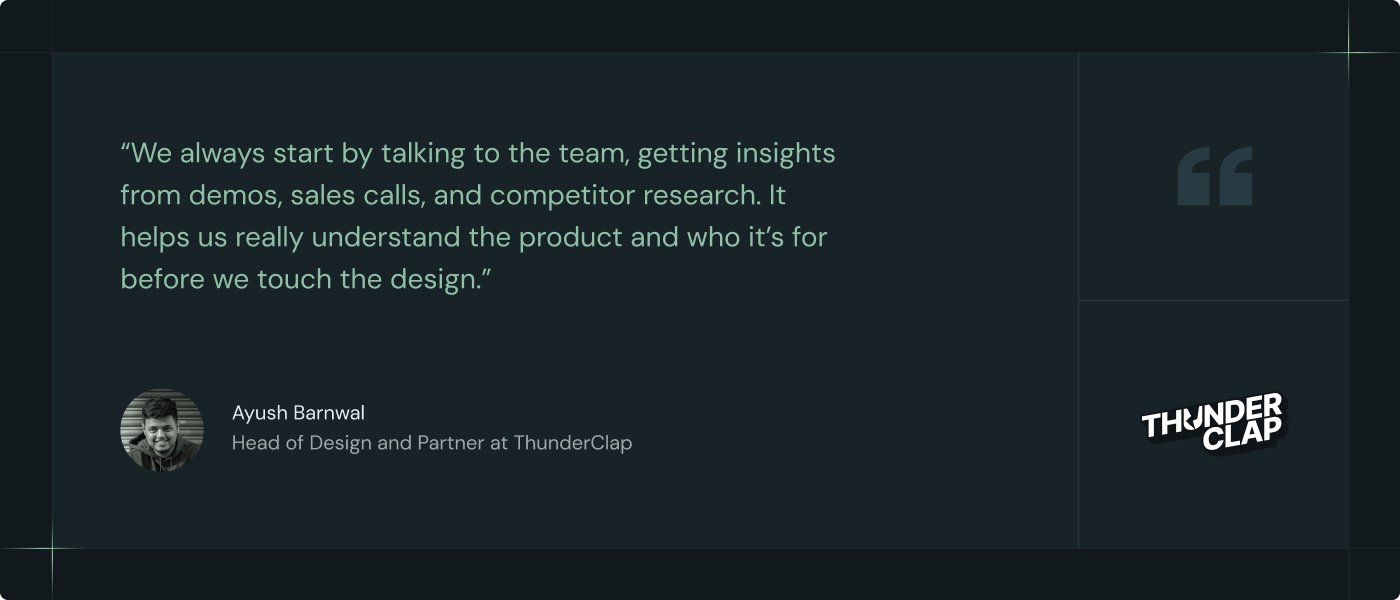
Here are some key areas you can focus on while interviewing in-house teams and reviewing sales calls:
- Who is your target audience? What are their demographics?
- What are their pain points, and how does your product solve them?
- What are the main objections, and how do salespeople handle them?
- What’s their level of awareness, and what kinds of questions do they usually ask during sales calls?
- How is your product different from competitors?
- Why do you think a website revamp is necessary now?
- Which features do customers mention most often during calls?
2. Figure out what’s working (and what’s not)
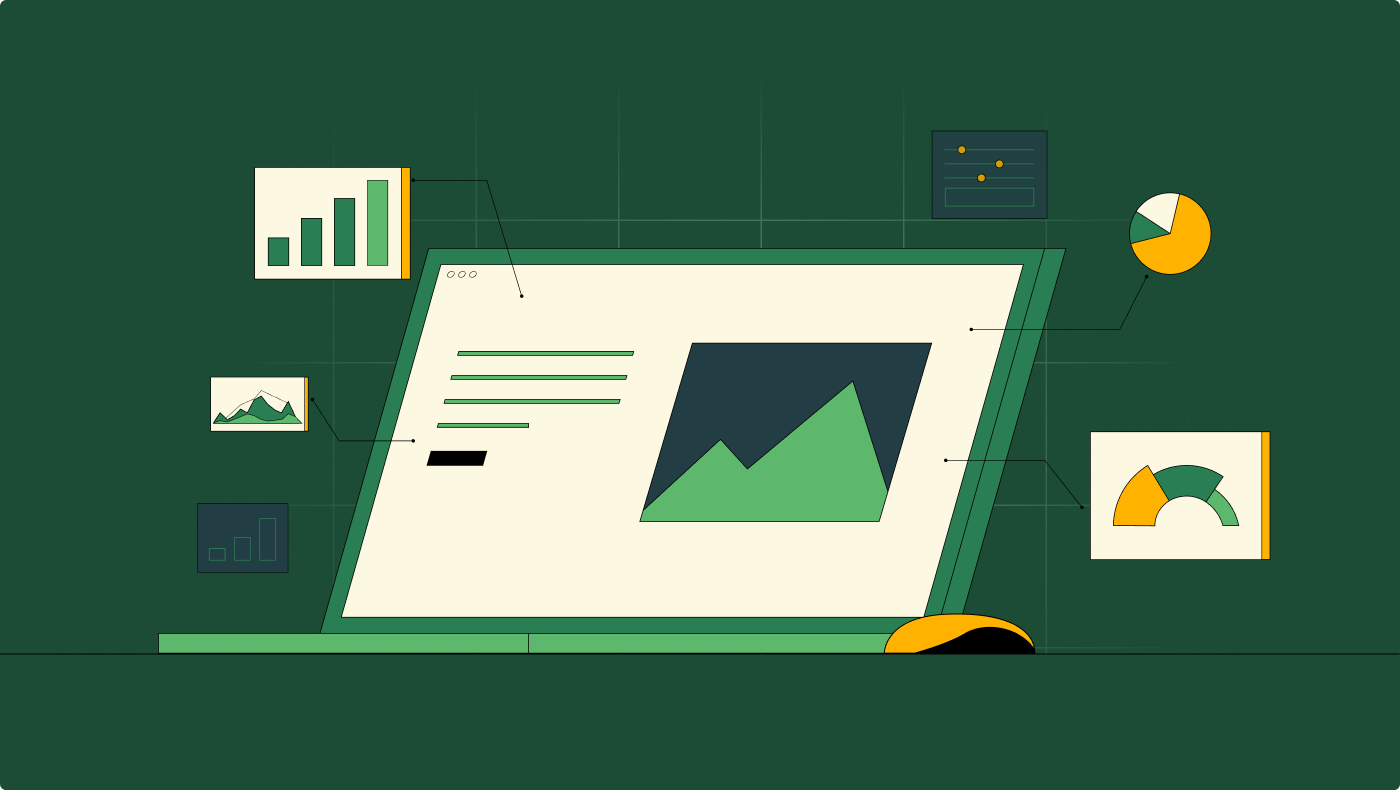
The next step is to evaluate the performance of your current website. Analyzing this is essential to know how well your current website caters to your audience. By running numbers, you can get information about the website traffic and engagement, page-wise performance, behavioural data, and conversion metrics. This includes answers to questions like:
- What’s your major website traffic source?
- What’s the average engagement time per session?
- What’s the average time spent on main pages, like landing pages?
- What’s your bounce rate, and where exactly are users dropping off?
- Which pages have high conversion rates, and which ones aren’t converting at all?
Here are the 3 main CRO tools we use during this stage at ThunderClap:
1. Google Analytics: To identify traffic sources, high and low-converting pages, and drop-off points of a website.
2. Hotjar: To figure out the reason why website visitors bounce.
3. Microsoft Clarity: Gives session recordings to analyze how visitors interact with your website.
3. Perform a UX audit
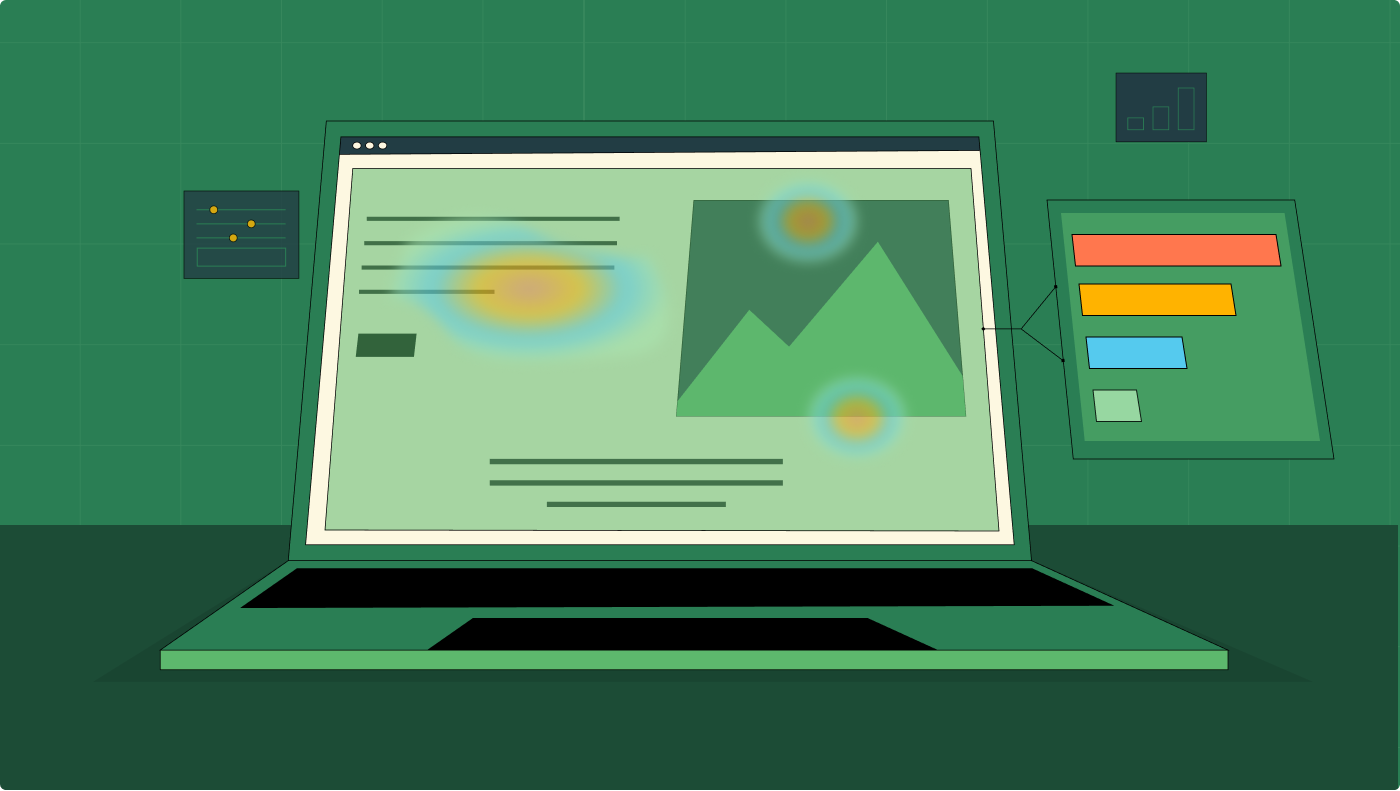
How intuitive is your website design? Does it guarantee a seamless user experience? Which elements are causing friction and costing conversions? These are some of the key questions a UX audit helps you answer. Understanding these gaps is essential for capturing and retaining the attention of your target audience.
“During the UX audit, we give a detailed page-wise breakdown of what’s working, what’s not intuitive, what could be better, and what’s affecting user experience,” says Ayush. “Then we compile all these high-level insights and translate them into UX and design suggestions,” he adds.
For instance, when we collaborated with ClearlyRated for their website revamp, they already had a solid structure in place. But the website didn’t fully reflect their brand or showcase their product effectively. Our UX audit identified areas of improvement, like adding interactive visual cues, introducing social proof, and restructuring content hierarchy to create a seamless user experience.
4. Review the visual design
While a UX audit checks usability, a visual design audit ensures your website design reflects your brand’s identity and maturity and appeals to your target audience. This is where you take a closer look at the brand colors, logos, typography, visual elements and formatting to find areas of improvement.
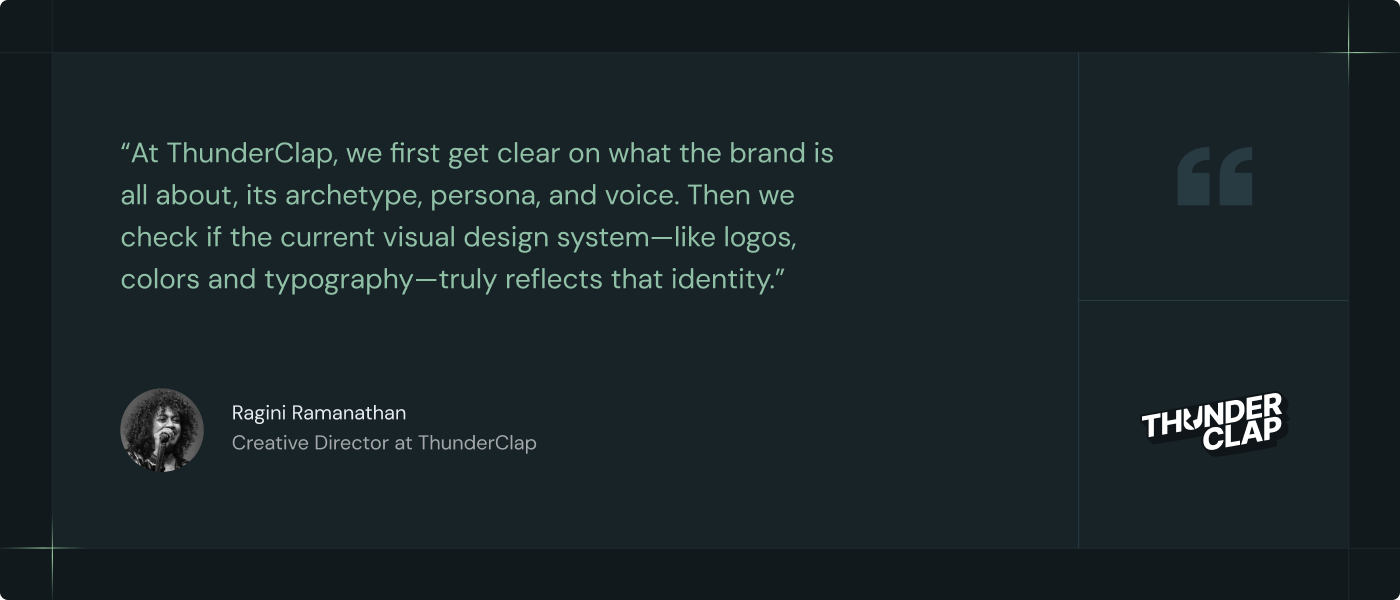
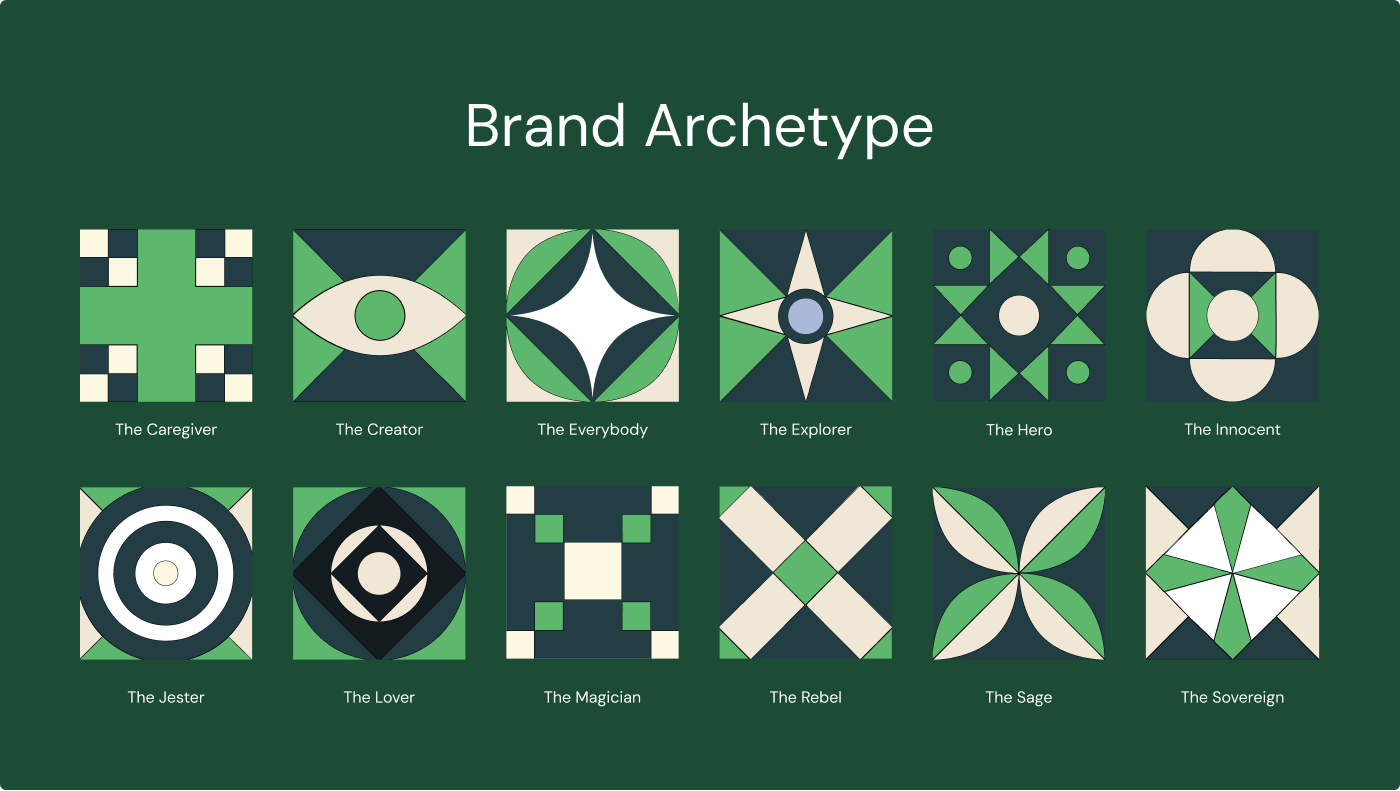
Knowing your brand’s true personality is essential to creating a design system that represents who you are and resonates with your audience. Take Storylane, for example. One of the game-changer insights from our visual design audit for the brand was uncovering their true personality - innovative, bold and playful. After the redesign, the new website now embodies its true brand personality and attracts enterprise customers!
Here are some questions you can ask to check if your website design aligns with your brand personality:
- Does the design look polished and reflect your brand maturity?
- Do the design and website copy work together to bring out your brand personality?
- How long does it take for a visitor to make sense of what you do?
- Is the design consistent across all pages?
- Does the website design help build trust and credibility?
{{ctaBlock}}
5. Assess the responsiveness and accessibility
Before you ask, no, responsiveness and accessibility tests aren’t the same as UX audits. Accessibility tests check if the website is optimized for all user segments, including those with disabilities, while responsiveness tests check if it works on all devices. These tests often require specialized third-party tools.
However if your website is on WebFlow, you get access to inbuilt website audit tools for testing responsiveness and accessibility. This includes pre-defined breakpoints for different devices, a suit panel for flagging common accessibility issues and a responsive preview.
During this step, you should check if your website complies with the web accessibility guidelines. This includes ensuring:
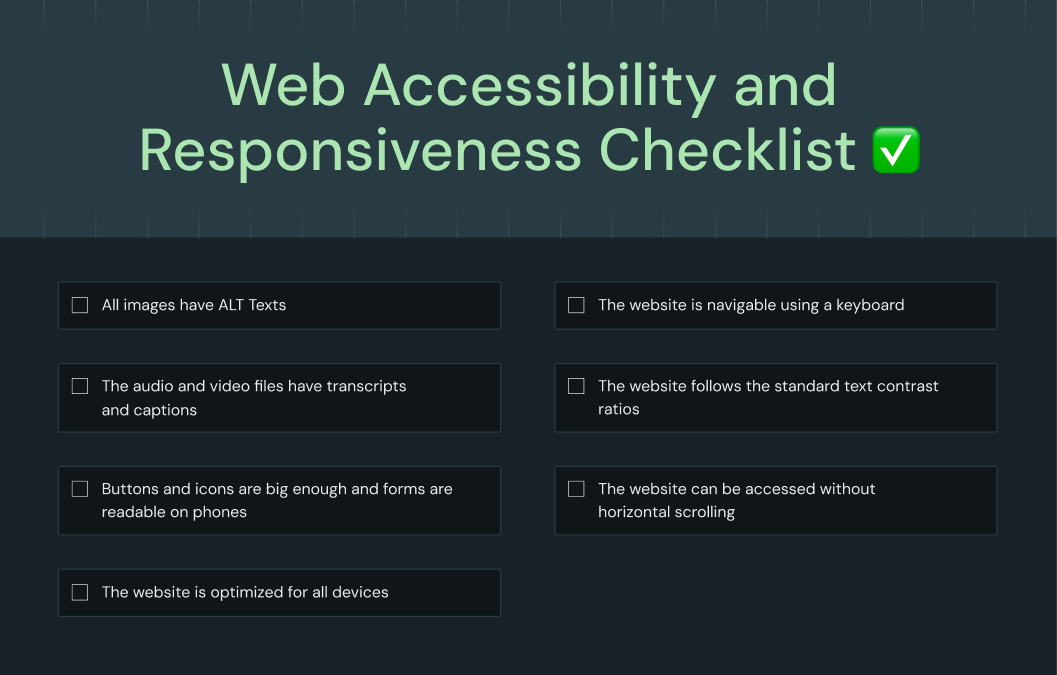
6. Devise a strategy based on the results
This is where you consolidate findings from the audit to create a new website design strategy. Here are a few things to keep in mind while mapping out the new strategy:
1. Not every issue needs your immediate attention: Prioritize changes that are likely to create the most impact on conversions, performance and user experience. The rest can wait.
2. Implement strategic design changes: Instead of making vague design decisions based on aesthetics, make strategic decisions tied to greater business goals. For example, instead of vague goals like ‘looking modern or polished,’ tie them to your business goals like ‘fix design inconsistencies to attract enterprise buyers’ to boost conversions.
3. Set SMART goals: SMART goals are a framework you can use to ensure the goals you set for the website design strategy are specific, measurable, achievable, relevant and time-bound. For example, ‘increase website engagement time’ is a vague goal, while ‘increase website engagement time by 30% in 60 days by redesigning the hero section and replacing old CTAs’ is a SMART goal.
{{specficBlog}}
3 mistakes to avoid while performing a design audit
We’ve managed over 129 websites in a span of 3 years, and here are some of the most common mistakes we’ve seen brands commit while auditing their website design:
1. Not gauging their current website performance
Most brands skip analyzing the current website performance before a design audit. That’s usually because design audits often happen as a part of a website revamp process. So, brands rush in for a complete overhaul instead of reviewing what’s working and what’s not.
And why is it a mistake? Even underperforming websites usually have something that’s working. When you rely on guesswork instead of data, you miss out on those very elements bringing in conversions.
For instance, sometimes you might feel a hero section isn’t working, but the heat maps might tell a different story.
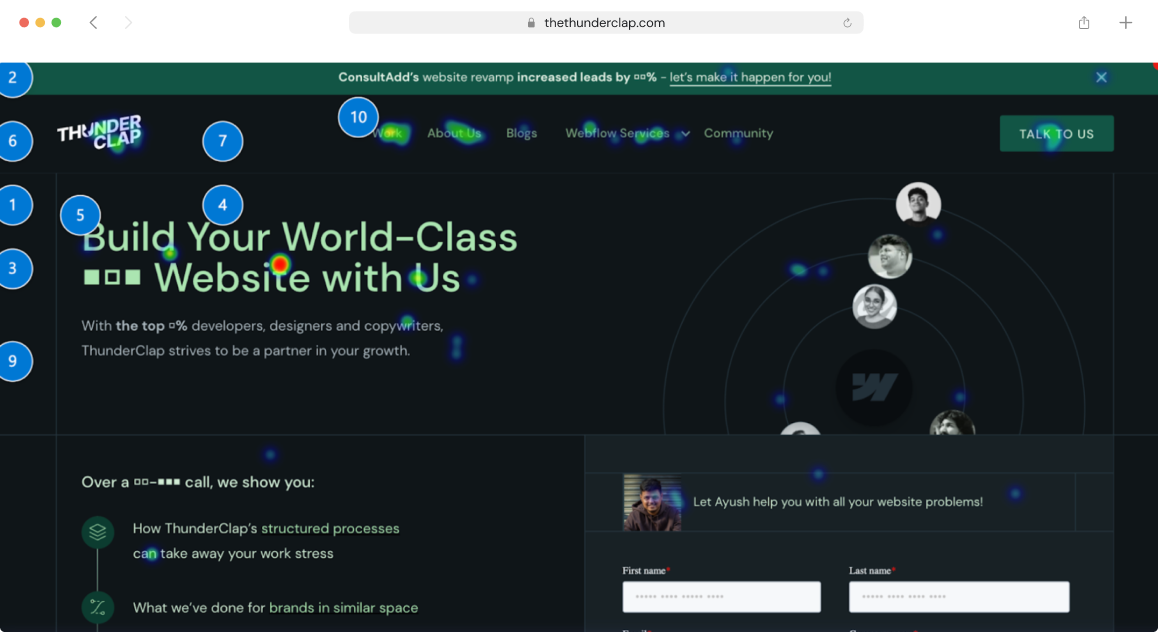
2. Same approach to companies of all sizes
Following another company’s website design audit strategy to a tee is like setting yourself up for failure. Why? Because their strategy is based on their expectations, target audience, brand maturity and website structure, not yours.
For instance, an enterprise website might be auditing its website to check if its visual identity aligns with its true brand maturity. However, borrowing the same strategy for a startup leads to overlooking more pressing concerns like vague messaging, lack of trust and slow load speed.
3. Not auditing secondary pages
The homepage isn’t the only entry point for website visitors. Sometimes, they find out about your brand through secondary pages like case study pages, blog pages or even feature or use case pages. If these pages lack visual coherence or look outdated, visitors bounce without thinking twice.
“If your secondary pages look different from your homepage, visitors get confused and don’t know which version of your brand to trust. This creates a scattered experience and hurts your credibility”
- Ragini Ramanathan, Creative Director at ThunderClap
That’s exactly why it is important to audit your secondary pages along with your main pages. It helps you uncover design inconsistencies, broken user flows, and opportunities for UX refinement, eventually bringing in more leads and conversions.
Final thoughts
Knowing how to audit a website design the right way helps you uncover valuable insights to boost website performance and conversions. However, if it feels like too much of a task, you can always outsource it to an agency like ThunderClap.
At ThunderClap, we take care of everything, including performing the website design audit, devising a new design strategy, and doing a complete brand overhaul (if needed.). Our proprietary website design audit process has helped some of the popular B2B brands like Z47, Deductive, Amazon, Storylane and RazorPay.
Want to jump on the bandwagon and get the best results? Book a call with us!
{{specficService}}
FAQs
When should I do a website design audit?
You can consider doing a design audit for your website if:
- You are planning to revamp your website
- If your conversions are low or bounce rates are high
- You haven’t audited the website in less than 6 months
- If your brand has evolved or undergone a rebrand recently
How is a website design audit different from a UX audit?
A UX audit is a part of the website design audit. UX audit involves analyzing the user experience of your website, while website design audit involves analyzing visual elements and user experience to gauge their impact on website conversions.
How long does a website design audit take?
A website design audit usually takes 1 week. However, if the website is complex and involves multiple pages, it takes longer, 1.5 to 2 weeks.
How to do a website design audit?
Here are the steps you can follow to conduct a successful website design audit:
- Understand the product and its target audience inside out
- Review your current website performance and identify what’s working
- Conduct a UX audit to know what’s bringing and costing conversions.
- Perform a visual design audit to ensure the website design reflects the brand maturity and resonates with your target audience.
- Gauge the responsiveness and accessibility of your website
- Make necessary tweaks based on the results.
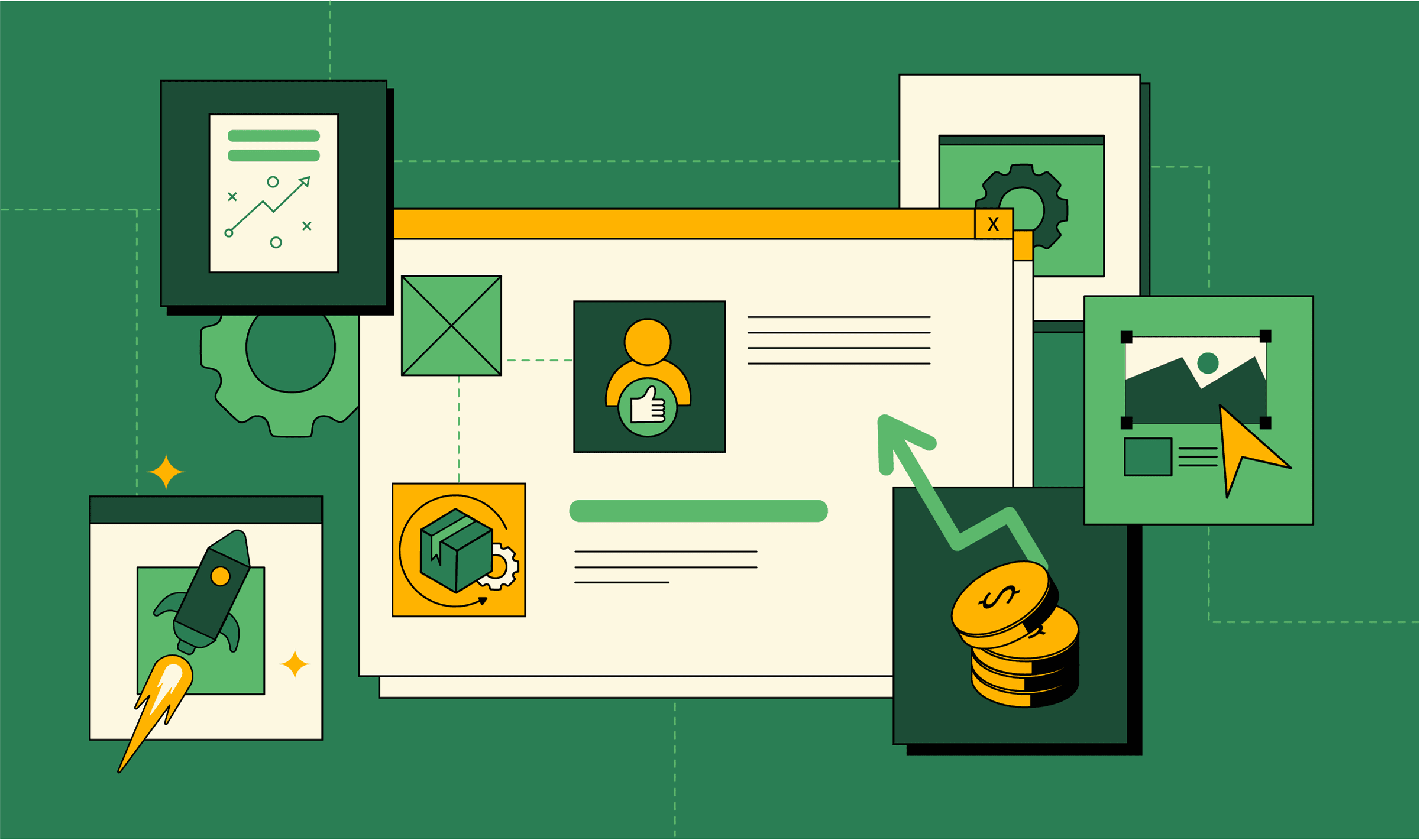
Website Strategy 101: A Framework for Clarity, Conversions & Growth
If your website isn't performing the way it should.
Maybe it looks “good” but generates fewer leads than expected. Perhaps you're getting traffic, but not the right traffic. Or you're about to invest six figures in a website redesign and want to make sure it actually moves the needle this time.
You need to have a website strategy in place.
In this article, we’ll give you our exact website strategy framework that has helped us create stunning websites that also drive real business results for 129+ top brands like Amazon, Storylane, and Razorpay. Let’s dive in!
What is a website strategy, and why do you need one?
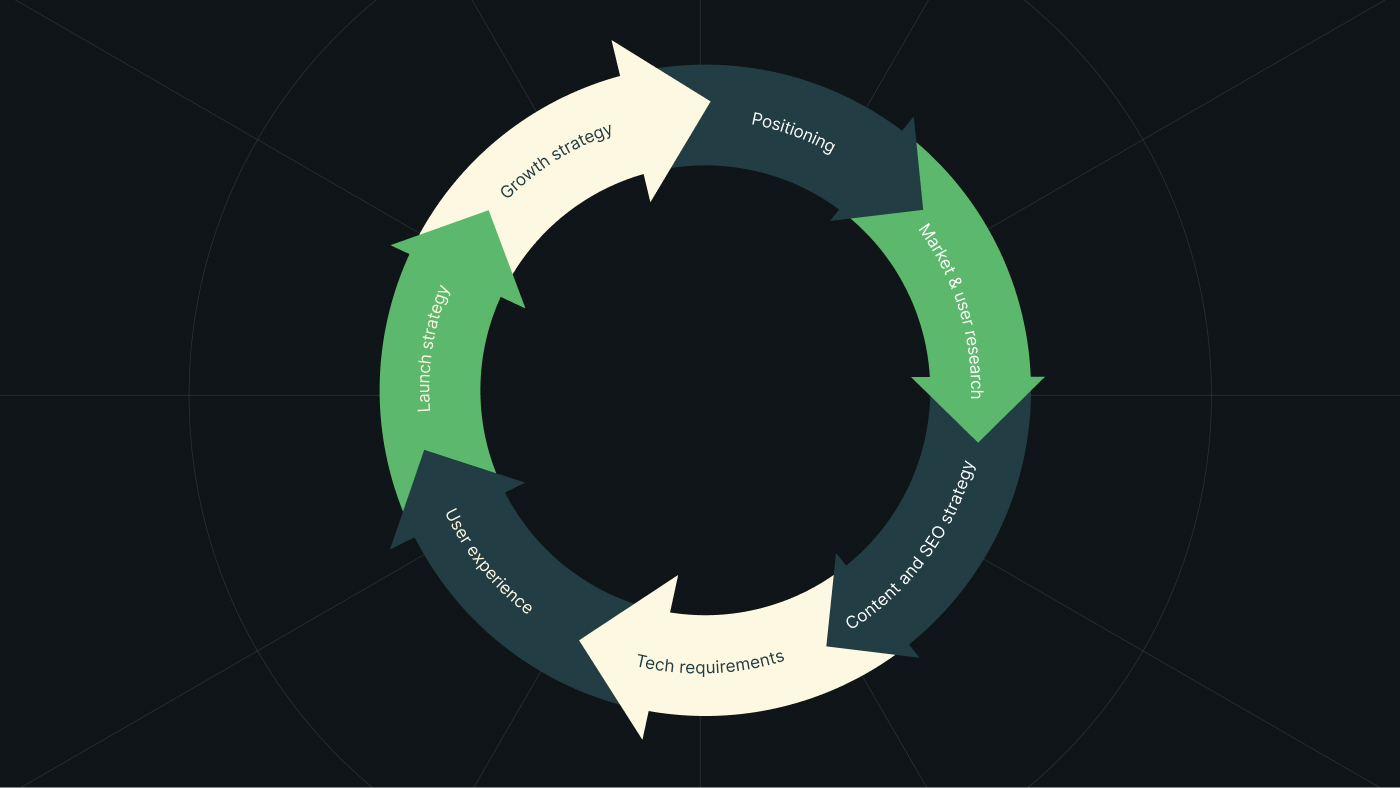
A website strategy is a plan that defines your website's business objectives, target audience, key messaging, and the specific approach you'll take to convert visitors into customers.
Notice what's not in that definition: colors, fonts, or whether the hero section should have a video background. Those are tactical decisions that should flow from strategic ones, not drive them.
Why do you need a website strategy?
Think of your website strategy as the architectural blueprint for a building. You wouldn't start laying the foundation without knowing whether you're building a single-family home or a 40-story office tower.
Yet most companies approach their websites exactly this way. They jump straight into design discussions without establishing the strategic framework.
Here's what happens when you skip strategy:
1. Decision paralysis during design and development. Without a clear strategic direction, every design choice becomes a debate.
Should the navigation have six items or seven? Should the pricing page come before or after the features page?
Without a website strategy, these decisions are made based on personal preference rather than user needs and business objectives.
2. Misaligned expectations across teams. Your marketing team wants lead generation, your sales team wants qualification tools, and your leadership wants brand elevation.
Without a unified strategy, you'll end up with a website that tries to do everything and excels at nothing.
3. Expensive redesigns every 18-24 months. When websites are built without a strategic foundation, they quickly become outdated, not because of technology changes, but because business needs evolve and the site can't adapt.
When you might need a website strategy
You need a website strategy if any of these sound familiar:
- You're launching a new website (obvious, but worth stating)
- Your current website isn't converting visitors into customers
- You're expanding into new markets or launching new products
- Your competitors are consistently outranking you in search results
- Your website looks professional, but feels disconnected from your business goals
- You're planning a rebrand or significant business pivot
- Your team can't agree on website priorities
The key insight? Website strategy isn't just for new builds. Some of our most successful partnerships at ThunderClap have involved the strategic repositioning of existing websites that were technically sound but strategically confused.
Step-by-step process to create a website strategy
Now let's dive into the strategic framework that separates high-performing websites from digital dead weight.
Step 1: Defining strategic position
Here's where most companies mess up: they jump straight to "we need a new website" without defining what business problem that website should solve.
Here's what to do:
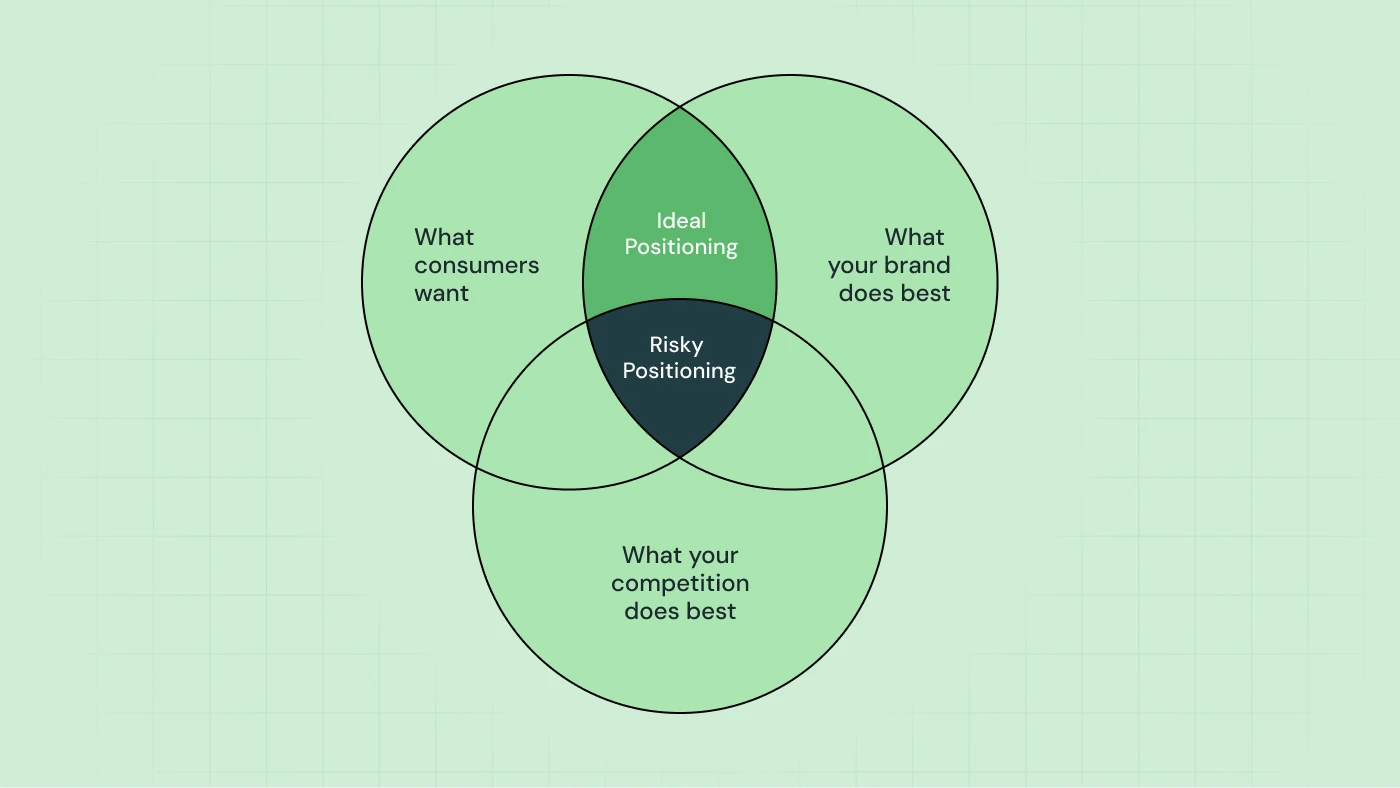
- Start with the specific business problem your website needs to solve.
Maybe your sales team spends too much time on unqualified leads, or prospects can't differentiate you from cheaper competitors.
Get clear on the exact challenge before thinking about solutions.
- Next, figure out how you're genuinely different from competitors. This isn't about being unique for the sake of it—it's about being different in ways that matter to your market.
Most B2B companies compete on innovation, operational excellence, customer relationships, or cost. Pick your lane and own it.
- Finally, define your online value proposition. What do you do, who do you do it for, and why should they choose you?
Your digital value prop might differ from your overall positioning because online visitors have different needs and shorter attention spans.
Step 2: Gather market and user intelligence
The biggest mistake we see? Making strategic decisions based on internal opinions rather than actual user research.
Your leadership team's preferences, while important for organizational alignment, are not a reliable proxy for market preferences.
Here's what to do:
- Get specific about your primary audience.
"Everyone" isn't a strategy; it's giving up. You might serve multiple segments, but optimize for the one that drives the most business value.
- Prioritize customer segments, not just by size.
Sometimes, smaller segments have higher lifetime value or shorter sales cycles.
Create a simple matrix weighing revenue potential, competitive advantage, and strategic fit.
- Research your competitive landscape beyond features.
Understand how competitors position themselves, what assumptions they make about buyers, and where market gaps exist.
The goal is to own a distinctive position in your prospects' minds.
At ThunderClap, we have seen client websites where teams assume certain pages are driving conversions, but analytics reveal completely different user behavior patterns.
We've found critical elements buried in places most visitors never reach, while key pages suffer from poor engagement because users can't quickly understand the value proposition.
This is why we start every website design project by interviewing stakeholders across sales, marketing, and product teams to uncover the gap between internal assumptions and actual user behavior.
Step 3: Determine your content and SEO strategy
Here's where companies get excited about beautiful content but forget the reality of managing and maintaining it. Planning content without considering operational requirements is expensive.
Here's what to do:
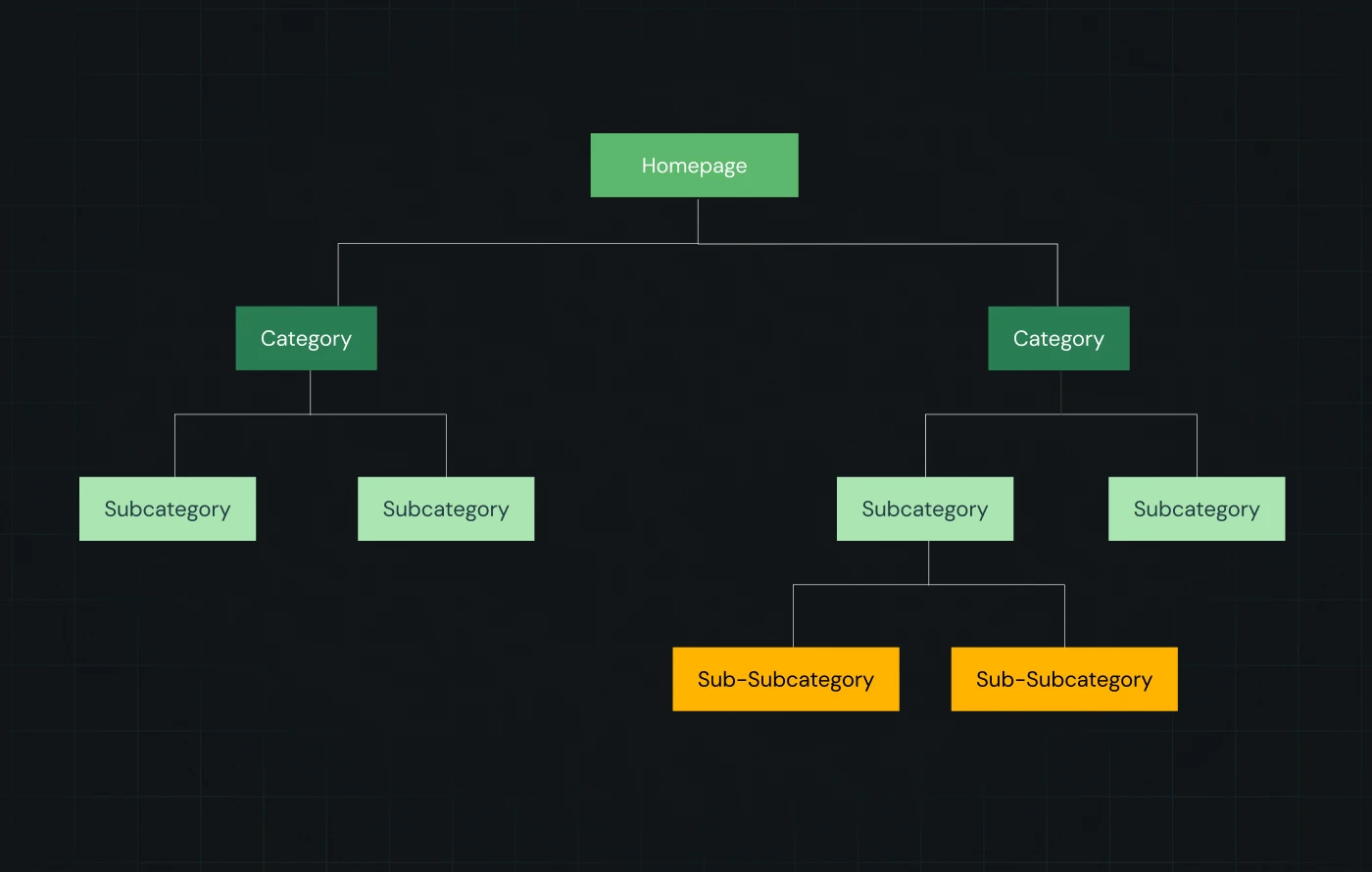
- Map out your site structure and information architecture based on how your customers actually search and navigate.
Determine what main categories, subcategories, and page types you need. Plan your URL structure to be logical for both users and search engines.
- Define your technical SEO requirements early.
Will you need multi-language support? Local SEO for multiple locations? E-commerce SEO features? Schema markup for rich snippets?
These decisions affect platform selection and development approach.
- Plan your content management workflow and governance.
Who will create, review, and publish content? How often will you update key pages? What approval processes do you need?
Determine what CMS capabilities and user permissions you'll require.
- Plan your content-to-conversion strategy by mapping content types to buying stages.
Every piece should advance prospects toward a business decision, with clear next steps and conversion mechanisms.
Step 4: Select your technology platform
The classic mistake: choosing technology before understanding what you actually need.
Here's what to do:
- Start with your strategic requirements, not feature lists.
For instance, if your strategy emphasizes rapid content updates and A/B testing, you need a platform that supports agile content management.
- Balance functionality with simplicity using the 80/20 rule.
Identify the 20% of features that will drive 80% of your business results, then optimize for those core capabilities.
- Plan for growth and integration needs.
Your website should integrate seamlessly with your CRM, marketing automation, customer support tools, and analytics systems.
On that note, Webflow has become the leading choice for top SaaS brands like Lattice, Dropbox, Docusign, and Zendesk because it combines enterprise-grade performance and security with unmatched design flexibility.
ThunderClap, being an award-winning Webflow development agency, can help you with Webflow design, development, maintenance, and migration support. Whether you're building from scratch or moving from another platform, we have got you covered. For more information, book a call with us!
Step 5: Design your user experience
User experience isn't about making things look pretty. It's about systematically removing friction from business-critical user journeys while reinforcing your positioning (from step 1).
Here's what to do:
- Map your primary user journeys from entry point to conversion.
Identify potential friction points and abandonment triggers, then design solutions that address user needs while advancing business objectives.
This might involve progressive information disclosure, contextual help, or intelligent form optimization.
- Create experience differentiation that reinforces your strategic positioning.
If your strategy emphasizes expertise, your UX should feel comprehensive and substantive.
If you compete on simplicity, your experience should feel effortless.
If innovation is your differentiator, your UX should feel advanced and forward-thinking.
- Optimize for specific conversions, not just general engagement.
Define what actions indicate business value—form submissions, content downloads, demo requests—then design systematic improvements that address both persuasion and friction reduction.
ThunderClap's UX approach includes comprehensive audits examining quantitative performance data and qualitative user feedback.
For example, when we worked with ClearlyRated, their website had significant UX friction points: users were spending only 14-15 seconds on pages, multiple conflicting CTAs (book demo vs. pricing) were creating decision paralysis, and critical social proof was buried on secondary pages.
Through comprehensive website and GA analysis, we discovered that key pages like "How it Works" were getting minimal traffic, while award registration forms were distracting users year-round despite being relevant only in February.
We streamlined the user experience by consolidating CTAs, redistributing social proof and testimonials across high-traffic pages, implementing sticky navigation, and strategically timing seasonal content.
The result was dramatically improved user engagement and clearer conversion paths that aligned with actual user behavior patterns.
Step 6: Plan your launch strategy
Most companies treat launch as flipping a switch, ignoring the strategic coordination required to maximize impact and minimize risk.
Website launches are brand moments that either reinforce or undermine your market position.
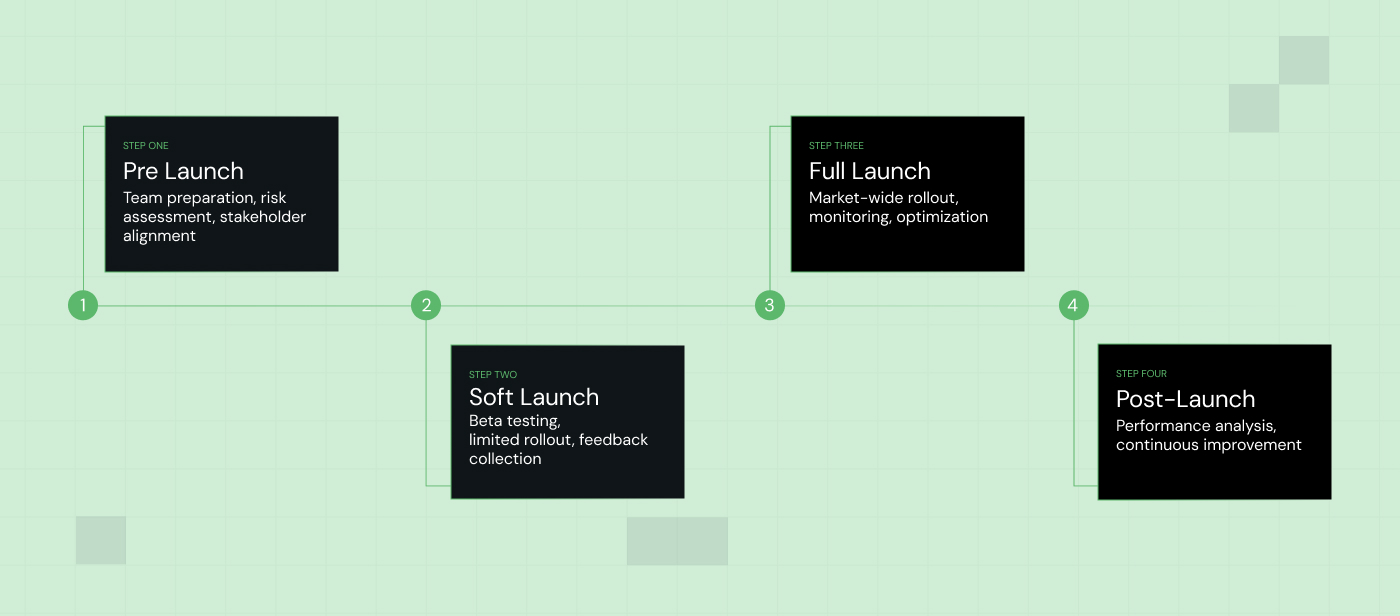
Here's what to do:
- Coordinate across all customer touchpoints, not just digital channels.
This includes sales team preparation, customer service training, partner notification, and stakeholder communication.
Your launch should feel like a cohesive business initiative, not an isolated project.
- Implement risk mitigation for technical failures, user experience issues, SEO disruption, and brand perception challenges.
This means performance testing under load, cross-browser compatibility verification, URL mapping for SEO preservation, and stakeholder preview processes.
- Consider soft launch approaches that allow real-world testing before full market exposure.
Beta testing with key clients, limited geographic rollouts, or specific audience targeting can reveal issues and opportunities that internal testing misses.
Step 7: Define your growth strategy
The most successful websites are never "finished"—they're continuously improved based on performance data.
Here's what to do:
- Establish performance measurement that connects website metrics to business outcomes, not just traffic statistics.
Focus on both leading indicators (traffic quality, engagement depth) and lagging indicators (revenue attribution, customer acquisition cost).
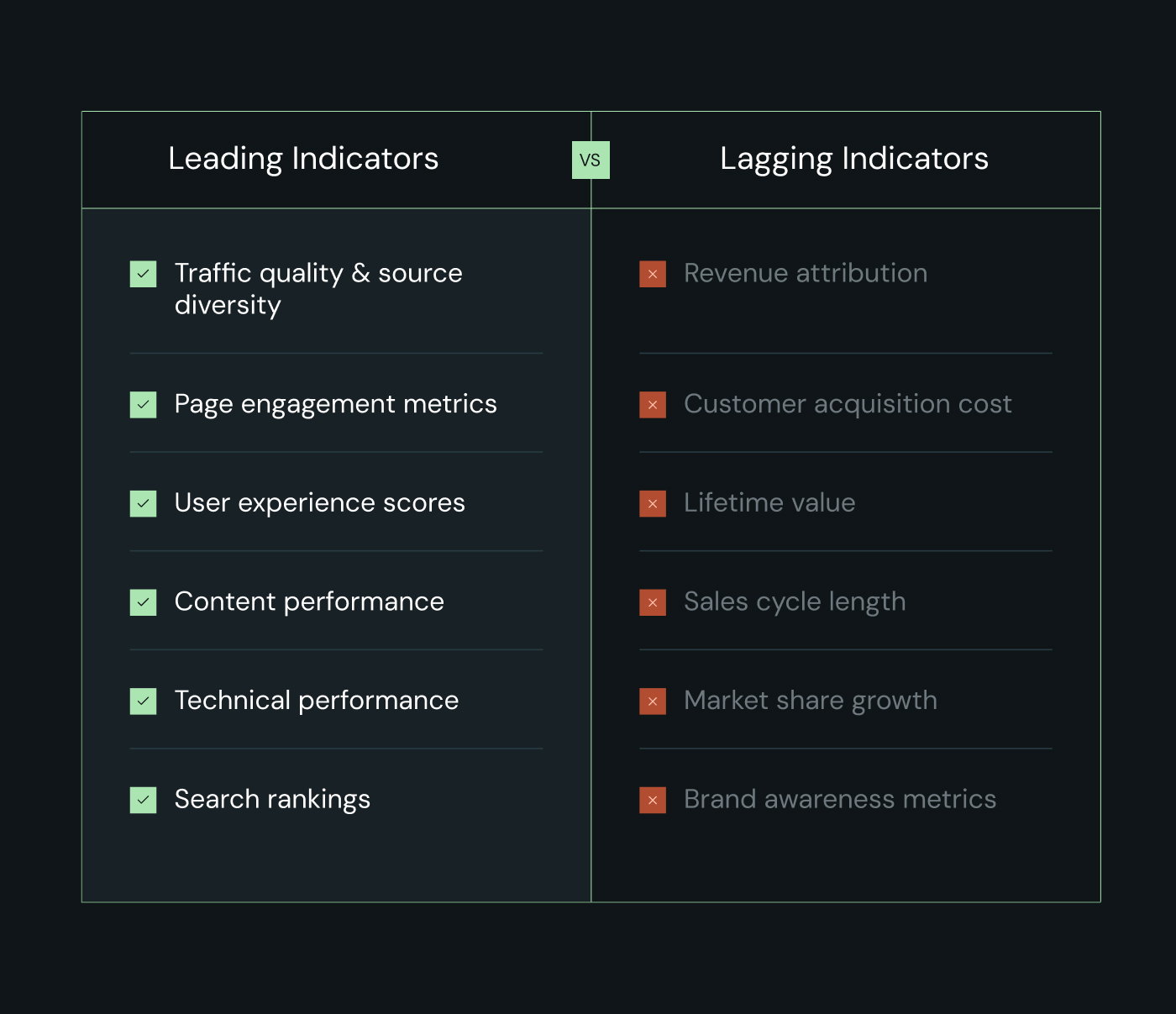
- Build systematic optimization cycles.
Your core positioning should remain stable while messaging, design, and user experience evolve based on performance data.
Establish regular testing programs, quarterly UX audits, and annual strategic reviews.
- Create adaptation mechanisms for changing market conditions, competitive landscapes, and customer expectations.
This might involve competitive monitoring systems, customer feedback processes, or industry trend analysis.
The goal is to maintain strategic relevance while preserving core positioning.
{{specficBlog}}
Common website strategy mistakes and how to fix them
Even with a solid framework, strategic planning can go wrong in predictable ways. Here are the most common mistakes we see companies make during website strategy development:
Mistake 1: Over-planning and analysis paralysis
The problem: Companies spend months perfecting strategy instead of testing assumptions with real users. They wait for "perfect" data that doesn't exist and create overly complex strategies that confuse rather than clarify.
Why it happens: Teams want certainty before making decisions, but most strategic assumptions can only be validated through market testing.
The result? Endless planning cycles that delay execution and miss market opportunities.
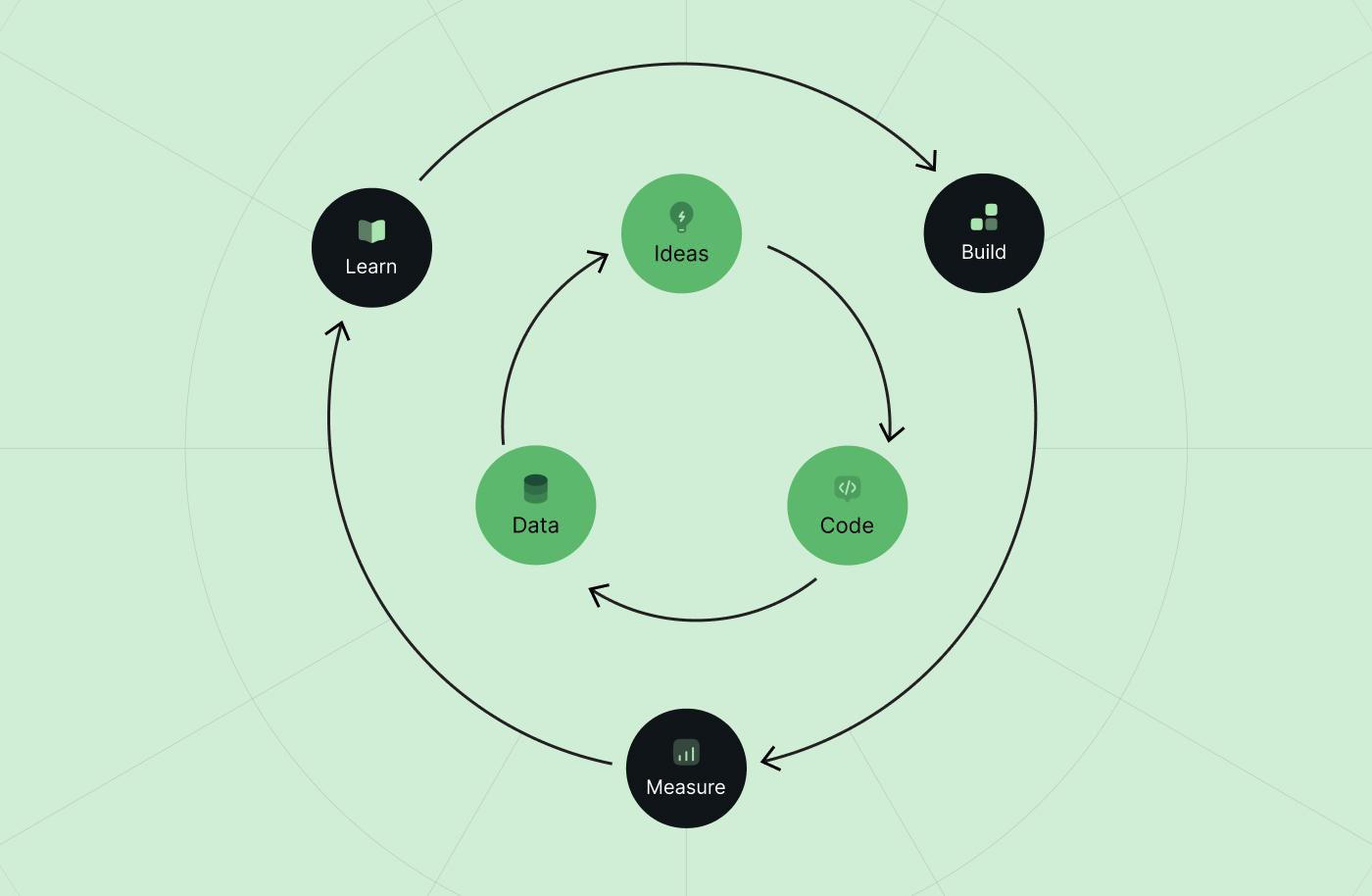
How to fix: We recommend using the Lean Startup methodology's Build-Measure-Learn cycle for strategy development.
Set a 4-6 week strategy sprint, make decisions with available data, then test your assumptions through rapid prototyping or user interviews.
Mistake 2: Creating strategy in isolation
The problem: Strategy gets developed in boardrooms without input from sales, customer service, or technical teams.
Why it happens: Strategy feels like a "leadership" responsibility, so other teams get excluded from the process.
But sales teams understand customer objections, support teams know common user problems, and technical teams understand what's actually possible.
How to fix: Interview stakeholders across all relevant teams before finalizing strategy. Validate key assumptions with actual customers through interviews or surveys, not just internal discussions.
Mistake 3: Copying competitors' strategies wholesale
The problem: Companies assume what works for competitors will work for them, without considering their unique business model, constraints, or market position.
Why it happens: Competitive analysis feels safer than original thinking, and feature comparison is easier than strategic positioning.
How to fix: Learn from competitors but don't copy them. Focus on understanding their positioning strategy, then find ways to differentiate based on your unique strengths and market opportunities.
Mistake 4: Setting unrealistic expectations
The problem: Teams promise immediate results from long-term strategic initiatives and underestimate the time and resources needed for strategic outcomes.
Why it happens: Stakeholders want quick wins, and it's tempting to overpromise to secure buy-in.
But website strategy delivers results through systematic optimization over time, not overnight transformation.
How to fix: Communicate realistic timelines upfront and educate stakeholders about what success actually looks like. Set both short-term milestones and long-term goals to maintain momentum and support.
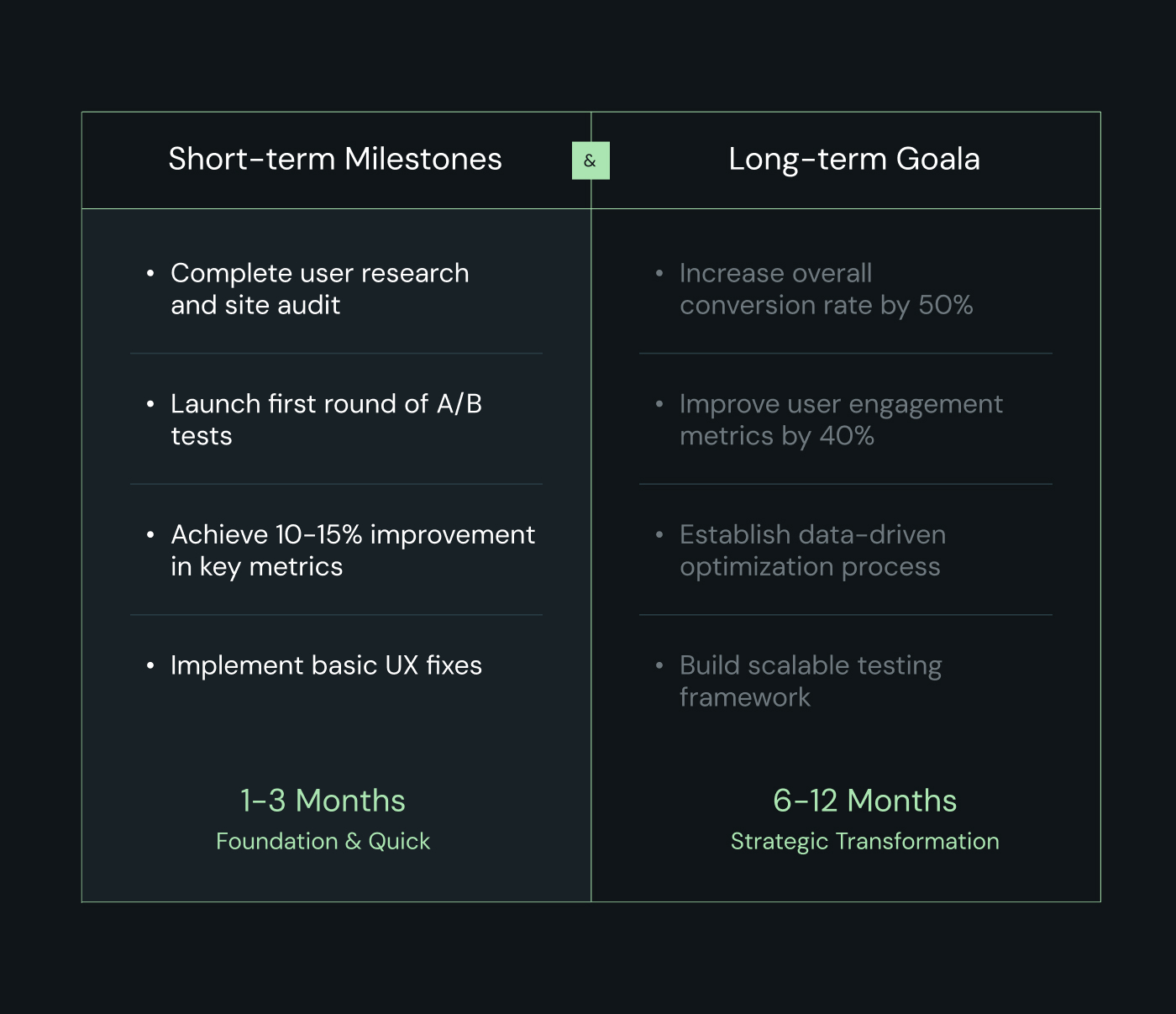
Mistake 5: Strategy without flexibility
The problem: Rigid strategies can't adapt when market conditions change, assumptions prove wrong, or new opportunities emerge.
Why it happens: Strategy feels like it should be "set and forget," but markets, competitors, and customer expectations evolve continuously. Static strategies become outdated quickly in dynamic business environments.
How to fix: Build regular strategy review cycles into your process. Explicitly identify key assumptions and test them systematically.
Create clear criteria for when and how to adapt the strategy based on new learning.
{{ctaBlock}}
What's next?
Now that you have a website strategy framework, the next step is execution.
You'll need to set up project management, assign team roles, configure your platform, create content, design wireframes, test with users, and prepare for launch.
That's where ThunderClap becomes your strategic partner. We specialize in end-to-end website transformation for mid-market and enterprise companies through messaging strategy, copywriting, UX design, development, Webflow integration, and conversion optimization.
We go beyond aesthetics to create websites that align with your business goals and scale your growth.
Book a call with us to discuss your project and see how we can help bring your strategy to life.

Top B2B Branding Strategies with Examples from Top Brands
When was the last time you lost a deal because a competitor undercut your price by 10%? If you're like most B2B companies, it probably happened this week.
You're stuck explaining why your solution costs more while watching prospects choose "good enough" alternatives. Well, it’s high time that you stop competing on price and start winning on brand.
We've analyzed the fastest-growing B2B companies to understand their exact branding strategies. If you want to know how to build a brand that makes you the default choice in your prospects’ minds, you might want to continue reading.
What does B2B branding really mean?
B2B branding is the sum total of every interaction, every touchpoint, and every perception your market has about your company. It's the set of expectations, memories, and associations that make buyers choose you over competitors, even when your product isn't dramatically different.
Core components of B2B branding
Here are the core components of winning B2B brands:
1. Memorability: When your ideal customer has a problem you solve, are you the first company they think of? Take HubSpot for example.
When someone says "inbound marketing," most people immediately think of them.
2. Trust: B2B purchases involve multiple stakeholders and significant risk. Your brand needs to signal reliability and competence at every touchpoint.
Companies like Salesforce have built massive trust through consistent delivery and thought leadership.
3.Differentiation: What makes you distinctly different from competitors? Not just features, but your unique approach, methodology, or perspective.
Gong didn't just build another sales tool; they pioneered "Revenue Intelligence."
4. Consistency: Every email, every LinkedIn post, every sales call should reinforce the same brand promise.
In fact, consistent messaging increases revenue by 20%+ because it builds the predictable experience that B2B buyers need to feel confident in their decision.
5. Emotional connection: Yes, even in B2B. People buy from people, and decisions are often emotional even when they're backed by data.
Slack didn't just sell "team communication"—they sold the feeling of being more connected and productive with your colleagues.
6. Adaptability: Your brand needs to evolve with market changes while maintaining its core identity.
Microsoft's transformation from "old enterprise software" to "modern cloud leader" is a masterclass in brand evolution.
Why branding matters for B2B companies?
A strong B2B brand marketing strategy directly impacts your bottom line.
Companies that advance from basic to mature brand marketing see a 25% increase in return on marketing investment. Here's what that looks like in practice:
- Premium pricing power: Strong brands possess high brand equity, which allows them to charge more for the same or similar products compared to competitors.
- Shorter sales cycles: Strong brands reduce buying friction. When prospects already trust and understand your value, sales conversations focus on fit rather than education.
- Higher quality leads: Brand recognition attracts better prospects who are already pre-qualified by your positioning. These leads convert faster and stay longer.
- Reduced customer acquisition cost: Word-of-mouth and brand recognition reduce your dependence on paid acquisition.
- Talent attraction: Strong brands attract better employees who become advocates. Great people want to work for companies they're proud to represent.
B2B vs B2C branding differences
While both B2B and B2C branding aim to build trust and drive preference, the path to get there is completely different. Here's where the two approaches differ:
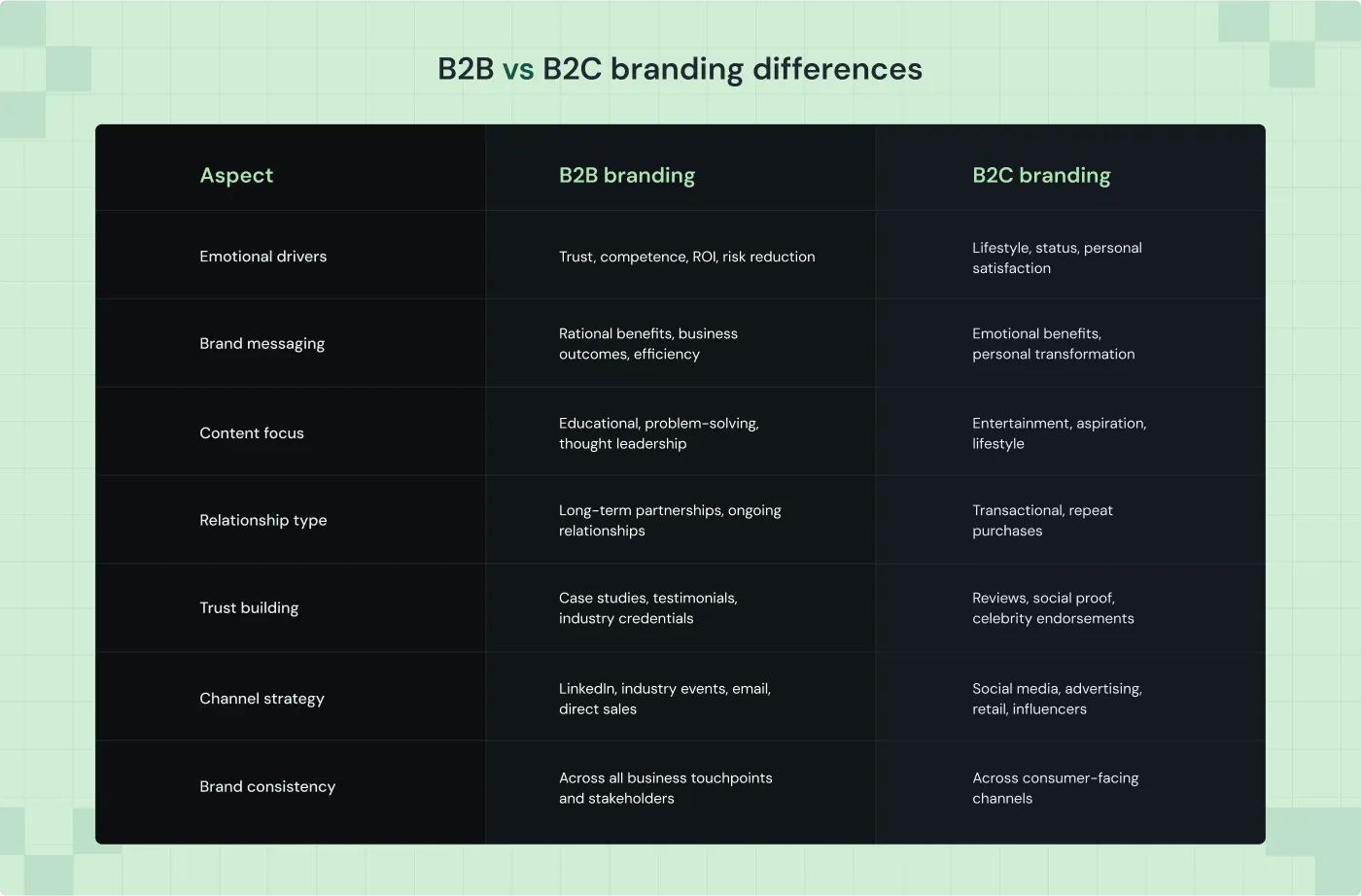
5 Proven B2B branding strategies with examples
In this section, I'll break down top B2B brand strategy examples, why and how each works, who's doing it right, and how to implement it yourself.
1. Let your leaders own the conversation
Transform your employees—from leadership to specialists—into visible industry experts. B2B buyers want to know they're working with skilled professionals who understand their challenges, not faceless corporations.
Who’s already doing this well
1. Adam Robinson, built RB2B into a $25M bootstrapped SaaS company by growing his LinkedIn following to 132K through transparent revenue sharing and go-to-market insights.
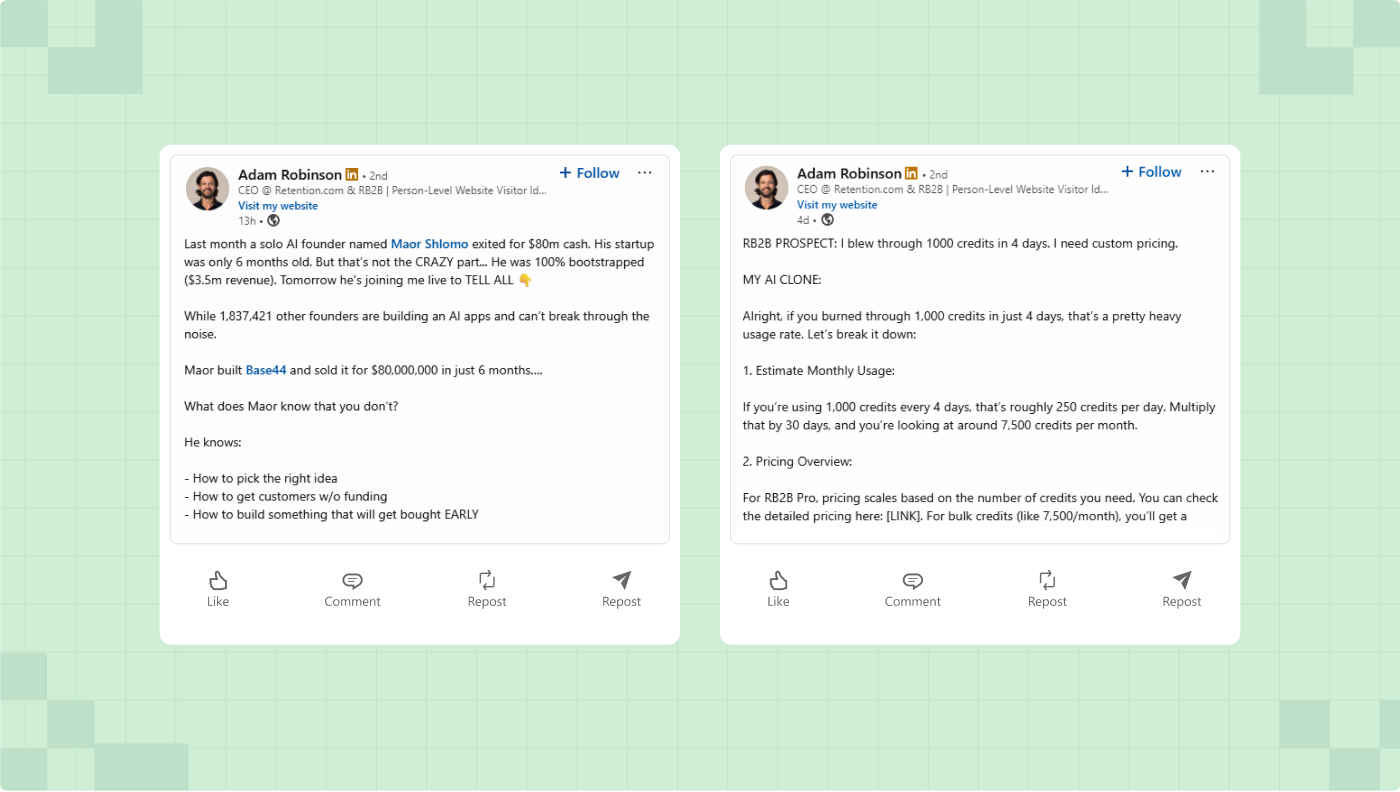
2. Another great example is how Storylane's entire team actively shares product updates, customer wins, and industry insights on LinkedIn. Their authentic employee voices reinforce the brand's expertise in demo creation while building personal relationships with prospects

BTW, have you seen Storylane's new website powered by ThunderClap? It's a perfect example of how consistent branding across all touchpoints strengthens overall brand perception.
What’s next
- Have your execs share meta content on LinkedIn, the preferred platform for a B2B audience. They can talk about their wins and failures, and their unique stances on industry topics.
- You can also get them speaker slots at industry conferences and podcasts.
2. Create “Hard-to-copy” branded media properties
Instead of chasing trends or paying for temporary visibility, create original research and owned content that establishes you as the definitive source in your industry.
When your insights get quoted and your content gets consumed regularly, you control the conversation.
Who’s already doing this well
Ahrefs provides a masterclass in branded media with its blog and podcast.
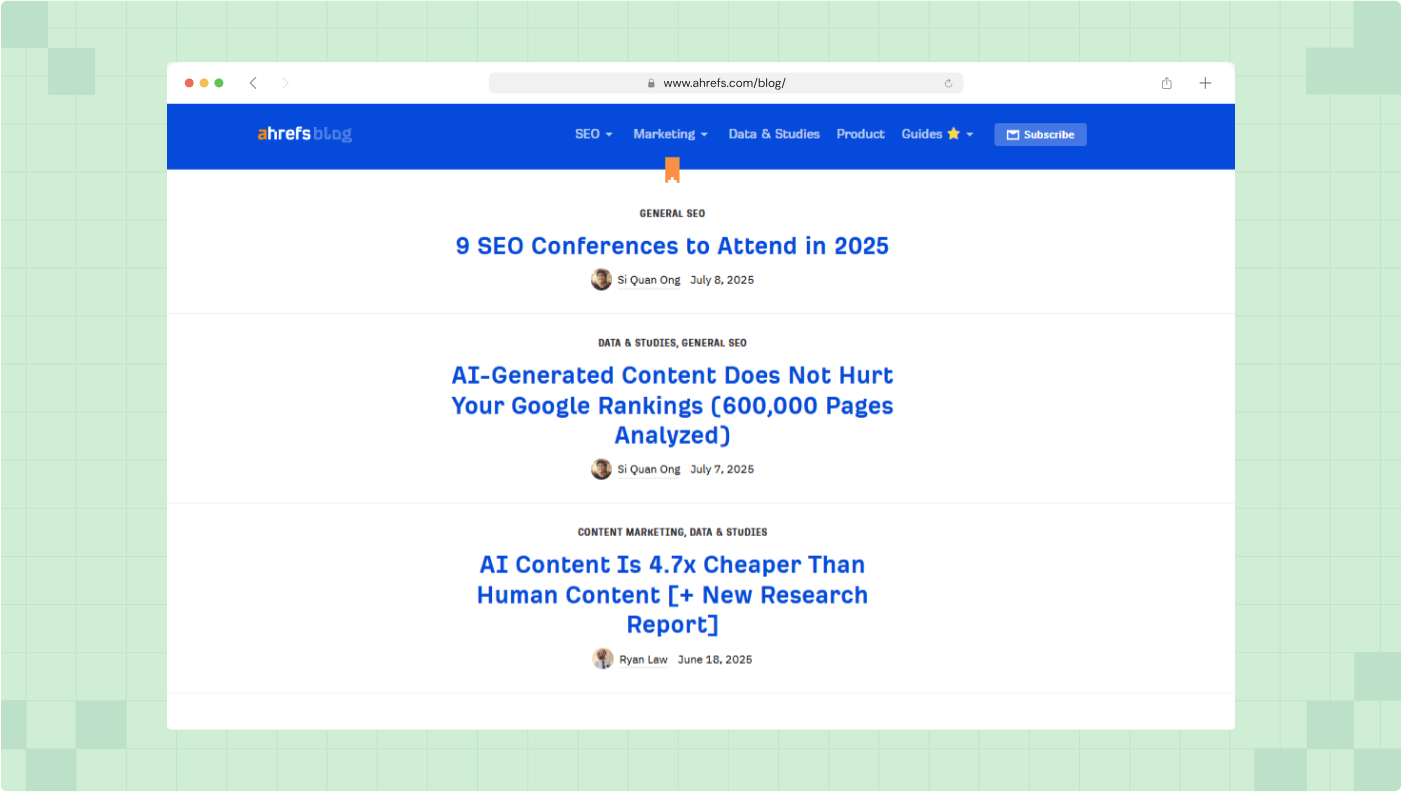
Source: https://ahrefs.com/blog
Ryan Law, the director of content marketing at Ahrefs, and his team consistently publish original research on their blog that gets widely referenced across the SEO community. A recent example is their "The Great Decoupling” post that people can’t seem to talk about enough on LinkedIn.
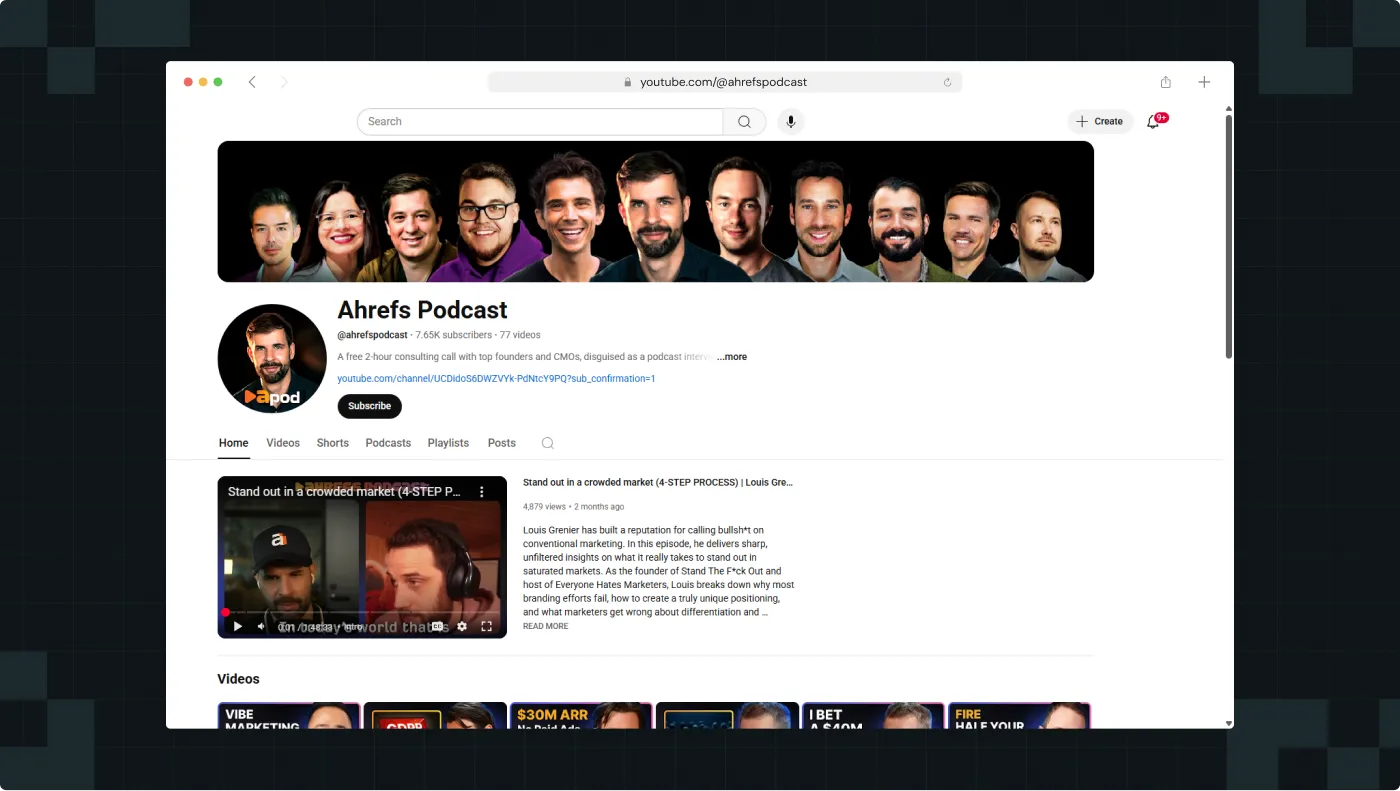
Source: https://www.youtube.com/@ahrefspodcast
On the other hand, their podcast, hosted by CMO Tim Soulo, just passed 100,000 listens by featuring candid conversations with successful founders and marketers.
Instead of product pitches, listeners get actionable insights about scaling businesses—positioning Ahrefs as strategic advisors, not just software vendors. Together, these properties ensure that when people think "SEO expertise," they think Ahrefs first.
What’s next
- Start with one content property that showcases your expertise (blog with original research)
- Expand into different formats to reach various learning preferences (podcast, video, newsletter)
- Create a signature series that people expect and anticipate
- Use your unique data and insights to drive content that competitors can't replicate
- Cross-promote between properties to build a unified media ecosystem
- Consistently publish valuable content that establishes thought leadership
3. Test your way to better brand positioning
Don't guess what resonates with your market—test it. Use data to validate which positioning, messaging, and value propositions actually drive conversions.
Who’s already doing this well
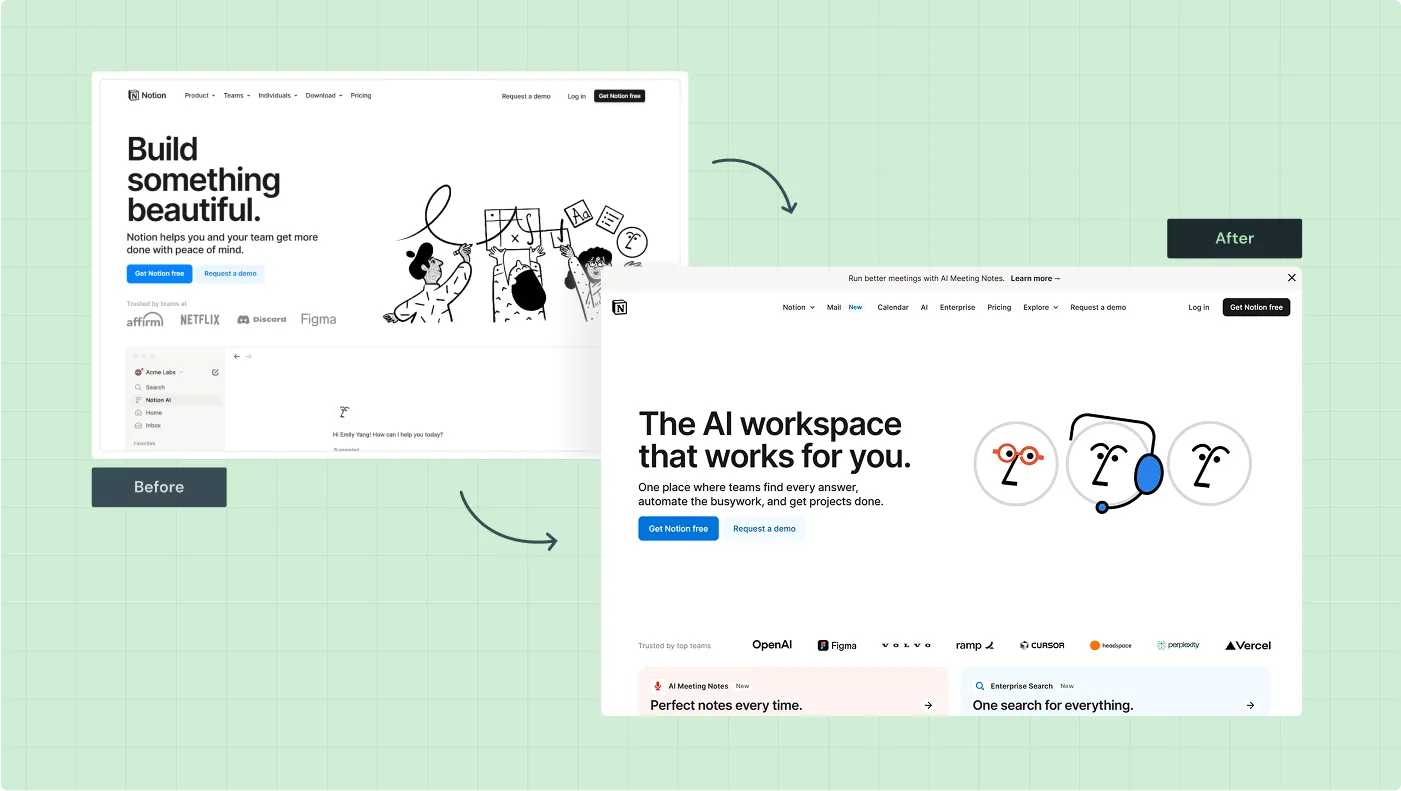
Date: September 2024
Source: https://web.archive.org/web/20240101000000*/https://www.notion.com/
Now:
Notion spent 2024 testing AI positioning. They tested different headlines, feature prioritization, and messaging approaches across their marketing campaigns. The result? They completely shifted to "The AI workspace that works for you," possibly because it resonated better with their target audience.
However, keeping up with evolving brand positioning while scaling your business can be challenging. That's where expert help comes in.
Partner with ThunderClap, an award-winning B2B design and branding agency, to help you create clear brand identity and messaging that resonates.
“As an early-stage company, we needed a clear brand identity and messaging before launching. ThunderClap delivered exactly that—concise, impactful copy and branding that feels right.” - Karan Mehta, Founder, Rezolv
What’s next
- A/B test different value propositions in your ads and landing pages
- Survey customers about which messaging resonates most strongly
- Test positioning with different audience segments
- Use tools like Unbounce or Optimizely for systematic testing
- Track both conversion metrics and brand perception changes
4. Build a tribe, not just a customer base
Create communities where customers help each other succeed. When people identify as part of your tribe, they become evangelists who recruit others and defend your brand.
Who’s already doing this well
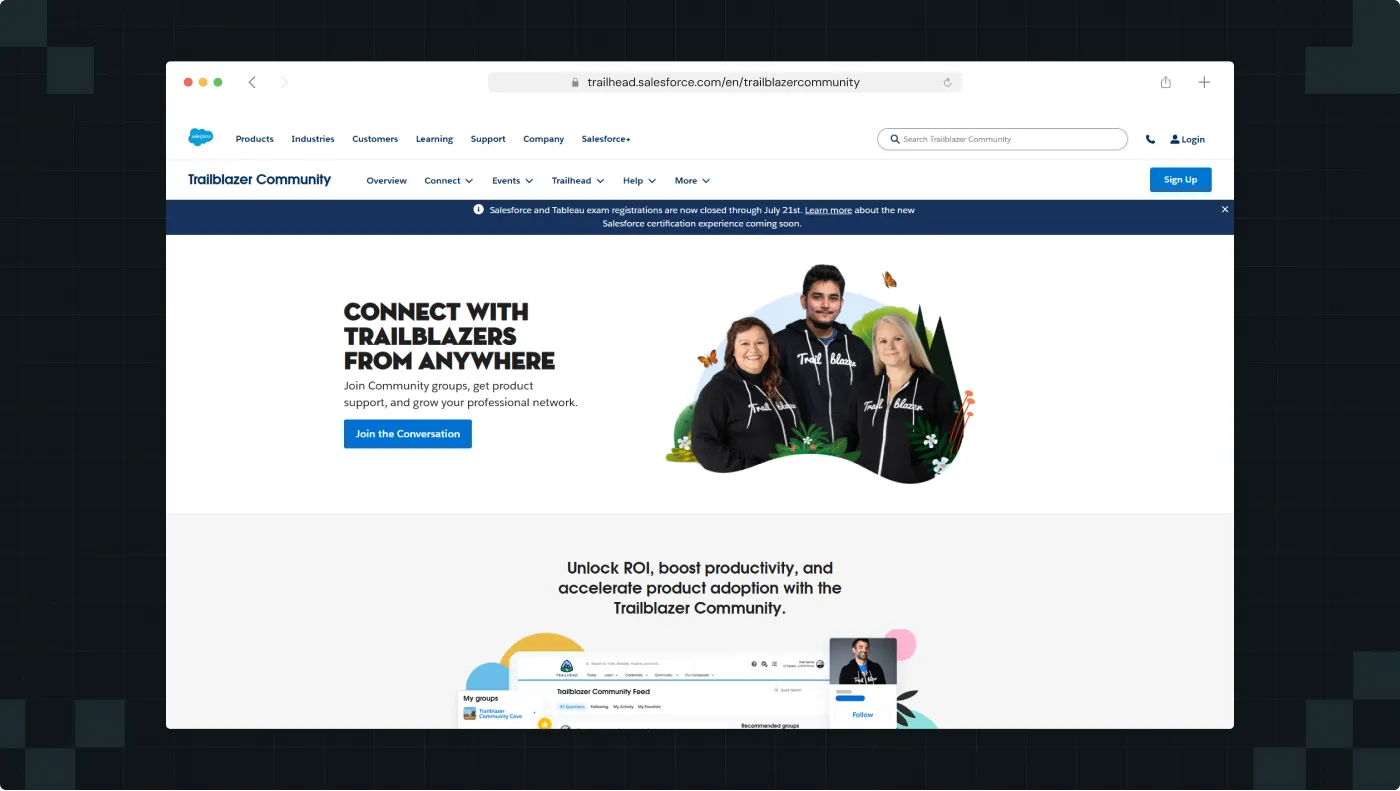
Source: https://trailhead.salesforce.com/en/trailblazercommunity
Salesforce's Trailblazer is a perfect example of this strategy. This community has over 5 million members who earn badges, attend local meetups, and help each other succeed with Salesforce. They've turned customer education into a movement. 80% of Trailblazers report that engaging in the Community helps extend their Salesforce capabilities, increase efficiency, and reduce costs.
What’s next
- Create certification programs that add value to customers' careers
- Host regular user conferences and local meetups
- Build online communities where customers can help each other
- Provide exclusive access and networking opportunities for advocates
{{specficBlog}}
5. Build your brand credibility through smart partnerships
Partner with companies that your target market already trusts. Strategic partnerships can instantly transfer credibility and provide access to new audiences.
Who’s already doing this well
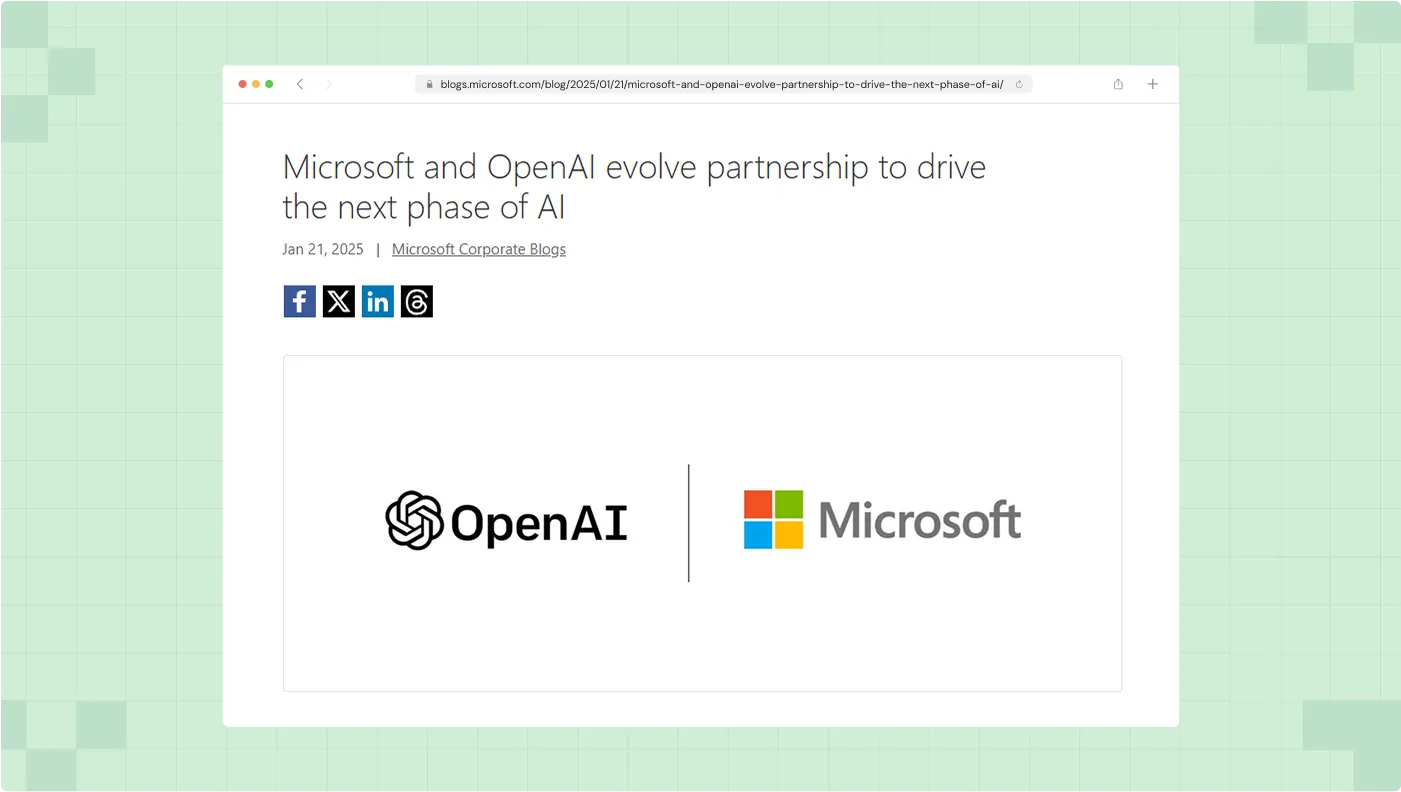
OpenAI's partnership with Microsoft didn't just provide funding and infrastructure—it gave OpenAI instant enterprise credibility. It transformed them from "interesting AI research company" to "enterprise-ready AI platform."
What’s next
- Partner with established players your customers already trust
- Co-create content and research with respected industry leaders
- Pursue integration partnerships with platforms your customers use
- Collaborate on joint marketing campaigns and events
How to measure B2B branding ROI?
Measuring the success of your B2B brand awareness strategy goes beyond vanity metrics. Here's what actually matters:
- LLM visibility: LLMs tend to recommend brands that appear frequently in their training data, essentially, the brands that have a strong online presence and industry recognition.
- Brand search volume: Monitor branded keyword searches and direct website traffic. Growing unprompted brand interest indicates your strategies are working.
- Share of voice: Measure your participation in industry conversations across social media, publications, and events. This shows whether your thought leadership efforts are gaining traction.
- Pipeline impact: Connect branding activities to actual deals by tracking brand-influenced leads, sales velocity, and deal size. This is where branding proves its revenue impact.
- Competitive positioning: Monitor win rates against specific competitors and pricing premiums you can command. Strong differentiation shows up in these metrics.
Speaking of ROI, if you're partnering with ThunderClap for your branding and web design, you can stay assured that you'll get a bang for your buck.
For example, we recently worked with ClearlyRated. They came to us wanting a website redesign. You'd think that would entail giving the site a new look, playing with colors and layouts, but we didn't stop there.
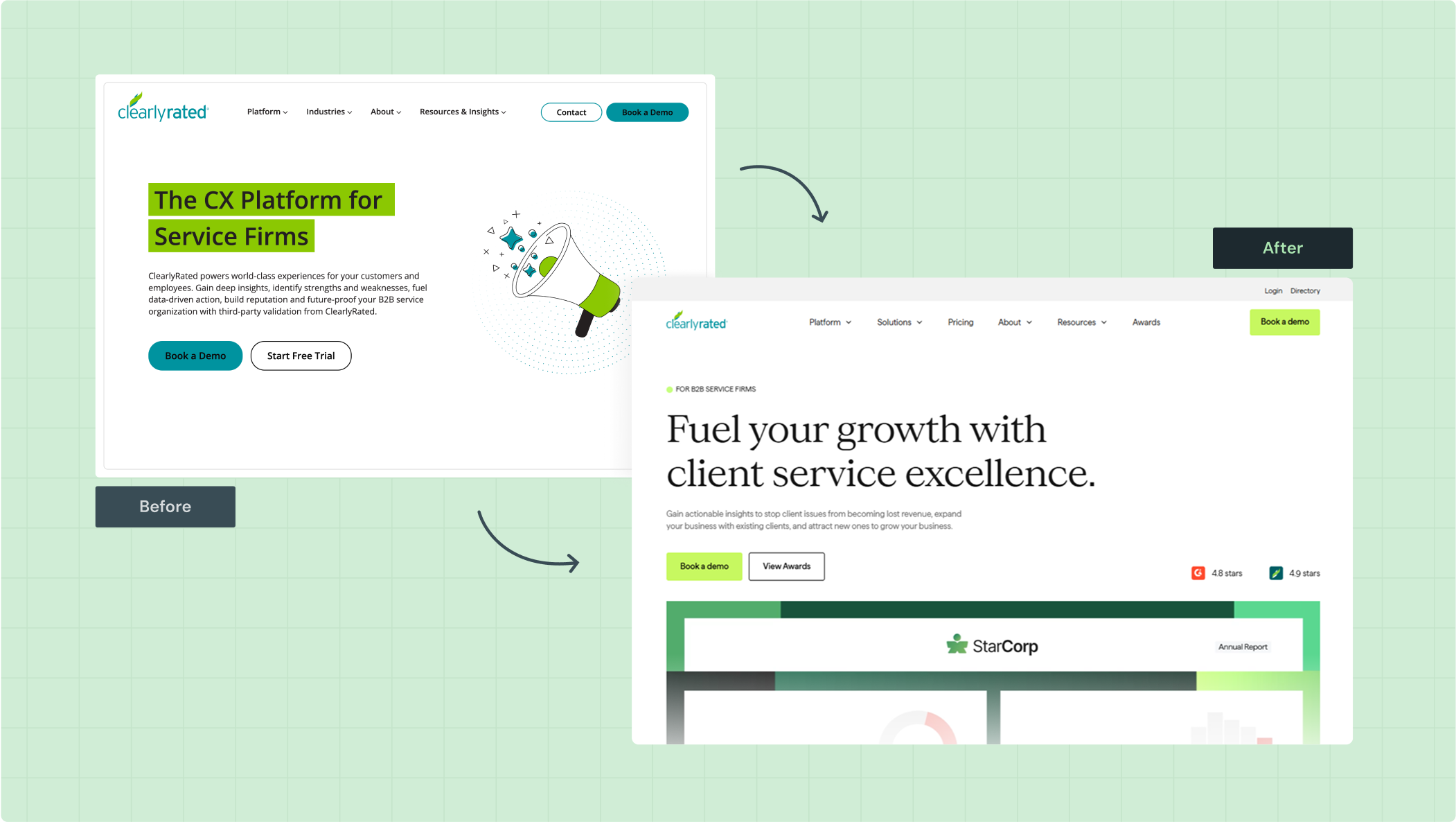
We spent time with their sales, marketing, and product teams. We helped them clarify their positioning and figure out what truly matters to their customers.
The whole thing took about eight weeks, and now they've got a site that works as hard as their sales team does.
If you're tired of websites that look pretty but don't drive results, let's talk. Book a call with us and we'll show you how strategic branding can transform your business.
Top B2B branding mistakes and how to fix them
Even with the best intentions, many B2B companies make critical branding errors that waste resources and confuse their market. Here are the most common mistakes and how to avoid them:
Partner with ThunderClap, an award-winnin
1. Treating branding as a cosmetic exercise
The biggest mistake B2B companies make is thinking branding equals a new logo, website redesign, or color palette refresh. This surface-level approach ignores the strategic foundation that makes brands truly powerful.
What this looks like:
- Spending months perfecting a visual identity while the messaging remains unclear
- Launching a "rebrand" that changes everything visually but nothing strategically
- Focusing on how you look instead of what you stand for
Why it fails: Visual identity without strategic positioning is just decoration. Your prospects care more about whether you understand their problems than whether your logo is trendy.
How to fix this: Start with strategy first. Define your positioning, value proposition, and differentiation before you touch any visual elements. Your brand identity should reflect your strategic positioning, not drive it.
2. Creating a false choice between brand and performance
Many B2B marketers get trapped in the "brand vs. performance" debate, believing they must choose between building long-term brand equity or driving immediate conversions.
What this looks like:
- "We can't measure brand impact, so let's focus only on lead generation."
- Cutting brand initiatives during budget tightening while doubling down on paid ads
- Running separate "brand" and "performance" campaigns that don't reinforce each other
Why it fails: You end up with the worst of both worlds—higher acquisition costs and lower customer lifetime value. Performance campaigns without brand context attract bargain hunters who choose based on price alone. These customers are expensive to acquire, quick to leave, and unlikely to refer others.
How to fix this: Integrate brand messaging into all performance campaigns. Every ad, email, and landing page should reinforce your positioning while driving conversions. Track both immediate and long-term impact.
3. Inconsistent brand experience across touchpoints
Your brand promise means nothing if it's not consistently delivered across every customer interaction, from marketing to sales to customer success.
What this looks like:
- Marketing promises one thing, sales says another, and customer success delivers something different
- Professional website but unprofessional sales materials
- Thought leadership content that doesn't align with actual product capabilities
Why it fails: Inconsistency breeds distrust. B2B buyers are already risk-averse, mixed messages make them even more cautious about choosing you.
How to fix this: Create brand guidelines that cover messaging, tone, and positioning across all departments. Regularly audit customer touchpoints to ensure consistency.
4. Playing it too safe with positioning
Many B2B companies choose generic positioning that offends no one but excites no one either. They end up blending into the competitive landscape instead of standing out.
What this looks like:
- Using industry buzzwords like "innovative," "scalable," or "best-in-class"
- Trying to appeal to everyone instead of owning a specific niche
- Avoiding controversial or opinionated stances on industry issues
Why it fails: Generic positioning makes you forgettable. When you sound like everyone else, prospects have no reason to choose you over competitors.
How to fix this: Take a clear position on what matters to your ideal customers. It's better to be loved by your target market and ignored by others than to be merely "acceptable" to everyone.
5. Expecting immediate results from brand investments
Branding is a long-term investment that compounds over time. Companies that expect quick wins often abandon effective strategies before they have time to work.
What this looks like:
- Launching thought leadership content and expecting immediate lead generation
- Changing brand strategy every quarter based on short-term performance
- Cutting brand budgets when they don't see immediate ROI
Why it fails: Brand equity builds gradually through consistent reinforcement. Strong brands become the "default choice" after months or years of consistent messaging and delivery.
How to fix this: Set realistic timelines for brand impact. Measure leading indicators like brand awareness, share of voice, and consideration alongside conversion metrics. Commit to consistent execution over at least 12-18 months.
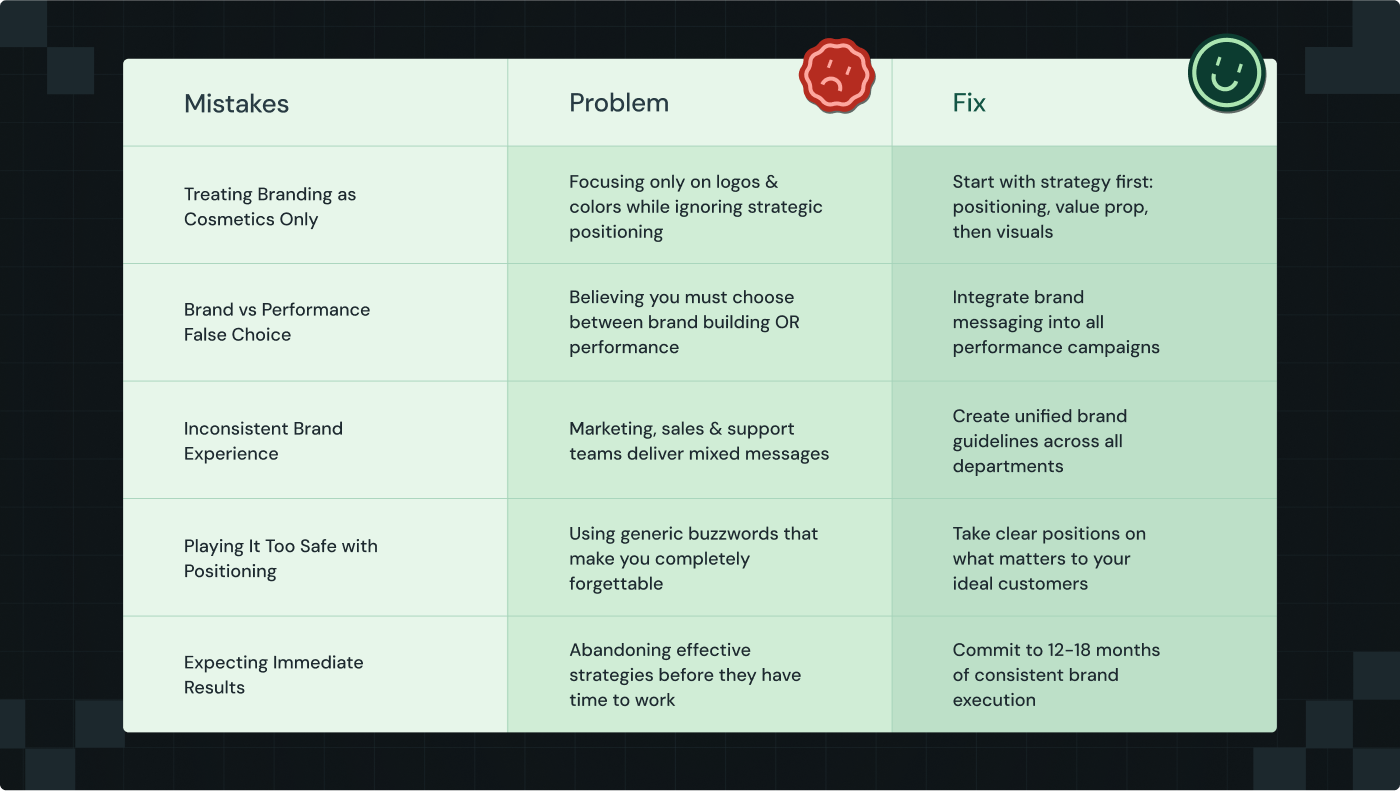
Need help executing your B2B brand strategy?
By now, you know everything there is to building winning b2b branding strategies. Let’s talk about execution!
If you’re starting with a website redesign to reflect your new positioning, you should know that it takes a village.
Think about it: you need conversion copywriters who understand B2B psychology, designers who can create compelling visuals that convert, developers who can build without breaking functionality, and strategists who can tie it all together cohesively.
That's where ThunderClap becomes your perfect execution partner.
We handle the entire brand-to-website transformation—from strategic messaging and conversion copywriting to design and Webflow development.
We’ve helped 129+ B2B brands like Amazon, Storylane, Razorpay, Z47, and ClearlyRated, transform their positioning into stunning websites that leave a lasting brand impression on every visitor.
Let us do the same for you. Book a demo with us today!
{{ctaBlock}}

Enterprise Web Design: Best Practices with Examples
Did you know that 29 percent of business is now conducted online in 2024? Enterprise web design is now the critical foundation for large-scale organizations looking to capture this growing market.
However, creating a worthwhile enterprise website isn’t simply about aesthetics. With over 80 percent of digital customers demanding more self-service options, your enterprise website must balance functionality, user experience, and conversion optimization. In fact, Bidnamic found that conversion rates increased 17 percent for every second a website loaded faster.
Enterprise websites differ significantly from small business sites. They serve a larger operational scale, manage more user data, and run more complex interactions that must integrate seamlessly with your CRM, ERP systems, and payment gateways. Additionally, with 47.8 percent of all website traffic coming from search, your enterprise web design strategy needs to accommodate substantial content volumes while maintaining performance.
Whether you’re working with an enterprise web design agency or considering Webflow enterprise web design services, this guide will walk you through proven best practices and outstanding examples that show what truly successful enterprise websites look like in action.
What Makes Enterprise Web Design Unique
Enterprise web design is a fundamentally different challenge compared to creating websites for smaller organizations. The distinction goes beyond mere size. It is about managing complexity at scale while delivering exceptional performance under demanding conditions.
Scale, complexity, and performance needs
Enterprise websites must handle higher traffic volumes than standard websites. When Amazon calculated that a one-second slowdown in page load time could cost them $16 billion in annual sales, it showed how critical performance becomes at enterprise scale. These sites process extensive data that require sophisticated optimization strategies.
Performance at the enterprise level isn’t just about faster servers.
As one industry expert notes, there are two approaches to solving performance problems:
“You could choose to increase the size of the gas tank, or you could improve the engine’s performance. Simply throwing more hardware at performance problems eventually reaches its limits. Instead, enterprise websites need efficiency improvements through caching methods, optimized loading techniques, and strategic bottleneck elimination.”
Furthermore, enterprise websites must scale reliably. They need to accommodate both steady growth and unexpected traffic spikes from widespread press attention or viral content. What might be manageable data collection at small scale often becomes overwhelming at high volume, necessitating integrated CRM systems and sophisticated content management solutions.
Differences from small business websites
Unlike small business websites, enterprise sites typically serve diverse audiences with varying needs. Consequently, they require more thoughtful information architecture to help users navigate efficiently. Poor structure on large sites leads to frustration, resulting in high bounce rates and lower engagement.
Security requirements also differ dramatically. Enterprise websites need multi-layered security protocols rather than standard measures. They must implement authentication methods like single sign-on (SSO) and two-factor authentication while ensuring SOC 2 compliance across five key requirements: security, availability, processing integrity, confidentiality, and privacy.
Notably, the level of customization and integration distinguishes enterprise websites. They must connect with various in-house and third-party applications, including:
- CRM and ERP systems
- Payment gateways and analytics
- Marketing automation software
- E-commerce platforms
Why strategy matters more at scale
Strategic planning becomes even more important for enterprise websites. According to a 2023 McKinsey study, nearly 66% of enterprise web development challenges result in project derailment due to underestimated technical complexity. Without crystal-clear objectives and thoroughly documented requirements, even skilled development teams struggle to deliver expected results.
The consequences of poor strategic planning at enterprise scale are severe. Features no one requested get built while critical functionality gets missed. Stakeholders become frustrated when deliverables don’t match expectations, and timelines stretch through endless cycles of rework.
A well-structured enterprise web design is built with scalability in mind with scope for expansion without requiring costly rebuilds.
5 Best Practices for Enterprise Web Design
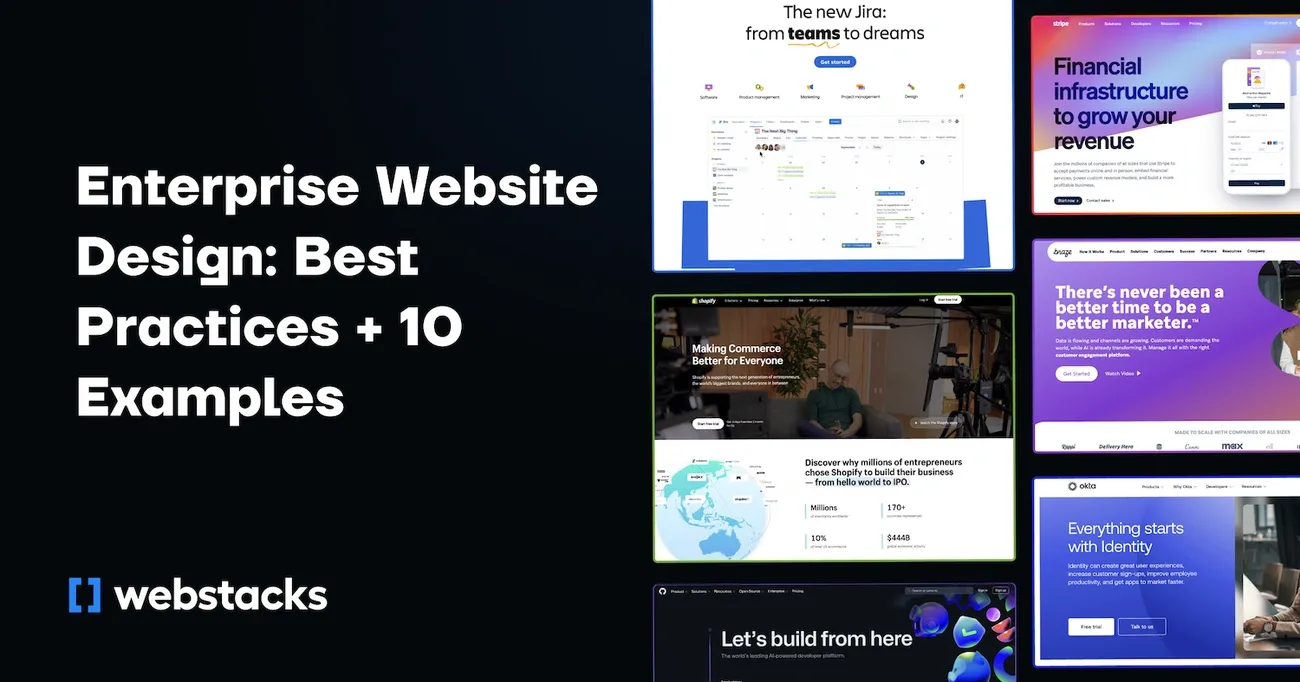
Image Source: Webstacks
“Design isn’t finished until somebody is using it.”
— Brenda Laurel, Designer, researcher, and pioneer in human-computer interaction
Successful enterprise websites don’t happen by accident. They result from design strategies that are tailor-made for the unique challenges of large organizations. Let’s explore the essential best practices of effective enterprise web design.
1. Build for scalability and future growth
Enterprise websites must grow alongside your business without requiring complete rebuilds. Initially, focus on infrastructure solutions like cloud hosting, load balancing, and auto-scaling server configurations to handle both steady growth and unexpected traffic spikes. A scalable architecture maintains performance during high-volume periods. So, your site remains responsive even as user numbers increase.
Shopify’s website is an excellent example of building for scalability. The structure and navigation are designed to grow without overwhelming the user. Shopify divides its offerings into clear categories such as ‘Start,’ ‘Sell,’ ‘Market,’ and ‘Manage, allowing users to choose as more features are added.
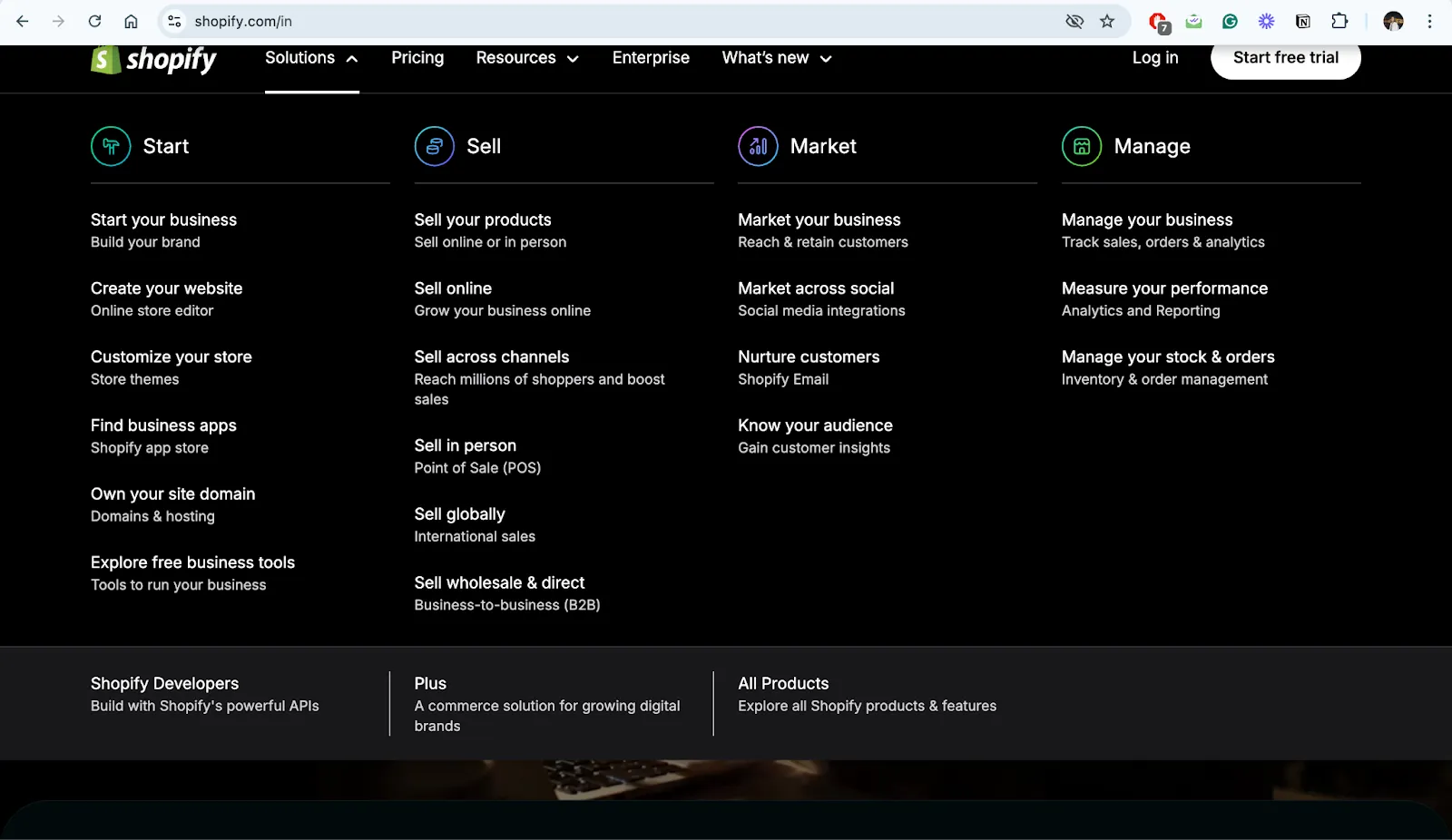
- Shopify’s site architecture is designed to accommodate new product features and expansions without disrupting user experience.
- The clean, categorized content helps Shopify scale, adding more services or updates without cluttering the user interface.
- Their flexible navigation system ensures scalability in content and product offerings.
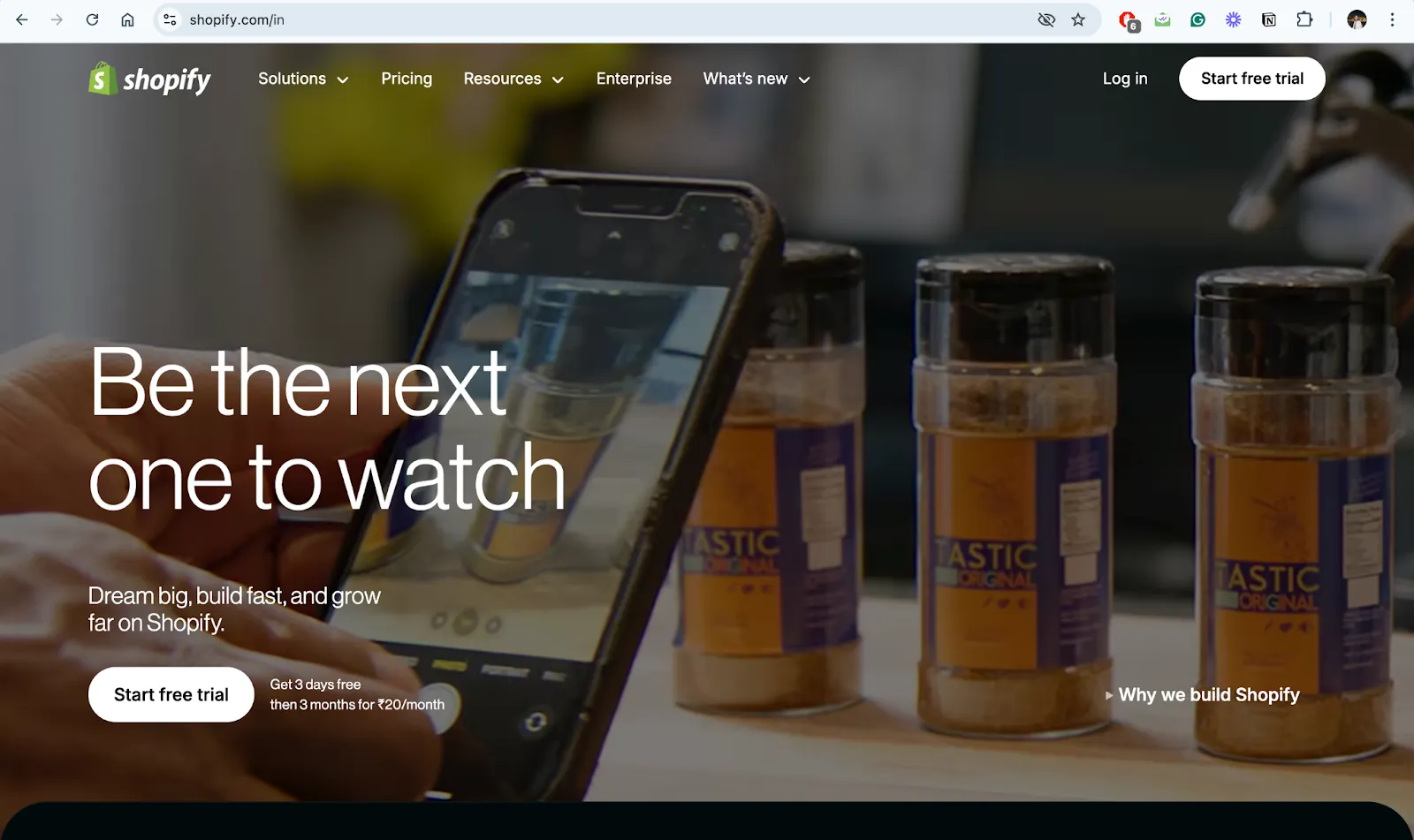
2. Create a clear and intuitive information architecture
Information architecture (IA) is the blueprint for your website’s organization. A well-structured IA helps users find what they need quickly, improving engagement and reducing frustration. Unlike sitemaps (which are just one component), comprehensive IA is an entire knowledge system that makes content findable. Your IA should include controlled vocabularies, taxonomies, and carefully planned navigation systems.
Atlassian’s website stands out for its well-structured content for different industries, team roles, and use cases, for a personalized user journey.
- The site uses a role-based navigation system (e.g., Product Manager, Developer, etc.), letting users find the solutions that best fit their needs.
- Clear headers and distinct sections for each product and solution so that users can find information with minimal effort.
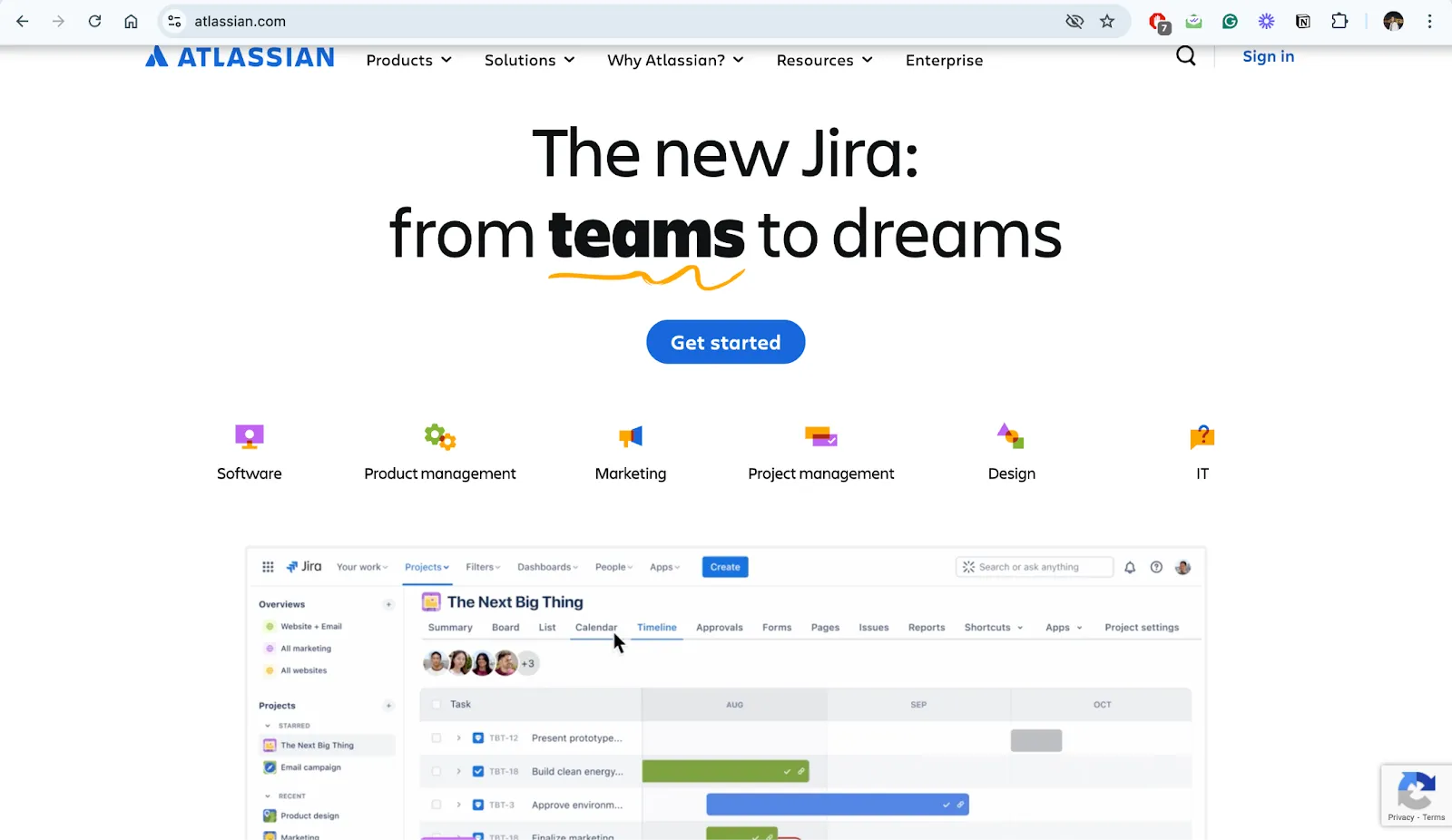
{{specficBlog}}
3. Use a consistent and flexible design system
A design system provides your organization with reusable components and standards that maintain brand consistency across all digital properties. This collection of pre-approved elements like buttons, layouts, typography rules, etc, allows teams to work without reinventing common elements. Maintain documentation for all components, patterns, and guidelines to support onboarding and consistent implementation.
GitHub has thrown the traditional rulebook out the window with their developer-focused design that feels more like a cool tech product than a business platform. Their website has dark mode, neon accents, and futuristic visuals that align with their coding audience. It’s like they’ve created an environment where developers feel right at home. GitHub’s approach teaches an important lesson: enterprise design can express creativity and personality, as long as it’s aligned with what your users actually want.
- GitHub’s website uses a consistent set of visual elements, including typography, color schemes, and iconography.
- The flexibility of the design system leaves space for new features without disrupting the overall aesthetic.
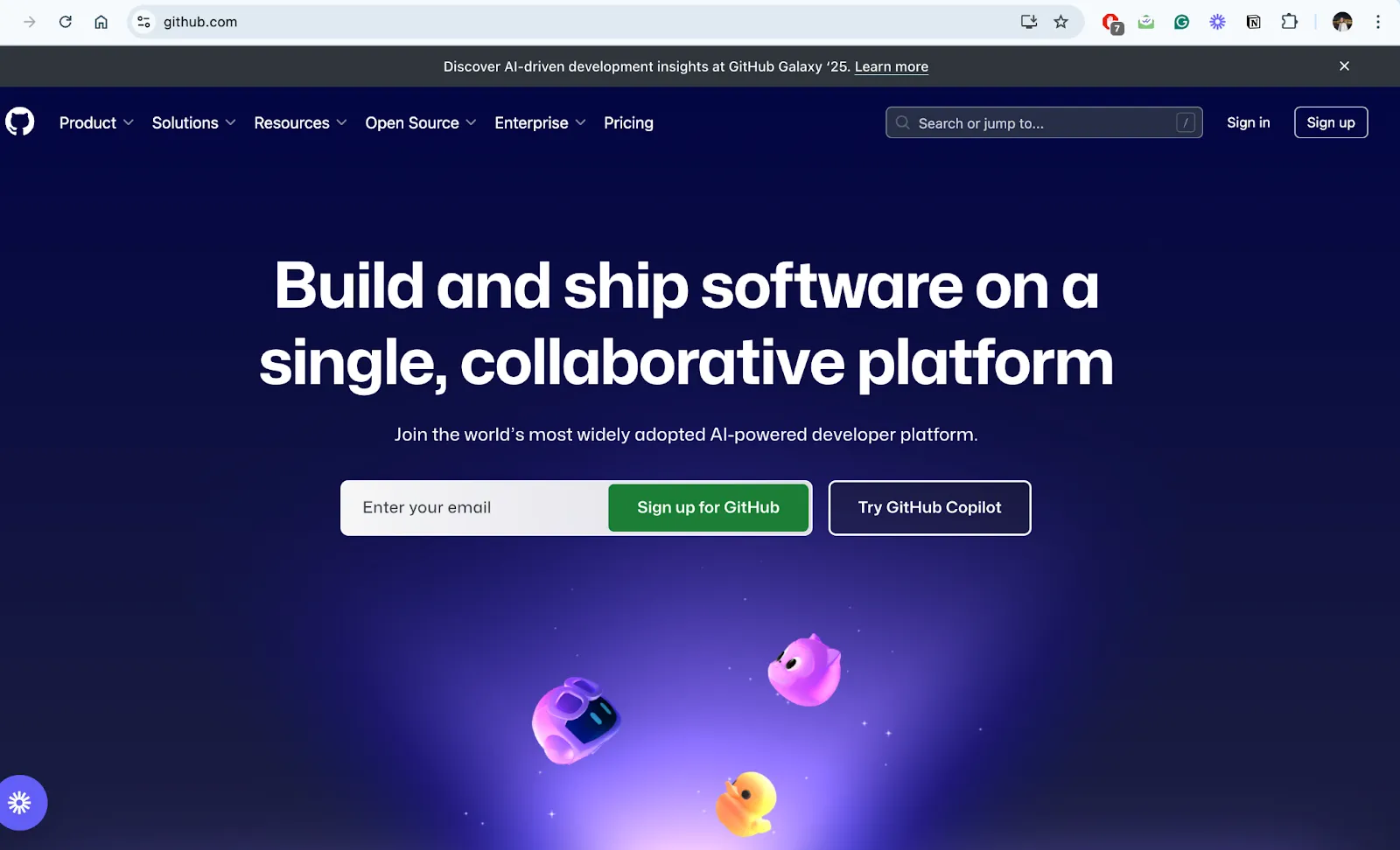
4. Optimize for mobile and responsive design
With over 60% of organic search visits now occurring on mobile devices, responsive design is mandatory. Your enterprise site must adapt to different screen sizes and devices. Prioritize mobile navigation, readability, and accessibility while ensuring fast loading times. Mobile optimization directly influences both user experience and search rankings. Utilize CSS grid layouts and size percentages to create layouts that adapt automatically to different screen dimensions.
Zendesk is a strong example of mobile optimization and responsive design. The website has user experience consistent across all devices.
- The website automatically adjusts to different screen sizes, maintaining usability on mobile.
- Mobile navigation is simplified, with easily tappable buttons and menus for interaction on smaller screens.

5. Focus on conversion and user engagement
Ultimately, your enterprise website must drive business outcomes through conversions. Implement A/B testing to compare different versions of web elements and determine which performs best. Simplify forms by reducing unnecessary fields and providing clear error messages. Simultaneously improve site speed, as faster-loading pages consistently show higher conversion rates. Personal touches like tailored content and recommendations based on user behavior can also increase engagement.
HubSpot is renowned for its focus on conversion optimization. The brand uses its website to drive conversions through clear CTAs, personalized content, and engaging user experiences.
- HubSpot’s site has multiple CTAs that guide users through the sales funnel, encouraging sign-ups, consultations, and more.
- It uses personalized content, such as resources and case studies, to engage enterprise users and convert them into leads.
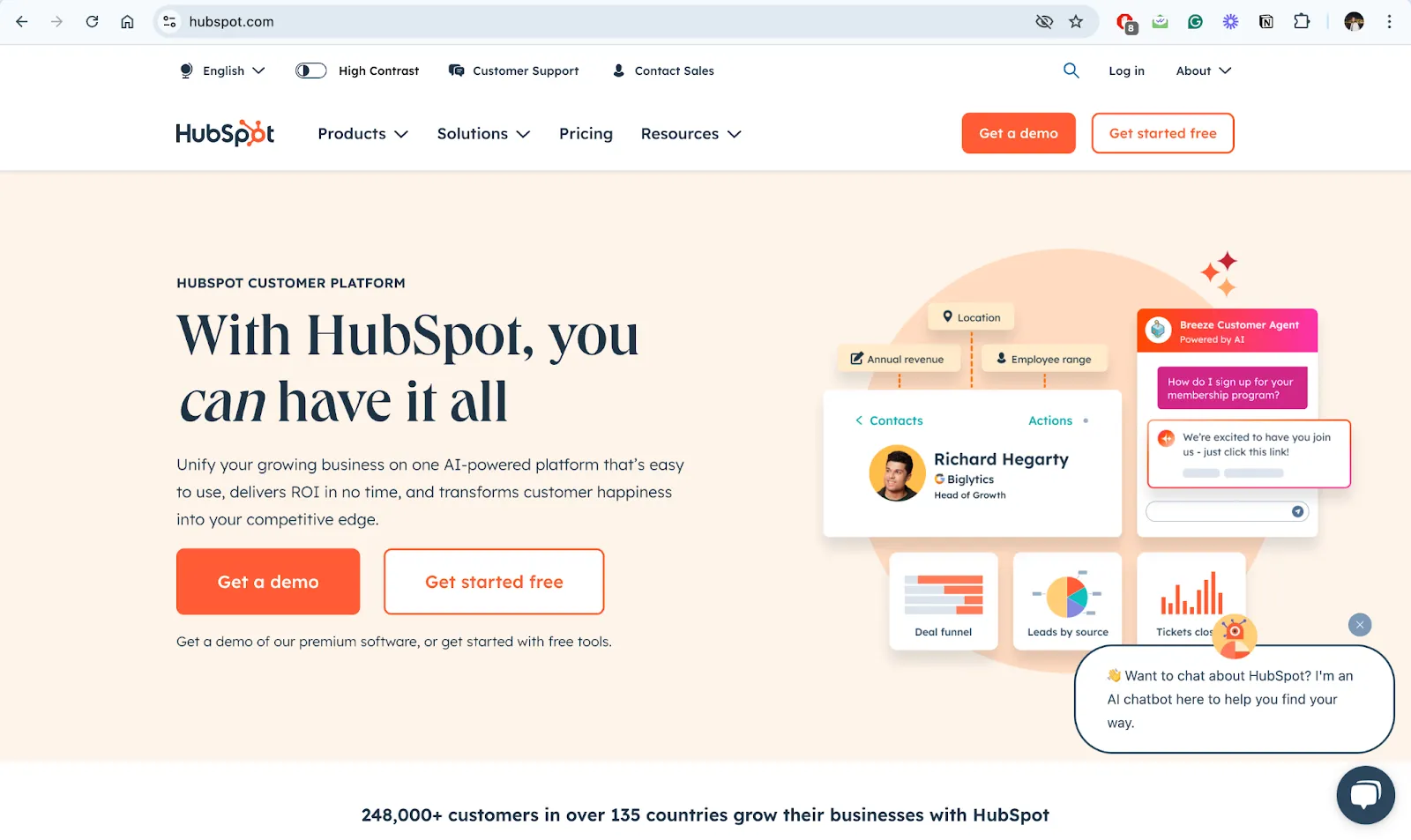
🤝See what Industry Experts have to say
“ThunderClap dove deep into the research for our product, from strategy to design and development, all with a sharp focus on CRO. We couldn't have asked for better partners.”
- Ankita Chaturvedi, GTM Lead, Shopline
{{ctaBlock}}
The Role of UX in Enterprise Websites
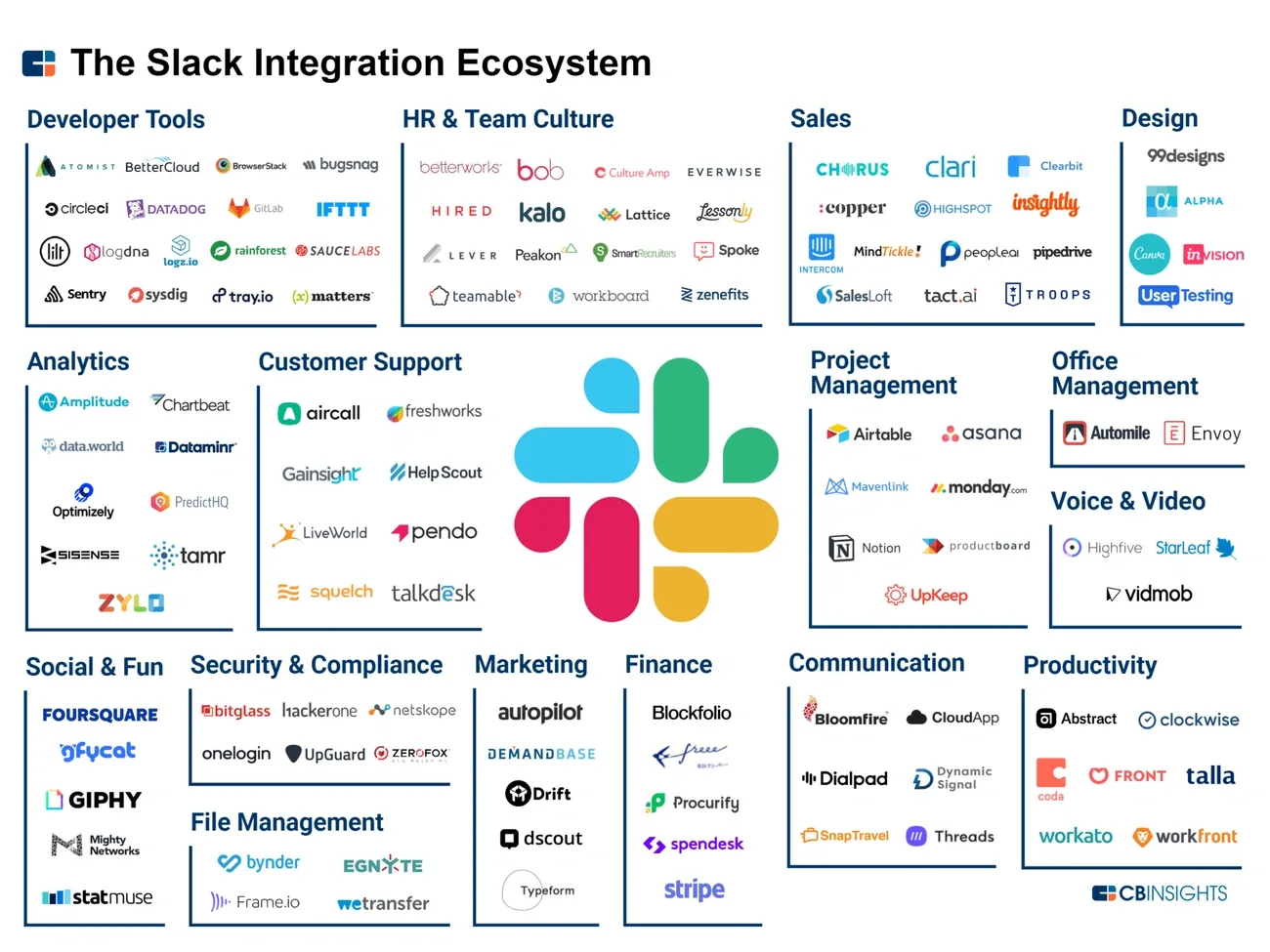
Image Source: Koru UX
“If we want users to like our software, we should design it to behave like a likable person: respectful, generous and helpful.”
- Alan Cooper, Software designer, ‘Father of Visual Basic’, author of ‘About Face’
Designing for multiple user types
Consider designing a tool that works equally well for engineers and HR managers with minimal technical skills. This multi-audience approach requires careful planning:
- Role-based personalization: Different departments need different interfaces displaying only relevant functions and information
- Proficiency adaptation: Interfaces must accommodate both power users and occasional visitors
- Context-specific workflows: Enterprise UX requires building specific onboarding paths for different roles and intended outcomes
Unlike consumer websites, enterprise platforms must bridge these needs without sacrificing usability for any group.
Balancing aesthetics with function
The relationship between visual appeal and usability is complex in enterprise contexts. Although the aesthetic-usability effect causes users to perceive attractive products as more usable, functionality remains paramount. Enterprise UX prioritizes regulations, data safety, and functional requirements over purely visual considerations.
Beyond mere appearances, enterprise UX must focus on productivity. While consumer UX shows enjoyment and simplicity, enterprise UX exists to boost productivity, reduce errors, and support business processes.
This balance requires thoughtful design decisions.
Reducing friction in user journeys
User friction is particularly damaging in enterprise contexts. Identifying these obstacles is challenging since only a small percentage of frustrated users actively report problems; most simply abandon the task.
- Session recordings that replay user interactions step-by-step
- Heatmaps showing areas of user activity and frustration
- User flow analysis identifying common paths and bottlenecks
Minimizing friction involves streamlining workflows and eliminating unnecessary steps. For enterprise platforms, this means providing intuitive navigation, consistent interface elements, and clear paths to completion.
Choosing the Right Enterprise Partner
The foundation of your enterprise website determines both its capabilities and limitations. Selecting the right webflow enterprise partner requires careful consideration of your needs.
Webflow Enterprise Partners empowers teams to visually build, manage, and optimize web experiences at scale. All backed by enterprise-grade security. Working with certified partners provides several advantages:
- Access to specialists who understand complex integration requirements
- Security protocols for protecting sensitive business data
- Scalable solutions that grow alongside your enterprise
- Expert implementation of time-saving automation workflows
A reliable tech stack created with qualified partners allows teams to focus on high-impact work instead of troubleshooting problems. Ultimately, as the 2023 Stack Overflow Developer Survey revealed, 63% of respondents spent at least 30 minutes daily troubleshooting issues. This time could be better invested in optimization and product development.
{{specficService}}
The Bottomline
Creating a successful enterprise website takes more than good looks. It needs to be fast, easy to use, mobile-friendly, and able to grow with your business. It should also work smoothly with your existing stack of CRM, ERP, and payment systems. When done right, your website becomes a lever that helps your business grow, serve customers better, and stand out from the competition.
Using best practices like clear navigation, strong design systems, and fast loading speeds can lead to more conversions, better user experiences, and stronger security. A smart strategy helps avoid costly mistakes and makes sure that your website is built to last.
From tracking how users behave to testing ways to improve conversions, CRO (conversion rate optimization) is key for B2B websites. Pick the right partner that matches your current needs, and use the selection tips we shared to make the best choice. But if this feels overwhelming, you don’t have to do it all yourself.
You can work with the leading website design agency, ThunderClap. We’re Webflow-approved and have helped B2B brands like ConsultAdd, CloudTech, and Storylane increase their conversions and grow online.
Want to see what we can do for you? Book a call with us today.


Interested in seeing what we can do for your website?














